IT'S TIME FOR BUBBLES IT'S TIME FOR BUBBLES
TRAVEL. GOURMET MOUNTAINS

TOUR: MIAMI TO MIAMI...
WORLD’S BEST PIZZA OUTSIDE OF ITALY
CHEF. FRANCESCA BARONE

TRAVEL. GOURMET MOUNTAINS

TOUR: MIAMI TO MIAMI...
WORLD’S BEST PIZZA OUTSIDE OF ITALY
CHEF. FRANCESCA BARONE


In the mountains learning about taste and sustainability in Alto Adige,between ski slopes and fine dining tables
Ski Weeks & Gourmet. Tables and Cellars around the slopes
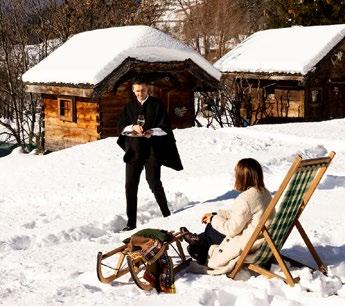

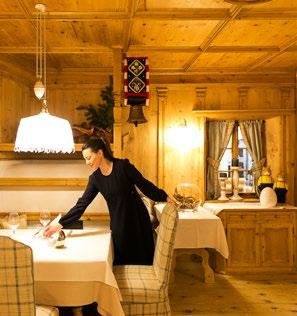
Chefs: Francesca Barone


Let’s toast to the new year by giving deserved attention to a great heritage of our country, bubbles. A continuously growing trend which, with +5.7% in total revenues and +7.5% in exports (Mediobanca data), drives the entire Italian wine sector. A success that is crossing the whole Peninsula from the historic areas for the production of sparkling wines to regions traditionally producing still wines but which are achieving excellent results in sparkling versions. Toasting an event or an anniversary with a glass of bubbly is a custom that is part of our DNA, but sparkling wines are now “seasonally” adapted. From the classic aperitivo to a pairing throughout the meal, consumption is constantly increasing; young people prefer Prosecco and restaurants have recorded a +31% in consumption since the post-pandemic reopening (TradeLab data). In the recently published Gambero Rosso, Vini d’Italia and Berebene guides, we have always given great space to all Italian wine expressions by recording the evolution, novelties and great confirmations. But Gambero Rosso is not limited to just this, in fact we pay the utmost attention to all tastes and flavours. For example, in the menus of fine dining restaurants, the phenomenon of zero-alcohol is constantly growing. Alcoholfree pairings are able to complete and enhance the sensations of the cuisine, a topic you will read more about in this first issue of 2023.
We also make a toast, with or without alcohol, to the winter season and the surge in tourism that is coming to our mountains. Winter sports have always been a passion of us Italians and the desire to return to living in the open air has increased after the lockdowns of recent years. Italy is full of beautiful landscapes and mountain areas and it’s our duty to support transversal tourism that also makes its products, cuisine and traditions known. Finally, let us remember that Italy must be ready for the finish line of the international appointment that will see us as protagonists in 2026: the Milan-Cortina Winter Olympics.
Warmest wishes to our readers from me and all my colleagues at Gambero Rosso for a profitable 2023 full of success for the Wine & Food Made in Italy.
Paolo Cuccia
In recent times, in Italy, barbecue and cooking on an open fire have been experiencing a renaissance, with meat as a key element. The way of consuming it has changed, with the increasingly widespread diffusion among producers and restaurateurs of the philosophy of Ethical Meat Eating, which promotes more responsible and sustainable consumption through some practices such as the use of cuts and parts of the animal unjustly considered less noble. The new rise of meat is also due to the development of an increasingly demanding clientele attentive to novelties, in search of quality meat with certified supply chains - there is a lot of attention to sustainability, with the search for restaurants that use animals bred in a natural way, respectful of the environment and their well-being – exotic and fine cuts, and authentic contexts that complete the experience.Here are the 7 establishments selected by Gambero Rosso and also reviewed in the new guide “Lombardia. The best of Milan and neighbouring provinces”.
– Maurizio Gaddi1 Varrone
Milano - varronerestaurant.com
2 El Carnicero
Milano - elcarnicero.com

3 Il Mannarino
Milano - ilmannarino.it 4
Francesca Cinelli Colombini (Modena 1931 – Montalcino 2022). Historical owner of Fattoria dei Barbi in Montalcino, mother of Donatella and Stefano Cinelli Colombini, also producers of wine in the land of Montalcino, she was a leading figure in the world of Italian wine and spearhead of the Movimento Turismo del Vino.
Luciano Sandrone (Barolo 1946 – Barolo 2023). He was one of the most important men in the recent history of Barolo. At the beginning
Cimitero Monumentale Varrone
Citylife
Il Mannarino
Milano Centrale
Parco Sempione
Parco Indro Montanelli
Duomo di Milano
El Porteño Macelleria Popolare
Navigli Arco di Porta Ticinese
4 Don Juan Milano - ristorantedonjuan.com
5 El Porteño Milano - elporteno.it4
6 Macelleria Popolare Milano - mangiaridistrada.com
of the 1980s he was among those who profoundly renewed Piemonte oenology who were referred to as “modernists.” It was he who attracted the attention of world critics to the Langhe: the international boom of Barolo thus began.
Antti Lukkari (1992 - 2023). The young Swedish chef died at the age of 29 due to a sudden complication suffered during the holidays between Christmas and New Year’s.
Piazzale Libia
El Carnicero Asina Luna
Don Juan
7 Asina Luna Peschiera Borromeo (MI) - asinaluna.it
8 The Brisket brisketmilano.com
9 Macelleria Motta Bellinzago Lombardo (MI) ristorantemacelleriamotta.it
He was the executive chef of Frantzen in Stockholm with a past at «Geranium» in Copenhagen, the best restaurant in the world 2022 according to The World’s 50 Best Restaurant
Angelo Onofri (1956 - 2022). A symbol for Champagne viticulture and a pioneer of biodynamics.
Erik De Sousa (1963 – 2023). A symbol for Champagne viticulture and a pioneer of biodynamics.
Sensitivity to the environment, ethical and animal-friendly choices and taking care of one’s health push a growing number of people to choose a more plantbased diet, with alternative proteins such as legumes and cereals to limit or eliminate altogether the consumption of meat. Here’s
where to eat vegetarian and vegan food in and around Rome. A list of Rome and the Best of Lazio 2023 Gambero Rosso guide, selecting the best tables in the Eternal City (and surroundings) that stand out for a mainly vegetable (and vegan) culinary offer.
–1 Rifugio Romano
Roma rifugioromano.com
2 Nativa
Roma nativa.superbexperience.com
3 Ops!
Cecilia BlenginoPianeta Verde Agriturismo
Ops!
Roma opsveg.com

4 Romeow Cat Bistrot
Roma romeowcatbistrot.com
5 Aromaticus Trastevere e Monti
Nativa
Aromaticus Monti
Colosseo
Vegan Store
L’ELEGANZA DEI POPCORN
Osteria vegGente
Roma
aromaticus-roma.com
6 Indigeno
Roma
FB: indigenoroma
7 Vegan Store
Roma mercatoditestaccio.it
8 Osteria vegGente
Marino (RM) osteria-veggente.it
9 Pianeta Verde Agriturismo
Montenero Sabino (RI) pianetaverdeagriturismo.it
IL PACKAGING
a cura di Michela Becchi
Popcorn gourmet? Esistono e vengono dalla Cina: si chiama The Perfect Pop ed è un’azienda che distribuisce su scala internazionale, dagli Stati Uniti all’Europa, vantando una selezione di oltre 20 gusti. Per valorizzare ancora di più il prodotto, il marchio si è affidato allo studio Auge/D per creare un packaging moderno fatto da tubi in cartone riciclabile dal design esclusivo ed elegantissimo. Non più uno snack da cinema, ma una vera chicca per amanti del gusto, perfetta anche da regalare grazie alla scatola bianca con strisce nere o dorate, che riporta in alto il simbolo dei popcorn. Curiosa l’idea degli elementi intercambiabili, tappi e barattoli da assemblare a piacere del cliente per confezioni sempre nuove e uniche.

Daniela Mastroberardino – wine producer from Campania born in 1968, CEO and Export Manager of Terredora di Montefusco (Avellino) – is the new leader of the Women of Wine: she takes the place of Donatella Cinelli Colombini and will lead the association, which has 1018 members, for the three-year period 2023-2025. Her watchwords for her mandate: «Training and Internationalisation.» The newly elected President says, in thanking Cinelli Colombini: «The path traced has become familiar to many of us... The future will have the hallmark of continuity, proposing the point of view of women in the “magic” world of wine in which we work: culture and promotion, training, presence on issues affecting the sector, internationalisation. I am sure that we will also have the ability to renew ourselves: there is no continuity without a pinch of discontinuity.»

Sparkling. 341 million bottles of Italian sparkling wine popped around the world between Christmas and New Year’s
Sparkling wines took the lion’s share during the holidays. 341 million bottles of Italian sparkling wine were uncorked between Christmas and New Year’s around the world, both in Italy (95 million) and abroad (projection source UIV-Ismea Observatory) which now absorbs 3/4 of total sales, testifying to a real Italian Sparkling wine fever. As already noted by the weekly Tre Bicchieri of Gambero Rosso, a new record is also reached from a production point of view which brings bubbles very close to the ceiling of one billion bottles (970 million), for a counter-value of 2.85 billion euros of which about 2 billion are in exports alone. Growth was driven by demand in the key markets of the United States, United Kingdom and Germany, but also in consolidated and emerging markets, such as Canada, Sweden, Japan, Eastern Europe and France, increasingly attracted by Italian bubbles (+25% growth by volume in Champagne country). Looking at the typologies, under the Christmas tree we had Prosecco (Doc, Conegliano and Colli Asolani) that plays the lion’s share, thanks to an impact on production that today has reached 70% of the sparkling wines bottled in Italy and a propensity to exports that make it the most marketed Italian agri-food product in the world, with a total estimated value for 2022 that exceeds 1.6 billion euros. Alongside the armored Prosecco advance, Trento Doc and Asti are also growing, Franciacorta is confirmed and hundreds of productions (or micro-productions) come forward to testify to the effervescence of the typology throughout the Italian peninsula: from the Oltrepò to the Alta Langa, to the Trebbiani al Verdicchio, from Moscati to Falanghine to Grechetti; from Malvasia to Grillo, from Nero d’Avola to Negroamaro to Durello, to Vermentini and many others. Designation of origin productions in 83% of cases (IGTs at 6%) which this year will mark a more contained growth compared to the last few years, but which consolidate their driving role in favour of the whole sector in a period certainly less brilliant for still wines.
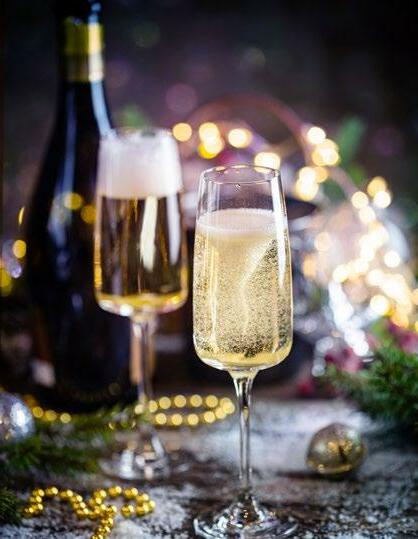


If there is a phenomenon in Italian wine that has really changed the cards on the table in markets around the world, it is certainly Prosecco, a success bouncing from one side to the other of the four corners of the globe and shows no sign of slowing down. The merit of this triumph can also, and above all, be traced back to the pioneer cellars which, since the 1950s, started the production of Prosecco Superiore on the steep hills of Conegliano-Valdobbiadene, making a proactive contribution to transforming a “local” bubbly into one of the world’s best-known and most popular sparkling wines.
The merit undoubtedly goes to the characteristics of the product: carefree, easy to drink, democratic prices. But digging a little deeper, we cannot fail to consider that this fame has been built over the years by the many producers who believed in the project.
Among these we must certainly include Santa Margherita. The winery, founded in 1935 in Fossalta di Portogruaro by Gaetano Marzotto, celebrated an important anniversary in 2022, a milestone that very few companies can boast. It was in
fact in 1952 when Santa Margherita, realising the potential of producing sparkling wine from the Glera grape and its chosen territory, the hills of Conegliano-Valdobbiadene, started the production of Prosecco Superiore.
The company did so following an intuition, ten years before the creation of the zone’s Producers’ Consortium and seventeen years before the first Production Regulations were published for the Prosecco DOC. In these first seven decades of success, the quest for excellence has never stopped and has been guided by the principles of craftsmanship, techno-oenological innovation and daily commitment to sustainability.

The path towards excellence has been articulated in changes and improvements both in the vineyard and in the production processes in the winery, all highlighting the quality of the Glera grape and of the hills of Conegliano-Valdobbiadene, recognized as a UNESCO World Heritage Site in 2019.
On the one hand, Santa Margherita consolidated its presence within the DOCG with the acquisition of vineyards at Refrontolo and at San Pietro di Feletto, in the strip of foothills between Conegliano and Valdobbiadene and with the inauguration, in 2011, of Tenuta di Refrontolo, situated in one of the 43 “Rive”, the exclusive sub-denominations that embody the finest distinctive local characteristics of Prosecco Superiore. This has allowed Santa Margherita to focus even more on the product and to highlight the many stylistic differences of this wine, which was running the risk - given its explosion as a fashionable phenomenon in recent years - of becoming trivialized.
In the long journey of Italian wine there is a reality that has always been able to read with great advance epochal changes and look audaciously to the future, anticipating the evolution of taste in Italy and around the world.
It did so in 1935 when it was founded by Count Gaetano Marzotto who started an agricultural and industrial hub as well as a new urban reality, Villanova di Fossalta di Portogruaro.
It did it also in 1961 by making his debut with the wine innovation “Pinot Grigio” and starting a real revolution of taste and oenological pleasure. It furthermore did it seventy years ago, in 1952, starting his own production of Prosecco Superiore on the hills of Conegliano-Valdobbiadene. And more recently, in 2017 with the inauguration of the bottling centre dedicated to Vittorio Emanuele Marzotto, which well represents the state of the art in winery technology. And again in 2019 when it started work on the restoration and recovery of the oldest urban vineyard in Venice located in San Francesco della Vigna.
88 years may have passed since that visionary beginning but the core values have remained unchanged and have allowed Count Gaetano Marzotto’s dream to grow and become one of the most important wine realities in Italy, a winery capable of keeping up with the times and read the changes in lifestyles and consumption thanks to the widespread presence in over 90 countries on five continents.
In addition to innovation, sustainability is a fundamental value for Santa Margherita, which has always been convinced that everything that comes from a healthy environment, conducted with wise measure in respect of life cycles, brings with it unique value.

On the other hand, the adoption of strict protocols in the vineyard and the use of avant-garde technology in the winery (which has always been state-of-the-art), have guaranteed total respect for the grapes and great consistency in the quality of production. Prosecco Superiore Santa Margherita is produced exclusively from grapes coming from the heart of the DOCG, an area that enjoys an excellent temperature range, thanks



Valdobbiadene Prosecco Superiore
52 Brut 2021
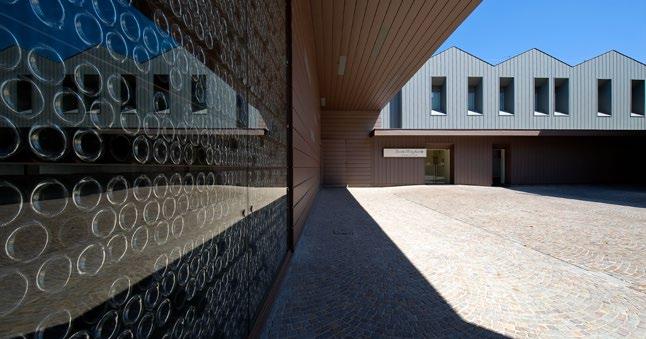


A Prosecco Superiore that conquers with its very fine perlage that conveys the aromatic intensity of fruit and yellow pulp anticipated by floral hints of peach and acacia. A Prosecco Superiore that looks to the origins and to the heroic viticulture that shaped the profile of the steep slopes of Conegliano-Valdobbiadene.
Valdobbiadene Prosecco Superiore
Rive di Refrontolo Extra Brut 2021


It is the interpretation of the Rive di Refrontolo sub-area of Santa Margherita, a precious wine, the result of the best oenological knowledge and tradition of sparkling wine, which expresses an elegant and at the same time solemn link with the territory. The brilliant straw yellow colour with greenish reflections is the prelude to a nose with aromas of peach blossom and acacia and white-fleshed fruit. On the palate it is tonic and fresh, sparkling and enveloping, with an extremely fine perlage that prolongs the richness of gustatory and aromatic sensations over time.
Valdobbiadene Prosecco Superiore Brut
The clean, pleasantly fruity bouquet, the soft and harmonious taste, the vibrant freshness and the extraordinary finesse of the perlage are the keys to the success of this icon-wine and express all the savoir faire of Santa Margherita: a seventy-year tradition made up of elegance, fine effervescence and very high quality.

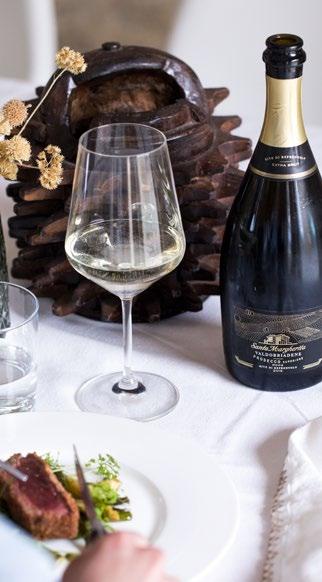
to its proximity to the Pre-Alps. The harvest, done manually, takes place with the use of small crates that prevent premature mashing. After the first fermentation in steel, the second fermentation, according to the Long Charmat Method, takes place in horizontal tanks which guarantee a greater contact surface between the yeasts and the wine for better effervescence.
The undisputed protagonist of this anniversary is the Valdobbiadene Prosecco Superiore Docg Brut 52, which owes its name not only to the year when it was first made sparkling, but also to the number of the finest plots of Glera vines selected to make the original cuvée. The proud flagship of the line of Vintage Prosecco Superiore wines under the Santa Margherita label, it is a precious wine, produced today exclusively from grapes coming from the Refrontolo estate, synonymous with the best oenological knowledge and tradition of sparkling wine.
Today, the success of Prosecco Superiore Santa Margherita goes far beyond national borders and conquers the palates of wine lovers from over

90 countries around the world with a broad range that offers delicious nuances of taste: from the more richly structured and complex Vintage versions Brut “52” and Extra Brut “Rive di Refrontolo,” to the more contemporary non-vintage Brut and Extra Dry, designed for a modern audience that likes to drink wine in contests that are not habitual or conventional, seeking a sparkler that is in line with their own lifestyle but which is nevertheless linked to tradition and faithfully expresses its terroir of origin.
Gaetano Marzotto, President of Santa Margherita Gruppo Vinicolo, underlines: «For Santa Margherita, Prosecco Superiore is not only an icon of the Italian lifestyle, capable of winning over new wine lovers everyday and opening the doors to new markets, but also a living testimony to our continuous spirit of innovation, an icon of craftsmanship and techno-enological progress, and a symbol of ongoing, tireless research, always aimed at tracing new paths of taste and vinous pleasure».
Santa Margherita – Fossalta di Portogruaro (VE) – via Ita Marzotto, 8 0421246111 – santamargherita.com
$santamargheritawines – fSanta Margherita Wines
FM 333: THREE TIMES PERFECT.



Bomporto (Modena)
www.cantinapaltrinieri.it average retail price: 13 euros
Lambrusco that are as true to the territory as possible. This requires choosing the right cru, and the appropriate winemaking approach - from secondfermentation in autoclaves to the ‘traditional method’ - for wines that exhibit notable personality and flavor, and that are always interesting, whatever the interpretation. Alberto Paltrinieri and his wife, Barbara, are the cornerstones of this historical winery based in Cristo di Sorbara, a family-run business where the level of craftsmanship, competence and passion demonstrated leads to extraordinary results. The vineyards grow in grass, in soils where a silty-sandy component dominates. Here between the Secchia and Panaro rivers, the unique microclimate proves perfect for Lambrusco di Sorbara, which the Paltrinieri family are outstanding interpreters of. All this was confirmed by our tastings. At the absolute top of the rankings is the Leclisse, a charmat method sorbara that stands out for its amazing palate and varietal, complex aromas of berries; in the mouth its high but well-gauged acidity and sapidity are the secrets to its elegance and harmony. The finish is sharp, and lively, with elegant tones of orange skin and dried roses. Low in color, very high in flavors: this is a truly gastronomic wines. It naturally calls a wide range of food specialties, try to pair it with a proper slice of culatello over a rustice slice of bread or go for a generous portion of homemade lasagna.
3 cl Blended Malt Scotch Whisky


2 cl Whisky Torbato
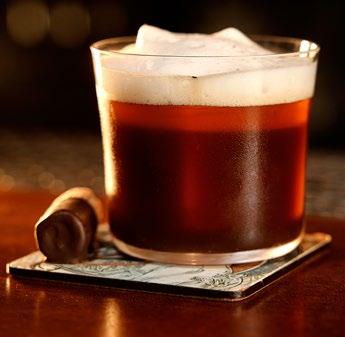
5 cl House Mix Malt Whisky (3 cl Speyside, 2 cl Islay)
1 cl Sherry Pedro Ximenez
1 cl Crème Cacao Brown
2 cl Caffè Espresso
Velluto di Frangelico (1/2 tsp Sucroestere, 1 cl Frangelico, 0,2 cl Vodka) Fava Tonka
Mr. Choconut is a cuddle designed for the coldest time of year. The blend of whiskeys gives the drink body and complexity, the coffee and chocolate add a pleasant mix of sweet and bitter. In the mouth the drink is warm, enveloping, with scents of hazelnut, vanilla, cinnamon, figs, cacao and smoke. The finish is clean, but long and persistent.
BARTENDER : Bar manager and sommelier, born in 1970, Tiziana Borreani began her career in the world of bars as a university student in Milan in the Nineties. After moving to Liguria, she and husband Paolo Baccino founded The Balance, a cocktail bar located in the Vecchia Darsena docks of Savona. She collaborated with Bartender. it for event planning. Since November 2022 she is the provincial Vice President of FIPE and has obtained the Order of Merit with the title of Consul of Italian Hospitality. Madly in love with Mexico and agave distillates, she considers herself an eternal student; her dream is to create her own training school.


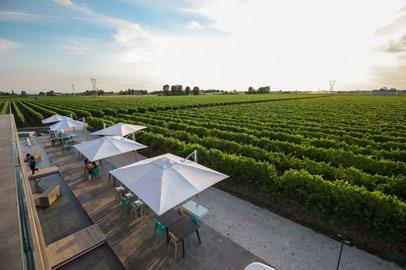

The young age of this Modena winery already shines through from the name: Ventiventi was born almost three years ago from the dream of entrepreneur Vittorio Razzaboni and his sons Riccardo, Andrea and Tommas o. A new reality, therefore, but with clear ideas, a trait d’union between tradition and innovation, technology and eco-conscious soul. Completely organic and eco-sustainable, Ventiventi looks at the important production history of the area to reinterpret it through a new gaze that goes from the Blanc de Blancs Classic Method to the Ancestral method with the Happy Selvaggio Lambrusco Emilia Igt; from Lambrusco Salamino to rosé and white Emilia Igt. Hence the decision to bring value to the native grapes: Sorbara, Salamino di Santa Croce, Pignoletto; but also international grape varieties such as Pinot blanc, Traminer, Cabernet sauvignon and Chardonnay. In total, the Ventiventi vineyards extend for 45 hectares in
Medolla, in the heart of Emilia-Romagna.
«We are a fundamental part of the wine we produce - explains the Razzaboni family - We have created the cellar exactly in the centre of our plots to feel enveloped by the land and its fruits.» Their welcoming spirit is all contained here, in the 900 square metre structure, surrounded by vineyards. «We have always had the idea of opening our gates, to offer a different and immersive experience. We are a very young winery, the world of wine is so vast and we wanted to take our space, creating a tasting area to convey and make our reality and our wines known, welcoming customers in a relaxing and pleasant setting between the greenery and the tranquillity of nature. We want to create a new wine culture, give the opportunity to make both our products and all the others in the area known. And we are strongly convinced that it is our wines that have to speak for us.» A whole series of projects,

Lambrusco di Modena Doc - Brut M.Cl

Onion skin colour, produced 100% with Lambrusco di Sorbara, this Classic Method Rosé represents the spearhead of the Ventiventi winery. It is characterised by incisive minerality balanced by soft creaminess and richness of refined varietal aromas. Aromas of berries, floral notes and hints of barley, given by the prolonged ageing on the lees. A sparkling wine that encapsulates a territory and a philosophy and which, thanks to the high clay content present in the soils (about 45%), is characterised by marked minerality and freshness, balanced by a good body and a good structure. Ideal to serve with delicate dishes and seafood, especially raw.

including educational, are born from this certainty, including the partnership with Astronave Lab Association , which last September involved young people with disabilities in the various stages of the winery’s harvest. Finally, there are many and varied tasting itineraries for enthusiasts. As a matter of fact, the Razzaboni family never misses an opportunity to share the aromas of its labels by organising events such as picnics in the vineyard, guided tours and special tastings. The scented notes, coming from eight different grape varieties, combine ancient and modern, nature and technology thanks to the work of a close-knit, young and constantly growing team.


20 pizzerias you should eat at in your lifetime. Here're all the 3 slices pizzerias around the world awarded in our Top Italian Restaurants 2023 guide
 words by Lorenzo Ruggeri
words by Lorenzo Ruggeri
The day will come when we will fly to Tokyo, Berlin or New York to eat a pizza that's far superior to what we know in our Italian cities of departure. We don't know how to pinpoint the date, but if the triple pace at which Italian pizza is growing around the world is confirmed in the coming decades, what described above could be something more than utopia. When we started our research on international pies, just 7 years ago, the scenario was completely different, with a few worthy establishments, concentrated in a handful of large cities. Today, the scenario is nothing short of competitive, rapidly evolving, with high-level pizzerias now present in all countries, even very distant ones, and not just
What a year, certainly one to remember. Carmine Candito, the talented Neapolitan pizza chef made a splash at Pizza Expo Las Vegas 2022, winning the first prize in the Neapolitan pizza section. At the same time, his second branch was also recently inaugurated in Coral Gables. The style of the pizzas is classic and traditional Neapolitan, meaning thick and airy crusts. The classic repertoire is excellent (Margherita, Sausage, and broccoli rabe and the Marinara), but there is room for gourmet digressions resulting from the inventiveness of the pizza maker, such as the Positano pizza, with mozzarella di bufala, piennolo cherry tomatoes, anchovy fillets, Gaeta olives and fresh basil. Drinks offered are beer and a small but valid selection of wines, with various proposals from Campania. Attentive and friendly service.


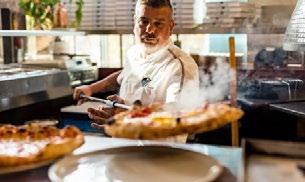
in the capitals we know, perhaps even just by name. The current trend is precisely to open in second and third tier cities, intercepting an increasingly hungry public for authentic Neapolitan pizzas, pinsa, pizzas served as different slices for a complete tasting journey. In pizzerias abroad guests are served great Italian wines, tasting delightful labels, in a very blurred border with the enoteca, the Italian wine shop. The ingredients are increasingly high quality, people are willing to pay much more without turning up their noses. Au contraire. Who knows what the future has in store for us, in the meantime we would like to point out a series of pizzerias that have risen to the top, for a more complete study we refer you to our digital guide Top Italian Restaurants.
This pizzeria is popular on the London scene where diners can rediscover the flavours of the city of origin. Tradition and high-quality ingredients manage to convey an excellent Neapolitan-style pizza. However, the success of this place is also due to a close-knit team and deep knowledge of pizza art. Crocchè and Montanare are an unmissable starter of the meal. Among the pizzas we recommend the Margherita with our eyes closed, a true signature pizza that bears the signature of Ciro Salvo and combines simplicity with a crazy tasty bite and the Nerano with zucchini cream, fior di latte, fried zucchini cubes, provolone del monaco and fresh mint.
Silvio Groppelli took over this lively gourmet pizzeria in the Surry Hills district a couple of years ago. Only precious, seasonal and quality ingredients, committed work on flours, long leavening times and good creativity. Pizzas already sliced into wedges arrive on the table, including the Margherita a modo nostro, the Messina and many gourmet pizzas that change regularly. The dough has a particular fragrance, the balance of flavours is of high standard. The wine list is growing in terms of quality and depth.
The double offer of Italian pizzas by the Salvo brothers quickly created a huge buzz, conquering the palate of customers in the Sanlitun district. The pizza art runs in the veins of the owners, in fact it is a family tradition that has been handed down from generation to generation since 1928. There are two branches that offer two different philosophies: at Forno the pizza is sold by the slice, while the Neapolitan style pies are the protagonists at Bottega. The latter restaurant, with an informal and lively atmosphere, was opened in 2014 to introduce an excellent pizza with a soft and fragrant crust. The classics are well executed, but for a more original bite we recommend the Primavera: bresaola cured beef, grilled asparagus, mozzarella, Parmigiano and extra virgin olive oil.

Luca Platania never stops. He is a Roman pizza maker with an enviable knowledge of pizza art, capable of ranging between different registers and visions. His latest project sees a double offer of pizzas. On one side pizza in teglia, typical of Rome, cooked in an electric oven; on the other the classic Neapolitan-inspired pie. Both benefit from a careful study and selection of ingredients for the production of the dough and a creative and well-balanced combination of flavours that can be perceived in every bite. We recommend the Double Crunch, with ham, zucchini, Parmigiano cream and fried zucchini; and the Margherita di Forza. Friendly and attentive service.


Awarded twice as Pizzeria of the Year in the Top Italian Restaurants guide, Futura is the project of Alessandro Leonardi and Alex Uhlman. The quality level has few rivals in Europe. The ambiance of the restaurant recalls typical Berlin atmosphere: sleek, refined, modern, with excellent friendly and attentive service. Excellent start with the three montanare (yellow, red and green), thanks to a perfect frying and the incisive and delicious toppings. The Corbarina is highly recommended, with tomatoes from Corbara, Fior di latte from Monti Lattari, Mozzarella di Bufala DOP, Pecorino Romano DOP, red onions from Tropea IGP, oregano, fresh basil: really tasty and satisfying. Don't miss the pizza alla pala baked in an electric oven, fragrant and with an out of the ordinary flavour, available in 5 classic versions. The wine selection is small but well-curated; the beer and cocktail list is equally impressive.
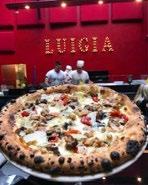

Opened in 2013, this pizzeria has conquered the Perdizes district by delighting the palate of its customers. Success is due to a careful choice of ingredients and respect for the Neapolitan tradition. The flours are imported as well as many of the ingredients used, such as the tomato and mozzarella which come directly from Campania. The pies are rigorously baked in a wood-burning oven as tradition dictates. Margherita, Capricciosa, Sausage and Broccoli rabe stand out on the menu, but we also recommend the Puglia with cherry tomatoes, black olives, Parmigiano, burrata and Puglia taralli. To conclude with a sweet bite, the pastiera and cannoli are excellent.
Enrico Coppola and Luigi Guarnaccia have successfully carried forward the project of bringing Italian cuisine to Dubai. At Luigia's, the menu draws heavily on typical recipes and traditional dishes, including pizza. The latter is truly well done, with particular attention to the selection of ingredients. The dough is soft and well leavened, an excellent base for tasty and fragrant pies. The classics alone are worth a stop here, but for the more demanding there are the special pizzas among which we recommend the Mulignana with aubergine cream, tomato sauce, fried aubergines, mozzarella di bufala, Grana Padano wafers and fresh basil. A curated and wide selection of Italian labels completes the offer.
Gianluca Legrottaglie had the merit of introducing the much appreciated Roman pinsa in the United States. Following the opening of the restaurant in San Francisco, success was such as to triple the number of branches with two new pizzerias opened in Portland and New York. The atmosphere is warm and welcoming, a perfect place to relax while savouring a bit of Roman tradition. The pinsas bear the name of the districts of Rome. The Montesacro pizza is convincing for its combination of flavours, with rosemary, potatoes, artichokes, sausage, mozzarella di bufala and spicy Calabrian chilli oil. The wine list is very accurate with references that come from artisanal producers from all over Europe. In closing, a good Maritozzo pastry filled with whipped cream is a worthy and delicious last bite before the bill.
One of the best pizzas that can be found in Europe, simply as that. Definitely a must for every pizza lover who reaches the shores of Lake Zurich. The credit goes to an all-Campania team, expertly led by talented Raffaele Tromiro, fourth generation of pizza makers. Long-leavened pizzas with raised edges and a melt-in-the-mouth bite. Do not miss the Calzone Napoli with tomato, mozzarella, salami, ricotta, and basil, the classic Margherita, the superb marinara or the ricotta stuffed crust Donna Carmela, with mozzarella di bufala and fresh cherry tomatoes. Interesting wine list, prices are undoubtedly in line with the Swiss standards. The other locations are keeping the same extremely high standards. Check the website for delivery and take away options, including the popular Neapolitan "pizza al portofoglio". The wine list has room of improvement.
NAPULÈ IS OUR PIZZERIA OF THE YEAR IN OUR TOP ITALIAN RESTAURANTS 2023.

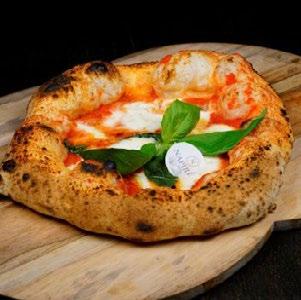

More than a passion, what Vincenzo Onnembo is about is a tireless, continuous research and desire to improve. With his restaurant he introduced Neapolitan tradition to the city of Amsterdam, immediately experiencing net success. He didn't just stop at pizzas, he developed a line of frozen pizzas and imported pizza al portafoglio, Neapolitan street food par excellence. The pizza dough is light, airy, topped with quality ingredients that also hail from the local cuisine. To start, take a "mortazza montanara" and continue with the Oro di Bufala pizza, topped with yellow cherry tomato sauce, mozzarella di bufala, provolone del monaco and basil, you won't regret it.
Giuseppe Cutaro continues to be a certainty in the Parisian pizzeria scene. Originally from the Naples Spanish Quarters, as a pizza maker he had come to the fore by collaborating with the Big Mama group. In Paris, he has opened a branch in the twentieth arrondissement that offers a contemporary version of Neapolitanstyle pizza, with a nice high, honeycombed crust. Ordering a Neapolitan "cuoppo" paper cone filled with fried morsels is certainly an excellent choice to start with, while for pizzas we recommend a Lady Emilia, with ricotta, smoked fior di latte, mortadella, pesto and crumbled pistachios. The wine list is good with a fine selection of labels.
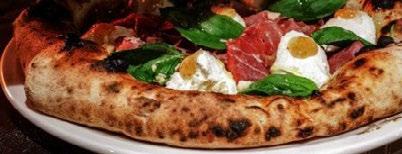
Naples is also found in Tokyo, thanks to Peppe Ericchello's restaurant. More than a pizzeria, this is a place where you can taste traditional Neapolitan dishes in Japan. The success of this entrepreneur is found in high-level cuisine that includes a careful selection of ingredients and an incomparable technique in obtaining a light and fragrant dough, with good air pockets and baked to perfection as tradition dictates. We recommend trying the Generale, with fior di latte, chopped pistachios, mortadella julienne, black pepper, and fresh basil. Simple, but very tasty.
Authentic Pizza Napoletana. When it comes to baking true neapolitanpizza, Pasquale Illiano knows that the secret is choosing the best ingredients. He imports some of the best ingredients from his native region, Campania, and uses all his knowledge gained working in the restaurants of the Bay of Naples to deliver a pizza that you could find in some of the best pizzerias in the city of Naples. Start with an imported buffalo mozzarella and Parma prosciutto, then order a Salsiccia e friarelli Broccoli rabe, sausage, fior di latte or the unmissable margherita. Before asking for the check, indulge in homemade gelato to sweeten the end of the meal. Many recipes of the Neapolitan tradition are also available. Informal and welcoming service.


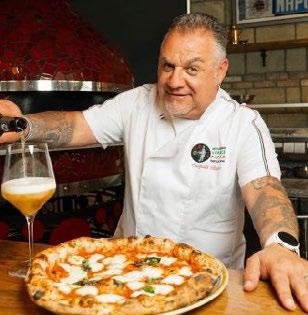
During the glorious European football Championship, Ribalta transformed into a true soccer stadium, embracing the whole area with its enthusiasm in the final stages of the tournament. The volcanic Rosario Procino and expert pizza maker Pasquale Cozzolino have built a winning pizzeria that combines high yield and quality in the dough. The Margherita Doc is perfect in its classic register, well flattened and baked, optimal distribution and quantity and distribution of ingredients and perfect final balance in a very pleasant bite. From the kitchen we recommend an unmissable Gragnano spaghetti with Piennolo tomato that's prepared to perfection. Professional service and an extensive wine list.
From farm to pizza. An intriguing claim of this pizzeria which is only a walk away from the Sagrada Familia. After a career and building up experiences in important restaurants of Spain, Rafa Panatieri and Jorge Sastre decided to open their pizzeria. Local, seasonal ingredients, bought by farmers or directly grown near the venue, and imported raw materials are used to deliver a glimpse of one of Italy's most famous dishes. We found that the discs were cooked perfectly. A fragrant and soft bite that resembled the pizza of the city of Naples. The classic Margherita was delicious, but try the one with Cantabrian anchovies, kalamata olives, tomato, and escarole. Before the check, a classic Tiramisù is the right way to end the dining experience.

Where nature, sustainability, art and hospitality are inextricably linked. A small paradise, an authentic place in Torgiano, in the green heart of Italy, Umbria.
 TORGIANO ORGANIC WINE
TORGIANO ORGANIC WINE
One of the best Neapolitan style pizzerias outside of Campania (region of which Naples is the capital). Behind the success of this place is the signature and ability of Ciro Iovine who with determination has proven capable of an ambitious project. Awarded in 2019 as Pizzeria of the Year by our Top Italian Restaurants guide, Song 'e Napule is a piece of Naples in the heart of Manhattan. The ingredients stand out for their high quality and the dough is baked to perfection as tradition dictates. Even the classic Margherita seems to have something extra, but the sausage and broccoli rabe, or the classic calzone with mozzarella, salami, ricotta and tomato sauce are no less. A stop not to miss when in the Big Apple.
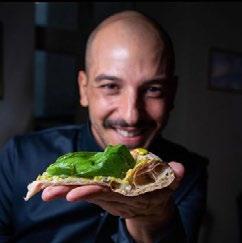


In the prestigious location of the Mandarin Oriental in Tokyo on the thirty-eighth floor, this exclusive and popular pizzeria combines tradition with a luxurious and elegant environment. A total of eight seats in front of an imposing marble counter that separates the team of pizza chefs from customers. Daniele Cason is the man who pulls excellent pizzas with a crisp and tasty bite out of the wood-fired oven. The ingredients that top the pies are selected and directly imported from Italy. The Pizzino is rich and delicious, topped with mascarpone, black olives and black truffle. Excellent selection of wines and the proposal by the glass..

With his irrepressible and tireless personality, Jonathan Goldsmith has never stopped, not even in this period of great uncertainty. Strengthened by his passion for Neapolitan pizza art, he continued to promote Neapolitan-style pizza. Forged in the kitchens of renowned artisans such as Enzo Coccia, he brought Neapolitan pizza to his country of origin, the United States. On our visit we were pleasantly impressed by the sausage and broccoli rabe, and the tasty imported burrata. Continuing the tasting we opted for a classic Margherita and an Enzo with smoked mozzarella, Corbarino tomatoes, ricotta di bufala, rocket and grated parmigiano. The pizza dough is airy, light, with nice air pockets and excellent digestibility. The wine list is a small jewel box of Campania labels (some difficult to find) offered at honest prices.
Wine and pizza, these are the two protagonists of Francesco Calò's restaurant. As for the pies, the name suggests the typology: of clear Neapolitan style with a high and honeycombed crust, they have conquered the palate and the heart of Vienna in a short time. Alongside the timeless classics such as Margherita or Capricciosa, the "Master creations" are morsels with bold, yet balanced and surprising combinations. The pizza profumata is an example: mozzarella di bufala, lemon ricotta, yellow cherry tomatoes and a lemon vinaigrette give freshness and flavour to each bite. We point out an impeccable wine list with many carefully selected labels.
Song' e Napule - New York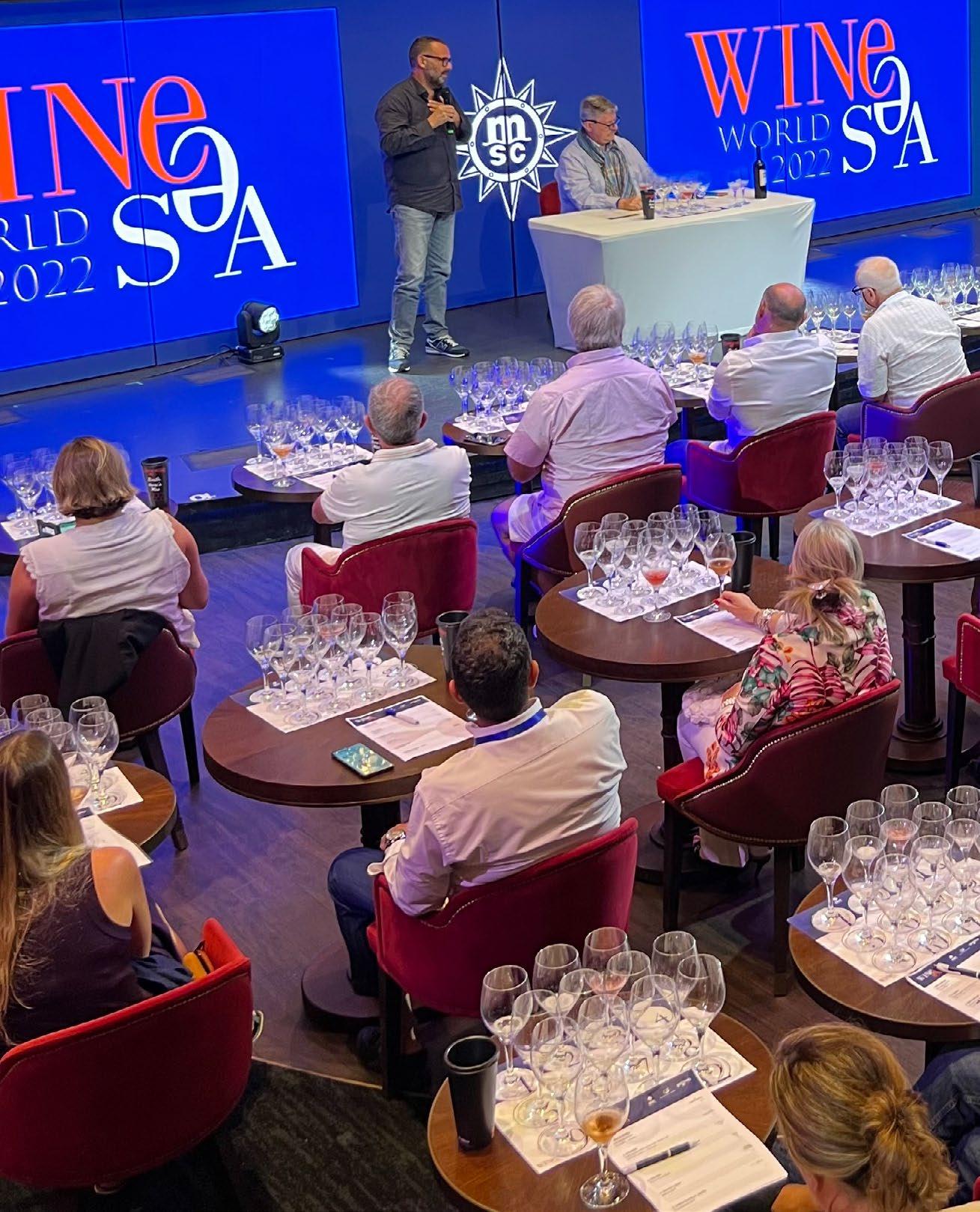
Wine and Sea has just ended, the innovative “wine-themed navigation” formula developed by Gambero Rosso for MSC, which stopped off in some of the most beautiful islands in the Caribbean. On board were masterclasses, tastings, insights on neuro-marketing, with final vote. Ending in Florida with a walk around tasting

The ingredients were all present for a success story: Gambero Rosso and its tried and tested international team; some of the best Italian wineries with their top wines; the MSC flagship, the ultra-modern and eco-friendly Seashore fresh from its maiden voyage; and a fantastic itinerary starting from Miami and touching some of the most beautiful islands in the Caribbean.
The fourth edition of the Wine and Sea cruise left Miami on November 13th and on the 14th it touched the Ocean Cay marine reserve in the Bahamas, where the first wine event was held dedicated to cruise passengers,
who has the opportunity to familiarise with the great Italian white and sparkling wines, served chilled in the shade of palm trees on one of the most beautiful islands of the archipelago, a natural oasis with white beaches immersed in the crystalline waters of the ocean, owned and managed by MSC Lines. In the following days, San Juan de Puerto Rico, Charlotte Amalie in the American Virgin Islands, Puerto Plata in the Dominican Republic were also on the itinerary, before returning to Miami.
The program saw a series of very popular wine tastings on the cruise ship, set in the vessel’s most beautiful locations, such as the Pool Party by the swimming pool, or in the large com-
The tasting counter dedicated to Custoza aroused great interest during the Italian Wines event in Miami on November 21st, a beautiful “Preview” of the Vini d’Italia 2023 Guide. For the enthusiasts present, who already knew it from previous events, this Venetian wine was truly appreciated…

Custoza is a territory of rolling morainic hills that unite Verona to Lake Garda, and includes the municipalities of Sommacampagna, Sona, Valeggio sul Mincio, Villafranca di Verona, Lazise, Peschiera del Garda, Castelnuovo del Garda, Bussolengo and Pastrengo. All dotted with beautiful vineyards of over 1,400 hectares. Custoza Doc comes from a blend of Trebbiano Toscano (from 10% to 45%), Garganega (from 20% to 40%) and Trebbianello (also known as Friulano or Sauvignonnasse, from 5% to 30%) grapes. But Cortese (also called Bianca Fernanda, up to 30%), Malvasia, Incrocio Manzoni Bianco, Riesling Italico (or Welschriesling), Pinot Bianco and Chardonnay (up to a maximum of 30%, alone or blended) are also used. Today the production exceeds 13 million bottles, successfully sold all over the world. Custoza is a fragrant white, which goes wonderfully well with the seafood-based cuisine of the Mediterranean as well as the rest of the world.

“The thing that fascinates me about Custoza,” Rob Shakespeare, a Miami wine lover told us, “is that it can be an excellent sparkling wine, a fresh white with a youthful edge, but I have tasted important interpretations of it, just like a great white wine that evolves over time. Excellent!”
mon areas, which culminated in the great free tasting on one of the main decks with all the wineries’ labels participants, at the end of which over 400 cruise passengers voted for their favourite wines.
Specifically, Gambero Rosso studied a unique formula that included guided tastings and master classes for the most curious and attentive enthusiasts - led by Marco Sabellico, the historic signature of Gambero Rosso - with more playful moments for Seashore passengers, plus more.
The great novelty of this edition was the opportunity for winery owners and representatives to participate in a very interesting study of Neuro-marketing of
Wine in two Master classes held by Professor Vincenzo Russo, docent at IULM and for the communication masters at Gambero Rosso, as well as columnist of the weekly Tre Bicchieri, dwelling on topics surrounding wine packaging and sales techniques.
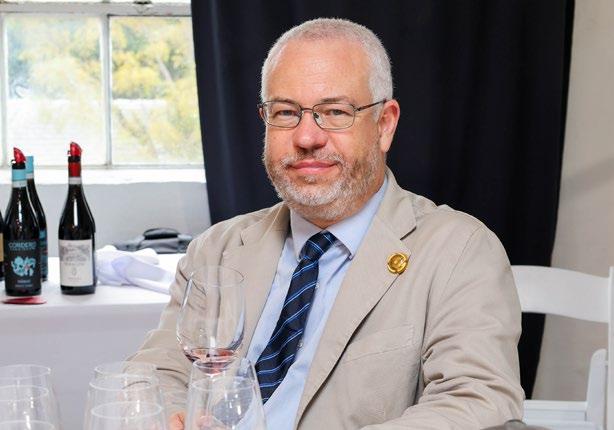

For us producers it is a unique opportunity to get in touch with an international public that’s sensitive to wine” said Federica Morricone, owner of Villa Medoro in Abruzzo, who has spent these days focussing on oenological appointments and relaxation with her family
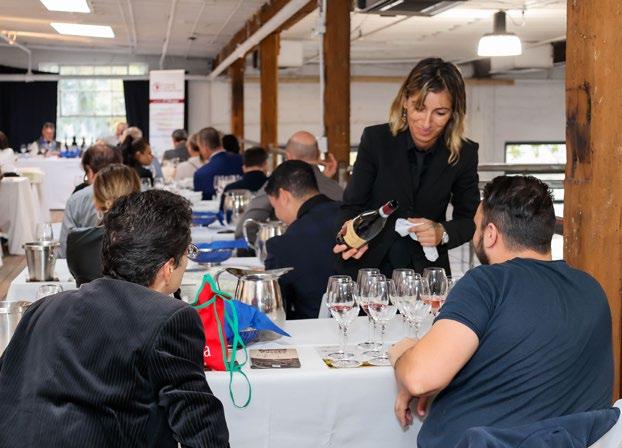
“A cruise ship like this one, with 5,000 people on board plus crew, is a perfect sample of the international market.”
“A perfectly fitting formula,” commented Fabio Cascione of Varvaglione 1921 “we were able to do team building, promotion and have moments of important professional insight... all whilst visiting some of the most beautiful places in the world.”
People like Italian wine, as demonstrated by the hundreds of passengers who crowded the master classes in the on-board theatre, where wines from all the participating wineries were served. The wine service in each event was managed by a very close team of AIS sommeliers from the Puglia region, who guaranteed the perfect success of each event with extraordinary timing and professional approach, whether they were in shorts and an informal t-shirt on the beaches, or in their institutional uniform on board the ship.
At the end of voting on the last day, cruise passengers made it possible to draw up a ranking which saw Apollonio’s Copertino Divoto Riserva ‘12
In Miami, the Oltrepò Pavese, in addition to a corner, was also the protagonist of a very popular master class held by Carlo Veronese, Director of the Consortium, and Marco Sabellico, during which terroirs, wines, styles and trends of this great Lombard denomination were explored.
“The quality of the Oltrepò Pinot Noirs is surprising, both in the classic method version and in the great red wine version,” said sommelier Allen Wilkins “but the surprise was that Oltrepò has much more to offer, from the great Rieslings to full-bodied reds perfect for roasted meats such as Buttafuoco… A wonderful discovery! It will be my next wine stop in Italy.”
SEPTEMBER









prevail among the reds, Roxanne Bianco from Tenuta il Palagio 1530 (the owner is Sting) among the whites, for the Rosés, Contessa Filomarino Rosato ‘21 from Tenute Girolamo, and finally Valdobbiadene Prosecco Superiore Brut from Sorelle Bronca, closely followed by Valdobbiadene Brut Brunei from La Tordera. Lastly, Sorelle Bronca was the most voted winery in this edition of Wine & Sea, and in addition to this recognition, it was awarded a supply contract for the entire MSC fleet for six months.
“It was a wonderful, useful, fun and engaging week” confessed Elisa Piazza, of the owner family of the winery, as well as an oenologist of the same. “It was very interesting and stimulating to taste the wines of colleagues, talk with consumers, and learn new things in the master classes. Not only that: I’m going home with an important result in terms of prestige and great commercial relevance! An experience that begs to be repeated, for sure…” The formula that combines promotion, relaxation and professional development was very popular, and there is already talk in the wine world of the next edition in 2023, again in collaboration with MSC and the Puglia-based Ruffo Viaggi, historic partner in the initiative...

And as always, as part of the events organised by Gambero Rosso the must award ceremony for the new entries in the Top Italian Restaurants in the World Guide, confirming a brilliant Italian food scene in Florida. Four winners: Portosole and Salumeria 104 were awarded Una Forchetta, while Osteria snatched the Due Forchette; finally, Due Bottiglie for Fiola Miami, thanks to a prized collection of wines. The complete list of Italian restaurants in Miami will be announced on April 18th, during the Top Italian Wines Roadshow event.
Finally, on November 21st, the “official closing” of the event with the great tasting organised at the Glassbox Ironside, a vast multifunctional space surrounded by greenery, in the Wynwood district of Miami.


Here the usual crowded walk around tasting took place, with over 120 wines,
many of which from the Tre Bicchieri 2023 - for a total of 33 wineries, many of which came to Miami especially for the occasion - which attracted the usual crowd of enthusiasts and trade operators. Exceptional guests were the Custoza wine consortium, with a very popular dedicated corner, and the Oltrepò Pavese wine consortium (see sidebar).
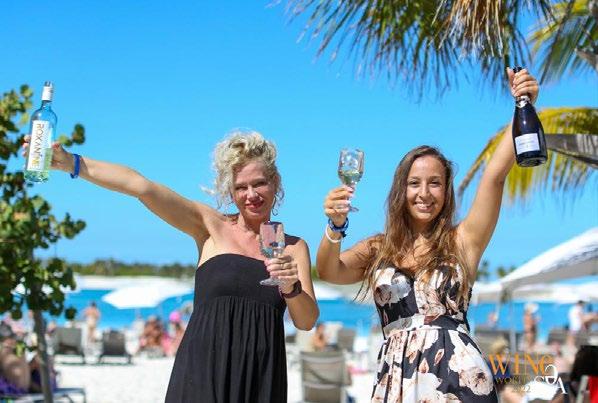


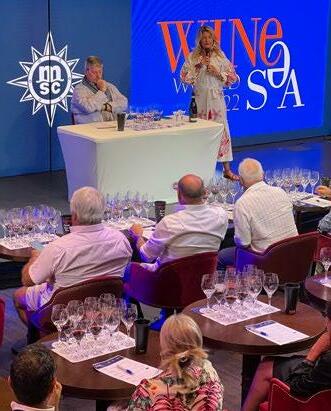

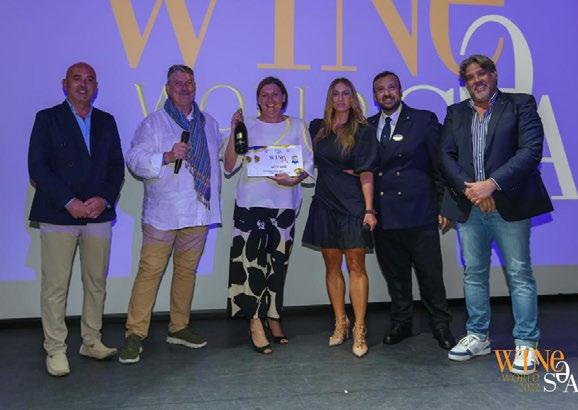

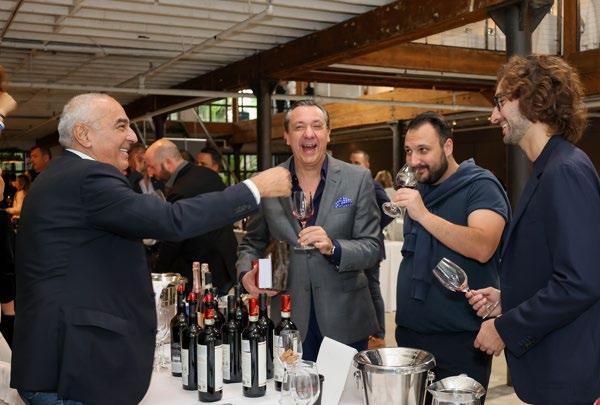





Here are the dishes and wines paired wines at chef Gianfranco Pascucci’s restaurant in Fiumicino
PINK PRAWN TARTARE, APPLE GEL, SEAWEED AND WALNUTS
Wines paired:
Salice Salentino Negroamaro Brut Five Roses Rosè
M. Cl. ’19 - Leone de Castris
Salice Salentino Rosato Anticaia ’21 - Cantina San Donaci
The Salento viticulture in its historical expressions returns highly contemporary wines that best pair with the signature menus of Italian restaurants: the Puglia labels are accompanied and proposed by Gambero Rosso in pairing with dishes of the best chefs in a tasting journey that includes ten exclusive dinners until 2024.
The tour of the two Puglia PDOs started from Milan and has so far made a stop in Fiumicino, the seafood “mecca of Rome” at BistRo Aimo e Nadia and at Pascucci al Porticciolo


In the tasting, with dishes designed ad hoc, «reds which, at different temperatures, show various intriguing nuances and the ability to bring out unusual and surprising pairings - says Damiano Reale, President of the Consorzio di Tutela Vini Dop Salice Salentino - Talking about this wine it means telling the story of a peasant class, retracing an ancient history that has its roots in the heart of wine-growing Salento.”
No less evocative of Salento is Brindisi. As Angelo Maci, President of the Consortium for the Protection of Doc Brindisi and Doc Squinzano wines, enthusiastically points out: «The name itself, Brindisi, is beautiful. Brindisi is joy, it is folklore, it is celebrating (Brindisi also means “toasting to” Ed.). Behind this denomination there is long work, which celebrates a territory devoted to viticulture. We are convinced of the Negroamaro – the basic grape common to both Consortia – a product with a thousand-year history whose characteristics we have improved thanks to advanced technology.»
CRISPY REEF MULLET, LIVERS AND BEETS
Wines paired:
Salice Salentino Negroamaro Rosato Rosalbore ’21
- Cantina di San Pancrazio
Aurora Rosato ’21 - Sergio Botrugno
PASTA WITH POTATOES AND BACCALÀ
Wines paired:
Salice Salentino Negroamaro Rosato Stelle di Lorenzo ’21 - Cantine De Falco
Salice Salentino Rosso Santa Croce ’18 - Vigneti
Reale
SHELLS WITH STEWED TUNA SAUCE
Wines paired:
Salice Salentino Rosso Il Barone Ris. ’21 - Vinicola
Mediterranea

Brindisi Rosso Camarda ’19 - Cantine Due Palme
MALLARD BRINED WITH MAQUIS HERBS, SEEDS AND RED BERRIES
Wines paired:
Salice Salentino Ris. ’16 - Cantina Vecchia Torre
Brindisi Negroamaro Masada ’18 - Tenute Lu Spada
CHOCOLATE AND FIGS IN RED WINE

Wines paired:
Salice Salentino Ris. ’11 - Cosimo Taurino
Brindisi Rosso Simposio ’16 - Cantine Risveglio
Today Salento has all the characteristics to be considered among the most important Italian winemaking areas and the millenary know-how as well as the typical alberelli pugliesi are the greatest strengths of this land. Vineyards by the sea re-
freshed by breezes under a hot sun, red soils of considerable complexity that have in common the sandy texture of marine origin organised in flat or slightly sloping terrain. When one arrives in the terroir of the two denominations, the red colour of most of these soils is striking. This is a characteristic linked to the composition of the soil, rich in iron and aluminium hydroxides. The equidistant proximity to the two seas (Adriatic and Ionian) of these vineyards allows temperature ranges and excellent ventilation, giving the wines great sapidity..
And if from Brindisi – terminal of the ancient Appian Way which connects the city to Rome – the Grand Tour once departed bringing young Romans to discover Greece (here the scions of the aristocracy greeted their friends on departure with a glass of good luck wine, which from then it became known as the Italian term for “toast”), Salice Salentino has a history that dates back to the Middle Ages. Back then it became important as an agricultural centre and trade crossroads, whilst today it is known throughout the world for its wine. Here, in short, in the lands of the two PDOs, wine has always been made, primarily from the Negroamaro and Malvasia nera grape varieties: produced for centuries and successfully marketed well beyond regional borders.
Consorzio

DOC Brindisi e DOC Squinzano
consorziosalicesalentino.it - vinibrindisisquinzanodoc.it

In Milan, in the BistRo Aimo e Nadia, chef Sabrina Macrì presented her dishes paired with 12 labels from the two PDOs, Salice Salentino and Brindisi e Squinzano.

LEMON SCENTED CAULIFLOWER AND TURNIP
TOPS, RISERVA BONAT PARMIGIANO WAFER
Wines paired:
Salice Salentino Negroamaro Rosato ’21 - Feudi di Guagnano
Brindisi Rosato Flaminio - Az. Vallone
FASSONA PIEMONTESE TARTARE, ANCHOVY SAUCE, PEPERONE CRUSCO DI SENISE
Wines paired:
Salice Salentino Rosso Le Pitre ’19 - Mottura
Brindisi Rosso Negroamaro Anticaia - Cantine San Donaci
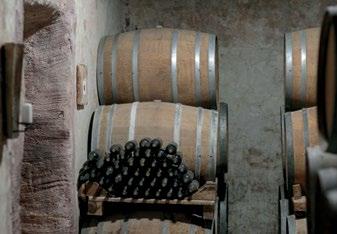
GRAN RISERVA CARNAROLI RISOTTO, POLIGNANO POTATOES, NIEDDITTAS VARIETY MUSSELS
Wines paired:
Salice Salentino Rosso Albarossa ’20 - Vinicola Palamà
Brindisi Rosso Susumaniello Oltremè - Tenute Rubino
TORTELLI STUFFED WITH MANTOVANA PUMPKIN, AMARETTO, SAFFRON CONCENTRATE
Wines paired:
Salice Salentino Rosso Narrante ’20 - Cantine Serio
Brindisi Rosso Ris. Since 1952 - Cantina Sampietrana
ROMAN STYLE STEWED OXTAIL, POTATO ROSTI AND BLACK
KALE
Wines paired:
Salice Salentino Rosso Centopietre ’19 - Petrelli
Salice Salentino Rosso Ris. ’18 - Cantele
DARK CHOCOLATE CREAM, LAVA CAKE WITH EXTRA VIRGIN
OLIVE OIL AND PEPPER, GOAT CHEESE GELATO
Wines paired:
Salice Salentino Rosso Ris. ’16 - Cantine Paolo Leo
Salice Salentino Rosso Ris. Ormanera ’16 - Le Vigne di Sammarco
di Tutela Vini DOP Salice Salentino e Consorzio Tutela Vini INIZIATIVA REALIZZATA NELL’AMBITO DEL “PROGRAMMA DI RIGENERAZIONE ECONOMICA, SOCIALE E AMBIENTALE DEL TERRITORIO JONICO-SALENTINO COLPITO DA XYLELLA FASTIDIOSA, RADICI VIRTUOSE”, FINANZIATA A VALERE SULL’AVVISO MIPAAF N.10900 DEL 17.02.2020 “CONTRATTI DI DISTRETTO XYLELLA”. JANUARY-FEBRUARY 2O23 35 GAMBERO ROSSO GAMBERO ROSSO WITH SALICE SALENTINO DOP AND BRINDISI DOPPrimitivo di Manduria on Tour. Tasting dinners: the food and wine tour born from the collaboration between the Consortium for the Protection of Primitivo di Manduria and Gambero Rosso started in December

«In the most important international restaurants we want to show the many facets of Primitivo di Manduria Dop. The wine reflects the territory like a negative photographic image, and for this reason it is so important both to preserve its environmental and landscape context as well as telling the consumer about it through our labels,» told us the President of the Consortium, Novella Pastorelli. A journey that has already started in Italy together with Gambero Rosso which has chosen to accompany this jewel of Italian oenology which has made great strides in terms of quality. A total of eight dinner events in the best Italian restaurants focused on the great red of Puglia with a jour-
ney that started from the tables of Pashà in Conversano and which will cover the Peninsula all the way through 2024. «Many appointments await us to revive the atmosphere and the spirit of sharing stories and experiences – explains the President – We have the primordial task of making our realities, small and large, known.»
THE FIRST 10 LABELS AT PASHA

Soft, enveloping, fine and warm, Primitivo di Manduria Dop has revealed some of its best aspects in pairings with dishes conceived and created by Antonio Zaccardi, chef at Pashà. Here in Conversano, the Consortium brought ten labels for which the chef designed his dish-
Primitivo di Manduria Dop was born in an area between land and sea, punctuated by dry stone walls built and maintained with painstaking patience. The grape ripens prematurely and is harvested at the end of August. The nose offers intense ripe fruit and hints of plum, cherry, blackberry, small berries and raisins or sultanas in spirits; depending on the area in which it is grown, hints of Mediterranean maquis and spicy notes can also be noted. In the mouth it is rich, warm, deep, with enveloping fruity aromas, good tannic texture and balanced freshness, as well as a surprising persistence in the mouth.
es: reds that are born between land and sea, intense, warm, sumptuous, enveloping and which reveal a vast range of nuances capable of pairing with every course, from appetiser to dessert. A union between the Primitivo di Manduria and the table, which in Puglia has lasted at least since the 18th century and which – if traditionally in the game of pairings combined with rich and succulent dishes – it is not surprising that today it is among the favourite wines in Asia in how wonderfully it marries with local cuisine dishes, characterised by strong, spicy and often hot flavours which, as an accompaniment, need a warm, intense, soft and glyceric wine.
The Primitivo di Manduria area covers 18 towns, namely Manduria, San Giorgio Jonico, Carosino, Monteparano, Leporano, Pulsano, Faggiano, Roccaforzata, Lizzano, Fragagnano, San Marzano di San Giuseppe, Sava, Torricella, Maruggio, Avetrana and, in the province of Brindisi, Oria, Erchie and Torre Santa
THE DINNER IN CONVERSANO:
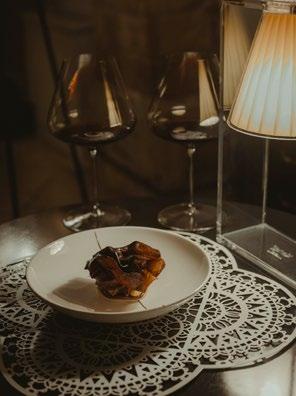
LET THE TOUR BEGIN
First appointment, therefore, in the restaurant where chef Zaccardi offers a cuisine that communicates the Puglia territory, projecting it beyond predefined geographical and cultural boundaries. Beside him is Angelica Giannuzzi, pastry chef of the year for Gambero Rosso’s Ristoranti d’Italia 2023 guide, who built her desserts around the Primitivo di Manduria Dolci Naturali: wines that take advantage and bring to maximum sweetness a natural characteristic of Primitivo, i.e. the withering of the grapes on the vine, a process which can be more or less accentuated, but which always concentrates the aromatic strength and power of the wine and best defines its identity and elegance. A wine considered “for meditation” par excellence for its perfect balance between the various components: acidity, dry extract, alcohol, bouquet and colour.
1. The President of the Consortium for the Protection of Primitivo di Manduria, Novella Pastorelli, together with Marco Sabellico during the dinner event in Conversano
2. The dessert created by Angelica Giannuzzi
3. Veal and sweet potato stew by chef Antonio Zaccardi
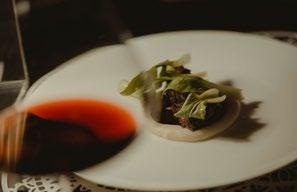
SNACK AND CANAPÉS
Wines paired:
Primitivo di Manduria Pepe Nero ’20
- Masseria Cicella
Primitivo di Manduria Papale Oro ’20
- Varvaglione 1921
FAVA BEANS AND OLIVES
COOKED AND RAW CAULIFLOWER WITH TRUFFLES
Wines paired:
Primitivo di Manduria Assiade ’21
- Vigne Monache
Il Rosso dei Vespa ’21 - Vespa Vignaioli per Passione
RISOTTO WITH SEAFOOD
Wines paired:
Primitivo di Manduria Imperio ’21
- Cantine San Giorgio
Primitivo di Manduria Villa Santera ’21
- Leone de Castris
VEAL AND SWEET POTATO STEW
Wines paired:
Primitivo di Manduria Acini Spargoli Ris. ’17

- Antico Palmento
Primitivo di Manduria Giunonico Ris. ’17
- Cantine PaoloLeo
Pre dessert
CHESTNUTS AND CHOCOLATE
Piccola pasticceria
Wines paired:
Primitivo di Manduria Dolce Naturale
Don Filippo ’16 - Tenute Cerfeda
Primitivo di Manduria Dolce Naturale
Mandoro ’20 - Cantine Lizzano

RADICI VIRTUOSE”, FINANZIATA A VALERE SULL’AVVISO MIPAAF N.10900 DEL 17.02.2020 “CONTRATTI DI DISTRETTO XYLELLA”.

 Consorzio di Tutela del Primitivo di Manduria - Manduria (TA) fraz. Uggiano Montefusco - c.da Piscine – consorziotutelaprimitivo.com
INIZIATIVA REALIZZATA NELL’AMBITO DEL “PROGRAMMA DI RIGENERAZIONE ECONOMICA, SOCIALE E AMBIENTALE DEL TERRITORIO JONICO-SALENTINO COLPITO DA XYLELLA FASTIDIOSA,
Consorzio di Tutela del Primitivo di Manduria - Manduria (TA) fraz. Uggiano Montefusco - c.da Piscine – consorziotutelaprimitivo.com
INIZIATIVA REALIZZATA NELL’AMBITO DEL “PROGRAMMA DI RIGENERAZIONE ECONOMICA, SOCIALE E AMBIENTALE DEL TERRITORIO JONICO-SALENTINO COLPITO DA XYLELLA FASTIDIOSA,

Toasting to the new year and take stock of the world of bubbles in Italy - where the winemaking heritage for the different sparkling wines is ever wider with Prosecco which continues to be the best-selling and loved sparkling wine in the world - and in France, in Champagne in particular, with wines particularly appreciated by our wine lovers especially in vintage versions, in special cuvées, in

Their success is unstoppable, neither wars, fashions, pandemics, nor crises seem to create a dent. The consumption of sparkling wines is growing at full throttle, both in Italy and internationally. The great phenomenon of the last decade is certainly the worldwide exploit of Prosecco. Its success began twenty years ago with the progressive appreciation of Conegliano Valdobbiadene, which led to the creation of a Prosecco System. The historic one has become Superiore and Docg. But there are two regions that contribute to the territory of the Prosecco Doc: Veneto - obviously - and nearby Friuli. In the province of Trieste, as a matter of fact, the town of Prosecco has put the flag on both denominations - effectively blocking the possibility of imitation in other areas of Italy and the globe, and dusting off the ancient name glera for its protagonist grape.
From Anchorage to Cape Town, from London to Moscow, Prosecco is now synonymous with sparkling wine, with all due respect to purists, experts and gourmands who quibble about sparkling winemaking methods, grapes, rests on the lees and emblazoned cuvées. With over 700 million bottles sold between Superiore Docg (100 million) and Doc, and with the projected target of 1 billion bottles in the short span of a few harvests, there is little to argue beyond sterile sophisms. Prosecco is loved and has conquered the world because it is simply delicious to drink, at any time, with and without food pairings, alone or mixed in cocktails, it has a low alcohol content, it is fruity and floral, it comes in a range of
styles and sugar dosages ranging from the driest "Extra Brut" to the sweetest "Dry." Educated and demanding palates, willing to spend a few more euros (there are a few) turn to Prosecco Superiore, to the Rive (a sort of premier cru) and the grand cru par excellence, the precious Cartizze which is born in just 108 hectares on a hill kissed by the sun and by luck. Prosecco Doc also has - in addition to an excellent quality level when compared with other tank-aged productions from other areas of the world - great accessibility in terms of cost. In short, since the creation of the Docg-Doc system in 2009, the way of seeing and consuming sparkling wine around the world has definitely changed. And fortunately, this global success has not been to the detriment of the Classic Method sparkling wine, whether Italian or French… On the contrary, it has acted as an actual driving force.
In Italy and in the world, the production and consumption of the Classic Method has also grown and the world of Champagne is experiencing a golden era. Simply, Prosecco has seasonally adjusted and made the consumption of sparkling wines everyday – at the table and not – widening the audience of consumers who, once "initiated" to the joy of bubbles, have also turned to other territories and other styles. So also in Italy the historical denominations of the classic method, namely Oltrepò, Trento and Franciacorta, to which the Piemonte Alta Langa has recently been added, enjoy excellent health and set production records every year; fortunately also in terms of quality..
Furthermore, the success of these areas has prompted many other realities, where there was a sparkling wine tradi-
The consumption of sparkling wines is growing inexorably, both in Italy and internationally. From Prosecco to Classic Methods to the "ancestral" and natives, it's veritable bubbly-mania
tion or where it is now being born, to try their hand at the thousand possibilities offered by our native grapes, from Erbaluce to Ribolla, from Gaglioppo to Carricante and Nerello, in order to experiment with refermentation, whether it is with the Italian method invented by Martinotti (in the tank) or rather of the second fermentation in the bottle i.e. Classic Method. As for the French, nothing can scratch the reputation of Champagne, whether of the classic maisons, or of the more "natural" and fashionista récoltant.
These are exceptional products that arise from centuries-old tradition and from a savoir-faire fueled by in-depth and constant research that has had to face the crucial issue of global warming, something which has radically changed the cards on the table compared to the scene thirty years ago. And in this we Italians, who found ourselves facing the problem – for reasons of latitude – well before others, are perhaps further ahead in managing these problems. Extra Brut is now the norm for us, or almost. Vineyards at high altitudes, zero or "minimal" malolactic fermentation of the base wines, increased yields in the vineyard and targeted soil management, upkeep of foliage and shading of the bunches are crucial issues together with deep attention to the pressing phase, which is increasingly soft. Thus, with a growing hotter and drier climate, we have managed not to lose along the way the fundamental quality of the basis of every sparkling wine, whether classic or Italian: freshness given by acidity. And we are able to offer fresh, savoury and naturally soft-tasting products without resorting to excessive dosage and reserve wines, as was the tradition, especially beyond the Alps. Now the French, for once, are watching us carefully and taking notes.
Italian bubbles have been the great bet won in recent years, as well as the type that has continued to drive the market, bringing Italian wine above 7 billion euros in exports in 2021 (of which, almost 2.1 billion euros due to bubbles) and – pending confirmation – over 8 billion in 2022.
This corresponds to a growth in production: in 2020 there were 750 million bottles, in 2022 it exceeded one billion. And for 2023 the forecasts speak of 1.25 billion (UIV Observatory on Qualivita-Ismea data). On the consumption front, if 2021 was an extraordinary year for sparkling wines, despite the restrictions still in place, 2022 counted on the return to full capacity of the "away from home" and, therefore, of the HoReCa channel. The last holiday season has demonstrated this, to the point that there has also been some difficulty in satisfying the demand, in regards to the most sought-after types (especially Champagne and Italian classic methods). Golden moment, therefore, for Italian dry Charmats, beyond Prosecco. Rosé bubbles are well positioned, accounting for 10% of the Italian bottled wine of the type, with Prosecco taking the lion's share.
To be honest, during the year, some setbacks were recorded on foreign markets, but fortunately the value still holds, even if it will still be necessary to push on the average price. Last positive note; 61% of Italian sparkling wines are branded Doc and 22% Docg, as noted by the Uiv Wine Observatory, demonstrating the long work carried out on the quality pyramid.
Prosecco Doc
28,000 hectares
360 sparkling wine wineries
80% export
627,5 million bottles
- 472 million spumante
- 71,5 million rosé
- 84 million frizzante
Prosecco Docg
8.700 hectares
192 sparkling wine wineries
442 vinificatori
3400 wine producing families
100 million bottles
export 40%
Asolo Docg
2,000 hectares
460 partners (40 bottlers)
21 million bottles nel 2021
70% export
Asti Docg
4,000 wineries
9.900 hectares
60 million bottles Asti
Spumante
42 mln bottles Moscato d'Asti
90% export
Franciacorta
121 partners
3,000 hectares
20 million bottles
11% export
Trentodoc
64 sparkling wine wineries
1150 hectares
12 million bottles
15% export
Oltrepò Pavese
158 partners
13,000 hectares
75 million bottles
- 500,000 metodo classico
Despite what one might think, the Prosecco denomination is not the most extensive in Italy: first place belongs to the Doc Delle Venezie, but it is Prosecco that boasts the national production primacy with more than 700 million bottles per year. And yet, just sixty years ago when 11 producers got together to create the Consorzio di Tutela del Prosecco di Conegliano Valdobbiadene, no one could have remotely imagined the overwhelming success raining down on the small Treviso denomination.
The recognition of the Doc came in 1969 and we can say that until the first half of the 2000s the production was characterised by a fairly continuous but limited growth in numbers, substantially concentrated on the hills of the historic area that extends between Conegliano to
the east, and Valdobbiadene to the west, where the hilly conformation itself limits the development of viticulture. The great interest from the whole world for the lively Veneto sparkling wine exploded in those years and, with the birth in 2009 of the current DOC which extends to all of Friuli Venezia Giulia and all of Veneto (with the exception of the provinces of Rovigo and Verona ) and with the transformation of the historical denominations of Conegliano Valdobbiadene and Asolo into DOCG, production underwent an impressive surge. Today, more than 100 million bottles per year are produced in the historic area and it is a consolidated figure. Production in the Asolo area is constantly growing, with around 20 million. For a total of 620 million from the entire denomination.
This success came with marketing centred on lifestyle, relying on the pleasant-
ness of the wine and the symbolic power of the sparkling wine, a certainly winning strategy but which at the same time has somehow distanced the image of Prosecco Superiore from the milieu of excellence wine. However, in their respective production regulations both Conegliano Valdobbiadene and Asolo leave an important window open on a virtuous path that once again speaks of the link between grape variety and vineyard, enhancing the organoleptic differences that the best exposures can offer and which goes by the name Rive.
In the production of a sparkling wine that plays its pleasure on fragrance, the lightness of the sip and its sapid vein, the choice of the most suitable vineyard becomes fundamental, and a hilly area such as the two DOCGs can offer vineyards of ancient planting that unfold on exposures of great value, where the composition of the soil has a net influence on the organoleptic profile of the wines.
Adami – Valdobbiadene Rive di Colbertaldo Asciutto Vign. Giardino '21
Vidor (TV) – adamispumanTi iT
The Adami brothers produce this dry Valdobbiadene starting from a single vineyard in the Colbertaldo area. The Vigneto Giardino '21 captivates with delicate aromas of fresh fruit and citrus, which we find in a broad, savoury sip that perfectly blends acidity, bubbles and sweetness.
Andreola – Valdobbiadene
Rive di Refrontolo Brut
Col del Forno '21
Farra di soligo (TV) – andreola.eu
Col del Forno once again confirms the

quality of the grapes that come from the Refrontolo area, which give life to a 2021 sparkling wine where notes of white fruit stand out clearly against a base of citrus and fresh flowers. The palate is striking for its remarkable sapidity, which gives fullness and drinkability to a slender and taut wine.
Valdobbiadene Rive di Ogliano
Extra Brut '21
Conegliano (TV) – bianCaVigna iT
The Moschetta brothers reveal once again how they know how to best interpret the Ogliano area, with an Extra Brut '21 of rare composure. Forget the Proseccos that are all about nose and exuberance, the Rive di Ogliano is broad and refined, dominated by white fruit and soft floral notes. The sip is solid, dry and of great tension.
Bisol 1542 – Valdobbiadene
Rive di Guia Extra Brut Relio '21
Valdobbiadene (TV) – bisol iT
«After a past in which skills have helped us to give Prosecco Superiore a recognisable profile and identity, our challenge today is instead to enhance and make known the differences that this great territory can offer: in this process Rive, like historic Cartizze has been, are truly fundamental,» says Elvira Bortolomiol, while Sarah Serena adds that «today all the technical skills are aimed precisely at enhancing diversity, because we have areas where the wines are more savoury, others where instead they are more structure and behind each of these wines there is a territory of rare beauty and integrity, where vineyards, historic villas and ancient villages are inextricably linked to Prosecco Superiore.»
– by Nicola FrassonRelio '21 is a Prosecco Superiore produced with grapes from the Guia area, one of the most fascinating exposures in the Valdobbiadene. On the nose, the suggestions of apple and pear are clear, surrounded by a subtle floral vein. The sip is dry and the wine stands perfectly on the savoury presence.
Borgoluce – Valdobbiadene
Rive di Collalto Extra Brut '21
susegana (TV) – borgoluCe iT
In the company range, the Extra Brut '21 always stands out, fruit of the most beautiful vineyards in the Collalto area, clear in the expression of fuji apple with soft sweeter and more mature notes in the background. In the mouth the territory gives a natural richness to the sip, which therefore does not need residual sugars and is based on the gritty sapid and acid push.
Bortolomiol – Valdobbiadene

Rive di Col San Martino
70th Anniversary '20
Valdobbiadene (TV) – borTolomiol Com
Produced for the first time to celebrate 70 years of production, today the 70th Anniversary '20 is presented with stratified aromas that recall the long stay in the cellar. The ripe "renetta" variety apple intertwines with the notes of bread crust and fresh flowers, but it is in the mouth that the wine is truly amazing: the characteristic lightness of the grape becomes full and sapid, for a dry and refined sip, supported by acidity and very fine bubbles.
Sorelle Bronca
– Valdobbiadene Rive di Rua
Brut Particella 181 '21
Vidor (TV) – sorellebronCa Com
Today the company's challenge is to enhance the production by relying on wines produced from single vineyards, bringing out the different characteristics of the territory. The tasting of Particella 181 from the 2021 harvest is emblematic: hailing from the vineyards of Rua di Feletto and expressing the sunniest character of the typology, the wine has aromas of ripe fruit and flowers that re-emerge in a sapid, harmonious and highly drinkable sip.
Canevel – Valdobbiadene
Brut Campofalco '21
Valdobbiadene (TV) – CaneVel iT
In recent years, the historic company from Saccol has become part of the Masi group led by Sandro Boscaini. Campofalco '21 debuts on the nose with an intense note of ripe yellow fruit, echoed by subtle vegetal nuances that give lightness and freshness to the aromatic profile. In the mouth, the typical richness of the area finds leverage in the acidic presence to find tension and gustatory length.
Case Paolin – Asolo Extra
Brut Pietra Fine '21
Volpago del monTello (TV) – Casepaolin iT
The Pozzobon brothers are among the most attentive interpreters of the Asolo sparkling wine area, with vine-
yards that develop mainly along the slopes of Montello. However, for the Pietra Fine they go up and cross the course of the Piave river up to the Possagno area, cooler and on the side of Monte Grappa. Fresh, clear and fragrant aromas for a dry and stimulating flavour profile.
Conte Collalto – Conegliano
Valdobbiadene Rive di Collalto
Brut Isabella '20
susegana (TV) – CanTine-CollalTo iT
The viticultural platform of Isabella Collalto de Croÿ develops in Susegana, one of the historical realities of the territory. Fruit of the best Collato vineyards, Isabella '20 is a Prosecco Brut released only after a long stay in the cellar which gives depth to the aromas, where ripe fruit gives way to notes of dried flowers and hazelnut. In the mouth it is dry, rich and harmonious.
Le Colture – Valdobbiadene Rive di Santo Stefano Extra Brut Gerardo '21
Valdobbiadene (TV) – leColTure Com
From the vineyards of Santo Stefano, a splendid exposure overlooking the lower hills and the Treviso plain beyond, hail the grapes for Gerardo, an Extra Brut that gives the nose intense notes of white fruit and flowers, while in the mouth it expresses its best territorial character, enhancing the finer and more dynamic aspects of the type by renouncing a pinch of structure.
Giusti Wine – Asolo Extra Brut '20
nerVesa della baTTaglia (TV) –
giusTiwine Com

At its first release, the Asolo Extra Brut '20 conquers us, the sparkling wine produced in collaboration with Graziana Grassini and fruit of the vineyards of the Aria Valentina estate. The apple notes are clearly perceived on the nose, embellished with nuances of dried flowers and a soft mineral suggestion. In the mouth it is striking for the richness of the sip, perfectly supported by creamy bubbles and a marked saltness.
Masottina – Conegliano Valdobbiadene Rive di Ogliano Brut R.D.O. Ponente '21 san Fior (TV) – masoTTina iT Both sparkling wines produced with the most beautiful vineyards of Ogliano are very good, with the eastern part of the vineyard destined for the Extra Dry version and the western part instead for the Brut. The latter is striking for the fruity and delicately vegetal nature of its aromas, while in the mouth it is the richness that ensnares the taster, resulting as dry, solid and of great length.
Graziano Merotto –
Valdobbiadene Rive di Col San Martino Brut Cuvée del Fondatore Graziano Merotto '21
Farra di soligo (TV) – meroTTo iT Graziano Merotto '21 confirms that it is one of the most interesting interpretations of Treviso bubbles, a sparkling wine that combines aromatic depth with its snappy and joyful drinkability, where white fruit appears surrounded by floral and delicately citrus notes.
Montelvini – Asolo Brut FM 333 ’21
Volpagno del monTello (TV) – monTelVini
iT
Sarah and Alberto Serena produce this fragrant Brut with grapes from the Montello vineyard in the Fontana Masorin area at an altitude of 333 metres. On the nose the fruit is sharp, ripe and at the same time refreshed by a soft floral nuance. In the mouth the strength of the territory emerges in a sip whose distinctive feature is saltiness and harmony.
Ruggeri & C. – Valdobbiadene
Extra Dry Giustino B. '21
Valdobbiadene (TV) – ruggeri iT
Among the great labels of Valdobbiadene, without a doubt Giustino B. plays an important role. Also with the 2021 harvest it claims its role as leader, representing the quintessence of the
Extra Dry type: it smells of ripe fruit and linden flowers and conquers for its ability to make the marriage between sweetness, acidity and bubbles harmonious.
La Tordera – Valdobbiadene
Rive di Guia Extra Brut Otreval '21
Vidor (TV) – laTordera iT
The Guia district, a few kilometres east of Valdobbiadene, is one of the most fascinating wine-growing areas in Italy, with slopes that seem to fall almost vertically towards the valley, with the glera grapes that have taken possession of it for centuries. From these vineyards come the grapes for Otreval '21, an Extra Brut that smells of white fruit and flowers, with a dry mouth and great acidity.
Valdo Spumanti – Valdobbiadene
Rive di San Pietro di Barbozza
Extra Brut '20
Valdobbiadene (TV) – Valdo Com
Among the protagonists who have made the history of modern Prosecco, an important role certainly belongs to the Bolla family winery. Only after a long stay in the cellar is the Rive di San Pietro di Barbozza released, an Extra Brut that combines fresh floral and white-fleshed fruit notes with a dry, solid and decidedly savoury gustatory dynamic.
Villa Sandi – Cartizze
Brut La Rivetta '21
CroCeTTa del monTello (TV) – Villasandi iT
A truly happy hand for the sparkling wines in the drier version which, in the case of Cartizze La Rivetta '21, also expresses the great value of the territory. Visually striking for the dense texture of bubbles that slowly flow into the glass and anticipate aromas where apple and flowers play a starring role. In the mouth the lightness of the sip is supported by the typical saltiness of Cartizze which blends with acidity and with harmonic sweetness.
The taste for the classic binds four great suitable territories: for history, nature of the soil and know-how. These are areas that share problems (increased temperatures, drought and therefore early harvests) but above all strong elements of growth. The confirmation comes from the quality in the glass and from the market, between record numbers and turnovers, for an increasingly vital and competitive landscape.
Let's start from the shores of Lake Iseo, Franciacorta alone produces about half of the Italian Classic Method, with over 20 million bottles sold in 2021 and even more optimistic forecasts for the end of 2022. Our tastings reveal a new maturity, with a cuvée of increasingly precise territorial adherence and definition. The current trend is called Dosaggio Zero, over 110 samples of
the type presented for the Vini d’Italia guide, the cuvées with a long stay in the bottle stand out, starting from the Riserva category which in Franciacorta translates into a long stay on the lees of at least 60 months. But the rethinking of the liqueur d'expedition seems to be good, by extension, also for the Extra Brut and the Brut which seem to us to be more focused than ever today, giving a complete drinkability and immediate pleasure at very competitive prices. Equally interesting is the reflection on Satèn (Blanc de Blancs, minimum 24 months) which faithfully represents the calling card for understanding the company's stylistic hallmark. What's new? A growing number of complex Blanc de Noirs, despite the fact that only 15% of the 3,000 hectares of vineyards are planted with Pinot Noir, a percentage that will reach 20% in the next few years. "Growth is a matter of climate and the market, just look at the
international demand for Rosés where we are thinking of revising the specification (today a minimum of 30% of pinot noir is required, Ed.)," comments Silvano Brescianini, President of the Franciacorta Consortium. There is also an important update of the research work of the 90s, a zoning 3.0 "not only will it be a zoning with a tighter mesh, but we will add data on climate and biodiversity." At the moment, in Franciacorta over 2/3 of the denomination is organically farmed.
Still in Lombardy, we cross the Po river and find ourselves among the beautiful hills of Oltrepò Pavese, the kingdom of pinot noir with its 3,000 hectares of cultivated land. Every year some of the deepest and most vibrant Blanc de Noirs of the Peninsula hail from here, especially from the highest areas with some crus of Valle Versa or Scuro-
passo to offer unique gustatory parables for acidic and sapid kick: aromatic richness and rhythm. The dosages too have been revised sharply downwards here, while the cuvées resulting from a prolonged contact on the lees in the bottle and single vineyard debuts are multiplying: the challenge of the future is played out here. Keeping the flag of the territory high is the Rosé version of the DOCG, or Cruasé, with some still little-known pearls of exquisite gastronomic nature. The Achilles heel? The production numbers remain unchanged, in 2021 the denomination was claimed by only 523,000 bottles, +23% compared to 2020, still too few. The majority of wineries offer great cuvées that do not bear any geographical mention. "Finally we are at the turning point for a modification of the DOCG regulations, starting from a Riserva mention that did not exist and which is necessary to differentiate the price level," comments Carlo Veronese, director of the Consortium. "In 2022 we moved a lot in terms of international promotion both with Gambero Rosso and with other partners, we went from America to Japan to Germany. People like the products, the response is excellent, we have to believe in it and work together with our heads down. Many wineries are finally converting to the denomination."
From Vecchio Piemonte to the production hills of the Alta Langa, we are in an area that embraces 149 towns in the provinces of Cuneo, Asti and Alessandria, with various points of contact with the Oltrepò plots, starting from the dominance of Pinot Noir which accounts for 2/3 of the 350 hectares of vineyards. Peculiarity of the specification? Unlike the other denominations, the DOCG is the result of the obligatory interpretation of a single vintage
and has a particularly high entry threshold, a minimum of 30 months on the lees, while for the mention Riserva the stake is only 36 months. A systematic revision of the regulation is also underway among these rows, with the minimum altitude that should be raised to 250 metres above sea level for the vineyards, combined with a marked viticultural vocation of the parcels. While waiting to see the final project, let's go back to the forecasts: the record figure of 3 million cuvées produced will soon be reached. In 20 years the steps forward have been great, now only the last and most difficult leap in quality is missing.
We close at high altitude with the celebrated mountain bubbles: the Trentodoc. The current situation is excellent, starting from the economic aspect, just think that in 2021 the 64 associated sparkling wine houses achieved a global turnover of 150 million euros (+40% compared to 2021). Within the sector we find the typical regional subdivision, on the one hand the large cooperative groups, on the other a growing range of small winemakers of certain value. In our tastings we see quality growth on both fronts, just pick up the list of Tre Bicchieri where Ferrari stands out together with new entries such as Revì, Letrari pulling the sprint to Maso Martis, and again Moser, Balter and Rotari. These are cuvées with a strong territorial connotation, which feel the mountain and the Dolomites landscape for fragrance and aromatic cleanliness. In total, we are talking about 1,150 hectares of vineyards and a production that in 2021 stood at 12 million bottles sold; 85% is consumed in Italy, with an increasingly widespread distribution.
– by Lorenzo
RuggeriCantine Alice Bel Colle – Alta Langa
Pas Dosé Tressessanta Ris. '18
aliCe bel Colle (al) – CanTinaaliCebC iT
The cooperative is expertly led by Claudio Negrino and Bruno Roffredo and is building a good reputation with Barbera, but also with a good range of Classic Methods, which this year has been enriched by Alta Langa Tresessanta, a bold Pas Dosè Riserva (60 months on the lees) with a fine and creamy palate anticipated by an aromatic profile played on floral and bread crust sensations.
Bava – Alta Langa Brut Bianc ‘d Bianc
Giulio Cocchi '17
CoCConaTo (aT) – baVa.Com

The Alta Langa wines of the Bava family are born from the vineyards of the historic Cocchi company, of which in 1978 it took over the brand and continued the sparkling wine production. The Alta Langa Brut Bianc 'd Bianc '17, made from 100% Chardonnay grapes and aged for 48 months on the lees, highlights on the nose tones of bread crust and pastry cream, while the palate is dynamic and at the same time of good substance, taut and long.
Borgo Maragliano – Giovanni Galliano
Brut Rosé M. Cl. '18
loazzolo (aT) – borgomaragliano iT
The Galliano family on the hills of Loazzolo, Bubbio, Bistagno and Canelli has created a reality making some of the best Classic Method products in Piemonte. Giovanni Galliano Brut Rosé '18, made from 100% Pinot Noir grapes and aged for 30 months on the lees, offers floral, yellow fruit and pastry cream scents, is fresh and flowing, with a long and
spirited finish with yellow peach notes.

Cascina Cerutti – Alta Langa Brut
Cuvée Enrico Cerutti '18
CassinasCo (aT) – CasCinaCeruTTi iT Established in the 1930s, Cascina Cerutti is now led by Gianmario Cerutti and has its own vineyards located between Cassinasco, Canelli and Agliano. The Alta Langa Enrico Cerutti Brut '18, made with pinot noir (80%) and chardonnay and aged for 36 months on the lees, highlights aromas of Granny Smith apple and toasted bread, while the palate is of good substance and hold, with a fresh and gritty finish of great pleasure.
Colombo – Alta Langa Brut
Blanc de Blancs '18
bubbio (aT) – ColomboVino iT
Chardonnay 100%, the Alta Langa Blanc de Blancs Brut by Colombo is confirmed at the top of its category. The 2018 version is highly classic on the nose, in its floral, bread crust, plum and peach notes, while the palate is creamy and flowing at the same time, with good length and tension.
Coppo – Alta Langa Luigi Coppo
Brut '19
Canelli (aT) – Coppo.iT
This historic Canelli winery is now owned by Gianfranco Lanci, but the Coppo family is still at the helm of production. The Alta Langa Luigi Coppo Brut '19 is a 100% Pinot Noir aged 30 months on the lees with intense aromas of bread oven, white peach and ginger, while the palate has strength, but it is also smooth and pleasant to drink.
Deltetto – Alta Langa Brut Nature Blanc de Noirs Ris. 2017
Canale (Cn) – delTeTTo.Com
The Deltetto family winery has carved out an important space for itself in the Piemonte sparkling wine
production, thanks to a series of excellent quality labels. The Alta Langa Blanc de Noirs Brut Nature Riserva '17 is a 100% Pinot Noir aged 42 months on the lees and highlights aromas of wild berries, bread and pastry cream, while the palate is compact, of beautiful material and with a long and convincing finish.
Fratelli Grimaldi – Ca' Du Sindic – Alta Langa Brut Ca' du Sindic '18 sanTo sTeFano belbo (Cn) –FraTelligrimaldi.iT
Sergio Grimaldi has been managing the family winery since the late 1980s, which has vineyards located on the hills of Moncucco, San Grato, San Maurizio and Bauda. Alta Langa Brut '18 is a 100% Pinot Noir, which comes from vineyards located at an altitude of 500 metres and is aged for 36 months on the lees, in which notes of white fruit and bread crust stand out, for a palate of beautiful sharpness and with a smooth and spirited finish.
Marcalberto – Alta Langa
Extra Brut Millesimo2Mila18 '18 sanTo sTeFano belbo (Cn) – marCalberTo iT Alta Langa Extra Brut '18 is a blend of Pinot Noir and Chardonnay which rests on the lees for at least 36 months. It reveals itself as energetic, vital and very multifaceted. An ideal sum of characteristics and peculiarities to demonstrate the potential inherent in the denomination.
Enrico Serafino – Alta Langa
Zero Pas Dosé '16
Canale (Cn) – enriCoseraFino iT
Enrico Serafino's Zero Pas Dosé is always a certainty. The 2016 version does not disappoint: the scents of aromatic herbs, white fruit and spices are followed by a palate that is both creamy and fine, with a nice length and determination, which fully convinces.
Socré – Alta Langa Brut Nature
Tersaux '19
barbaresCo (Cn) – soCre iT
Fine and harmonious perlage for the Alta Langa Terseux '19 which develops notes of bread crust and yeast but also a nice freshness of aromas with notes of white fruit and light honey to give character and complexity. It has remarkable acidity with a creamy and persistent perlage.
1701 – Franciacorta
Dosaggio Zero Ellessedì '16
Cazzago san marTino (bs) –
1701FranCiaCorTa iT
Since 2011 Federico and Silvia Stefini have been at the helm of one of the fastest growing wineries in Franciacorta. The range they offer is more than exciting, led by Franciacorta Ellessedì '16, ringing in its mature, ample and spicy register. Aromas of licorice and coffee, fleshy, fragrant with peach and raspberry, with a bursting mouth of great energy and length.
Barone Pizzini – Franciacorta
Dosaggio Zero Bagnadore Ris. '14
proVaglio d'iseo (bs) – baronepizzini iT Bagnadore '14 (62% chardonnay, 38% pinot noir) offers one of the deepest, most satisfying and most complete drinks in all of Franciacorta. It starts on delicately toasted tones, to then release a crisp fruit; the mouth is overwhelming in intensity and articulation, with a savoury lunge of great character and a very long finish on small red fruits.
Bellavista – Franciacorta
Brut Rosé '17
erbusCo (bs) – bellaVisTawine iT Chardonnay (56%) and pinot noir (44%) make up the blend of Franciacorta Rosé '17, which rests at least four years in the cellar before hitting the market. Extremely fine in its hints of pastry cream and aniseed, delicate in its floral appeal, it has subtle and continuous carbonation for a clear, airy and progressive finish.
Guido Berlucchi & C.
– Franciacorta Nature 61 '15
CorTe FranCa (bs) – berluCChi iT
In the last round of tastings we really appreciated the finesse of '61 Nature: a blend of chardonnay (70%) and pinot noir, with a fine and creamy sparkle, fragrant in tones of toasted bread and fresh almonds, offering embroidered tactile sensations and a precise and prolonged finish.
Bosio – Franciacorta
Dosaggio Zero B.C. Ris. '11
CorTe FranCa (bs) – bosioFranCiaCorTa iT
Franciacorta B.C. '11 is a very successful blend of chardonnay and pinot noir. The aromas are refined: suggestions of hazelnut, white pepper and citrus peel are the prelude to a deep and complete cuvée, multifaceted in its aromatic profile and exceptionally long-lasting and fresh on the palate, thanks to a very fine sparkle.
Ca' Del Bosco
– Franciacorta Dosage Zéro
Annamaria Clementi Ris. '13
erbusCo (bs) – CadelbosCo Com
When it comes to the best Italian sparkling wines, one cannot fail to mention an iconic label such as Anna Maria Clementi. The 2013 version offers the usual gustatory richness combined with an enviable complexity thanks to tones of hazelnut, aniseed and buckwheat. The mouth is enveloping, intense, with a long finish of fruit and spices.
Camossi – Franciacorta
Dosaggio Zero CR 149 Ris. '08
erbusCo (bs) – Camossi iT
The "149" that stands out on the label refers to the months that this cuvée of chardonnay and pinot blanc rests on the lees. The 2008 vintage highlights the beauty of the year, between fleshy tones of apple and raspberry, extremely vital to the sip, rich and juicy, it has energy and flavour, fine perlage and a long balsamic finish.
Castelfaglia – Monogram
– Franciacorta Brut Rosé
Cuvée Monogram '15
Cazzago san marTino (bs) – CaViCChioli iT
We always find the Franciacorta cuvées that come to life in the Calino area truly fascinating. The credit goes to the Cavicchioli family, starting with oenologist Sandro who shuttles between here and Modena to offer some of the rarest expressions of the appellation. The Rosé Monogram '15 is very elegant, light in colour and very fine in the floral and citrus references, subtle sparkle, with delicate hints of spices and notable savoury depth.
Battista Cola – Franciacorta
Dosaggio Zero '16
adro (bs) – ColabaTTisTa.iT

We always find the Franciacorta wines by Stefano Cola original and rich in character. He continues to carry on the work started by his father Battista with considerable passion and competence. We warmly recommend the Franciacorta Dosaggio Zero '16, a cuvée with marked fragrance and balsamic freshness. It offers vivid sensations of orange peel, grapefruit and mint, enlivened by a fine and continuous bubble.
Corte Fusia – Franciacorta
Dosaggio Zero '16
CoCCaglio (bs) – CorTeFusia Com
Gigi Nembrini and Daniele Gentili have created one of the rockiest companies in Franciacorta and form a perfect team. The Dosaggio Zero '16 (75% chardonnay and pinot noir, 50 months on the lees) is certainly not lacking in character with its tones of toasted bread and mountain apple; on the palate it is juicy, enveloping, made vibrant by a fresh savoury trace and very well integrated acidity.
Ferghettina – Franciacorta
Extra Brut Eronero '14
adro (bs) – FergheTTina iT
Among the companies in Franciacorta, Ferghettina is by far the one with the most land dedicated to pinot noir, cultivated with excellent results. Part of this flows into Eronero, a top-ranking Blanc de Noirs which in the 2014 version sports a full and fleshy red fruit nose, delicate in its chamomile and green tea tones; on the palate it is whispered and multifaceted, with a very pure balsamic finish.
Mirabella – Franciacorta
Dosaggio Zero Døm Ris. '15
rodengo saiano (bs) –
mirabellaFranCiaCorTa iT
The company from Rodengo Saiano obtained the Tre Bicchieri for the first time with the Døm Riserva '15, a Cuvée of chardonnay (60%), pinot noir (30%) and pinot bianco that's complete from every point of view: it has ripe fruit and fleshy, depth, and an innate sense of naturalness. The finish is harmonious, creamy and very long.
Mosnel – Franciacorta Pas Dosé
Parosé '16
passirano (bs) – mosnel Com
In a truly high-level range, the Parosé '16 stands out with strength, a blend of pinot noir and chardonnay with very fine details. It enchants with its aromatic purity, it is delicately balsamic, the carbonation is silky and infiltrating: tones of anise, coffee and rose dance with rare class. Not just Tre Bicchieri: for us it is the Bubbles of the Year.
Ricci Curbastro – Franciacorta
Dosaggio Zero Gualberto '12
Capriolo (bs) – riCCiCurbasTro iT
Tre Bicchieri goes to the cuvée dedicated to the founder Gualberto, a blend of pinot noir and chardonnay that rests on the lees for eight years. The 2012 version is soft and creamy in tones of peach, anise and almond, which find a perfect balance in a broad and graceful palate, with whis-
pered carbonation. The finish is long, vital and continuous.
Lo Sparviere – Franciacorta
Dosaggio Zero Ris. '15
monTiCelli brusaTi (bs) – losparViere iT
Lo Sparviere is one of the estates of Gruppo Agricole Gussalli Beretta, a family that shares a passion for the land and for wine. The Dosaggio Zero
Riserva '15 is very good, 100% chardonnay which rests on the lees for 72 months, and which appears mature, offering tones of honey and white flowers; the mouth is rich, balanced, with great precision in the finish.
Uberti – Franciacorta
Brut Satèn Magnificentia '18
erbusCo (bs) – uberTiVini iT
We were enchanted by the Satèn Magnificentia '18, by how the chardonnay is transformed into a very elegant aromatic profile in its timbre of spices, in the hints of wheat and coffee; the mouth is enveloping but also rhythmic, the finish well nuanced on Mediterranean herbs.
Ballabio – Farfalla Noir
Collection Extra Brut M. Cl. Rosé

CasTeggio (pV) – ballabiowinery iT
The Farfalla Rosé that we tasted for the Guide defeated the internal competition for the Tre Bicchieri race. It is a very refined Classic Method made with Pinot Noir grapes, delicate in the aromatic trait and with an enveloping and caressing sparkle; it fades with extreme class on tones of wheat, rose and anise.
Alessio Brandolini – Note d'Agosto
Extra Brut M. Cl. Rosé '18
san damiano al Colle (pV) –
alessiobrandolini Com
It is precisely bubbly, Alessio's great passion, that gives him the greatest satisfaction year after year. Note d'Agosto Rosé is confirmed as a
top-ranking Classic Method, capable of combining freshness of taste and an uncommon creaminess, with a very sharp menthol profile..
Calatroni – OP Cruasé
Extra Brut NorEma '19
monTeCalVo Versiggia (pV) – CalaTroniVini.iT
NorEma '19 has everything one would expect from a Classic Method Pinot Noir made as rosé. It has aromatic finesse, a marked fragrance of raspberries and strawberries, a creaminess dictated by a fine perlage and a remarkable overall completeness.
Giorgi – Top Zero
Pas Dosé M. Cl.
CanneTo paVese (pV) – giorgi-wines iT
At Giorgi, the focus is increasingly on Pinot Noir, especially the Classic Method. To prove it is, once again, the excellent performance of the Top Zero, which this year offers deep and varied aromas ranging from coffee to licorice, from currants to aniseed, for a cuvée capable of dosing richness and maturity, but also rhythm and momentum.
Monsupello – Brut M. Cl.
TorriCella VerzaTe (pV) – monsupello iT
It was 1982 when the first bottle of Metodo Classico was released from Torricella Verzate. Since then, the bubbles of Monsupello have forged ahead, establishing primacy on the Italian market for constant quality and stylistic recognition. The non-vintage Classic Method Brut is authentic in its coppery reflections, and is deep and articulated in its apple and raspberry tones.
Scuropasso – Roccapietra
– Roccapietra Zero M. Cl. '16
pieTra de' giorgi (pV) – sCuropasso iT Roccapietra Zero '16 is one of the best Metodo Classico tasted this year. It has everything one would expect from a Blanc de Noirs: fruit, intensi-
ty, grit, flavour and depth. It has an enviable aromatic cleanliness, on the finish it leaves a long balsamic shiver and a return of pure berries, with a nice spicy background.
Pietro Torti – OP Cruasé '19
monTeCalVo Versiggia (pV) – pieTroTorTi.iT Sandro Torti and his daughter Chiara, freshly holding a master's degree in oenology, lead the family business, dedicated to the founder Pietro, Sandro's father. This year the Cruasé fully convinced us. It is a rosé Pinot Noir of great character, rich in colour and fruit, juicy in the tones of raspberries and cinchona, intriguing in its spicy trait.
Bruno Verdi – OP Pinot Nero
M. Cl. Vergomberra '18
CanneTo paVese (pV) – brinoVerdi iT Vergomberra '18 is confirmed as one of the most fascinating, historic and personality Classic Method wines of the area. It has menthol aromas, citrus peel and white pepper, on the palate it shows off a vibrant freshness, only slightly hard and compressed on the finish; it will certainly improve with further rest in the bottle.
Abate Nero – Trento Brut Domini Nero '16
TrenTo – abaTenero iT
It is one of the Trentodoc prototypes, an early classic, already born in the 1970s. The company is managed by Roberta Lunelli and Roberto Sebastiani, who select grapes from trusted winegrowers. Domini Nero Brut is a Pinot Noir of great elegance and softness, with saline lashings and a body that combines aromatic power with an articulated richness of silky savour; nice backbone and straightforward drinkability.
Nicola Balter
– Trento Pas Dosé Balter Ris. '15 roVereTo (Tn) – balTer iT
Chardonnay (80%) and pinot noir come together in the blend that gives life to this Pas Dosé Riserva which rests on the lees for over 72 months. Definitely elegant already on the nose where it shows hints of mountain herbs, it has a pressing sip thanks to its splendid saline vein; invigorating, it closes with a finish of great gustatory thrust, as it rarely happens.
Bellaveder
– Trento Brut Nature Rosé '17 san miChele all'adige (Tn) – bellaVeder.iT The Luchetta family cultivates vineyards both in the Valle dei Laghi and around their cellar, on the alluvial flank of Faedo. Enterprising winemakers, harvest after harvest, work their Trentodoc wines with ever greater skill. The Rosé is caressing in its coppery pinkish perlage, it has hints of face powder and wild roses, with a nice citrus tone and targeted sparkling smoothness, for a jovial and captivating drink.
Cantina De Vigili – Trento Brut Art mezzolombardo (Tn) – CanTinadeVigili iT Francesco De Vigili is a young man from Teroldego Rotaliano, who for the first time tries his hand at signature bubbles, elaborated with chardonnay grapes and proposed in a thoughtful selection. The aromatic impact is delicious: ripe citrus and candied fruit, with evolution of hazelnuts, Mediterranean filigree, iodine, for a full and convincing palate, in some ways crisp.
Cenci – Trento Brut Nature '18
CasTelnuoVo (Tn) – CenCiTrenTino iT Valentino and Silvia Cenci cultivate vineyards in Valsugana, in their small cellar they mainly produce sparkling wine. Their prototype, the Brut Nature, is obtained exclusively from chardonnay; the rhythmic and very fine vivacity of the aromatic profile mixes hints of freshly baked bread, hints of rosemary and ripe peach, be-
tween very persuasive sensory inlays and flavours of crunchy apple.
Dorigati – Trento Brut Methius Ris. ‘16 mezzoCorona (Tn) – dorigaTi iT The Dorigati have been offering this wine for almost 40 vintages, but only in a few thousand bottles, to the point that Methius has become a symbol of sparkling wine, not just from Trentino. Predominantly Chardonnay, with pinot noir, strictly manual processing, in respect of tradition: here is a spirited Trentodoc, golden in colour, with vaguely resinous notes and decidedly persuasive, inviting mushrooms, for a portentous, full, authoritative finish.
Ferrari – Trento Extra Brut
Perlé Nero Ris. '15
TrenTo – FerrariTrenTo.Com
Certainly among the Italian Classic Method Pinot Noirs, Perlé Nero Riserva is one of those wines that confirm their great personality year after year. It also does so with this sumptuous 2015 version designed by a bouquet of rare finesse, with a silky perlage, with a palate that is divided between floral and red fruit sensations on a background of great verticality and with a very deep mineral breath.
Letrari – Trento Brut 976
Riserva del Fondatore '11
roVereTo (Tn) – leTrari iT
The whole range presented at our tasting tables for the Guide was more than valid. But the winner for the Tre Bicchieri was the Riserva del Fondatore '976 '11, a cuvée with a soft and graceful character, with the usual notes of ripe fruit with white pulp, biscuit, slightly buttery, and on the palate veined by vibrant citrus acidity.
Maso Martis
– Trento Extra Brut Rosé '18

TrenTo – masomarTis.iT
Organic vineyards, a completely renovated winery structure, a range dedicated only to fascinating Trent-
odoc wines: this is how Maso Martis is occupying an increasingly prestigious role in the Italian sparkling wine scene. The Extra Brut Rosé '18 has coppery reflections and is sharp and airy in its tones of wild strawberries and mandarin orange; on the palate it is rhythmic and vibrant: Tre Bicchieri worthy.
Maso Poli – Trento Brut Siris Ris. '16
laVis (Tn) – masopoli Com
The Togn are wine entrepreneurs with long experience in various winemaking sectors and in their farmstead dairy located above Lavis they produce a single version of Trentodoc to relaunch the peculiarities of Trentino and fine drinking. The Siris wine boasts bubbles with a bright colour and a precise aromatic impulse of beautiful lineage, with notes of toasted hazelnuts, a very elegant perlage for a fresh, vaguely menthol finish.
Moser – Trento Extra Brut Blanc de Noir '15
TrenTo – moserTrenTo.Com
Francesco and Carlo Moser's winery is located on the highest hill north of the city of Trento. From the vineyards, tended like gardens, comes a range of Trentodoc wines whose leitmotiv is grit and verticality. The Extra Brut Blanc de Noir '15 does not go beyond this paradigm, which follows an elegant and fresh nose played between mountain herbs and currants followed by a snappy, vibrant and energetic mouth.
Pisoni Spumanti – Trento Extra Brut
Erminia Segalla Ris. '14
madruzzo (Tn) – pisoni iT
Wine producers since 1852, indomitable distillers and attentive sparkling wine makers for over half a century: we are talking about the Pisoni family who only work grapes from their own vineyards scattered on the slopes of Castel Madruzzo. Among the Trentodoc wines, here is the Riserva ded-
icated to their ancestor: shiny and crystalline in its gold colour, it is ample and austere in its gentle approach, tense in vivacity and satisfying in the finish.

Pojer & Sandri
– Molinar Extra Brut M. Cl. san miChele all'adige (Tn) – pojeresandri iT Mario Pojer and Fiorentino Sandri have never neglected the care of the sparkling wine in their oenological experimentation. In an autonomous way, outside the schemes and customs. With a pinot meunier-based cuvée, here is an Extra Brut rich in character, tonic, caressed by fine hints of rural herbs, pure sensations of lemon and citron, for a complexity that makes it flow in the mouth without any hesitation.
Pravis – Trento Extra Brut
Blau Doré '18
lasino (Tn) – praVis iT
Reflects the grace of the two sisters - Erika and Giulia Pedrini - who elaborate it in their Madruzzo cellar, using only Pinot Noir grapes coming from the high hills. Fragrances range between thyme and oregano, with nuances of strawberries and a charming balsamic accent, for a vaguely coppery bubble, as rhythmic as it is persuasive; juicy sip, balanced dosage, kaleidoscopic finish.
Revì – Trento Extra Brut
Re di Revì Ris. '12
aldeno (Tn) – reVispumanTi Com
The Malfer family has been involved in the cultivation of the vineyards surrounding the village of Aldeno for generations; here elaborates Trentodoc exclusively, exploiting the potential of a mountain viticulture that allows limited but high quality productions. Re di Revì is a beautiful example of this: complex, taut, almost fleshy, very classy.
Rotari – Trento Brut
Rotari Flavio Ris. '14
mezzoCorona (Tn) – roTari iT
Rotari is the sparkling wine reality that is part of the great Mezzacorona giant. Over the years it has elaborated highly balanced cuvées, in full harmony with the characteristics of the best Trentodoc wines. The company champion is always the Flavio, a Riserva that eight years after the harvest is still fresh and fragrant, it smells of white flowers and citrus and is deep and very clean on the palate.
Salizzoni – Trento Nature
Rhodium Ris. '15
Calliano (Tn) – salizzoni inFo
This sparkling wine from the Salizzoni di Calliano family is one of the absolute novelties of the area: they named it Rhodium, inspired by the rare mineral linked to platinum. It is offered after 60 months of patient rest on the lees: it is a cuvée of chardonnay with a pinch of pinot noir; the result is a varied range of aromas going from hints of brioche to toasted hazelnuts, for a taut, articulated, inviting palate, relaunched by a fine yet caressing bubbly note.
San Leonardo – Trento Pas Dosé Marchesi Guerrieri Gonzaga Ris. ‘18 aVio (Tn) – sanleonardo iT Studied for a long time by the young Marquis Anselmo Guerrieri Gonzaga in synergy with trusted winegrowers from the Lavis hills, it is a vibrant, symphonic sparkling wine with versatile dynamism. Made from chardonnay grapes, it stands out for fruity power, intensity, grit and absolutely intriguing gustatory lunge; smoothness and indomitable liveliness until the end of the sip.
Spagnolli Spumanti – Trento
Extra Brut Blanc de Noirs Disio '17 Cimone (Tn) – spagnollispumanTi.iT
Alvise Spagnolli transforms his Pinot
Noir grapes in the Cimone cellar, on the high slope of Mount Bondone, into this singular Trentodoc, dedicated to a verse by Dante, offering an indomitable wine, endowed with strength, graceful backbone, gentle fragrances of hay, quince, notes of jam, in harmony with the crunchiness of the savoury sip; fine and rhythmic perlage.
Tenuta Volpare – Trento Dosaggio Zero
TrenTo – TenuTaVolpare.Com
Trento is increasingly becoming the city of bubbles. Tenuta Volpare cultivates the vineyards that are perhaps the city's highest elevation, focusing on a few wines, but favouring sparkling wine. A Dosaggio Zero, a blend of chardonnay and pinot noir which - albeit young - enhances its purity with crystalline colour and hints of anise mixed with butter and the ripeness of golden apple; substantial, enveloping, absolutely engaging palate.
Certainly not a novelty that the production of sparkling wines has already gone beyond the confines of the distribution areas for a couple of decades now, and that wines with bubbles have planted their flag. And so, looking beyond the Alta Langa, Franciacorta, Oltrepò Pavese, Trentino and the Prosecco hills, it is possible to see some interesting labels in other areas of Italy as well. Many producers, truly in all regions, try their hand at refermentations, both in tanks and with the Classic Method, and by now there are very few grapes that don't lend themselves to these experiments. However, the fact that sparkling wine is made everywhere does not mean that every area is suitable for producing high quality sparkling wines; just as it is
also true that not all grapes are suitable for this typology. Furthermore, the technical aspect should not be underestimated: to make high-level cuvées it often takes years of trials but not all wineries are willing to wait to acquire the necessary knowhow. And so there are lights and shadows, but what we note is that the general level is growing, with some territories offering real gems. And so we find some bubbles rated with Tre Bicchieri in Alto Adige, in Lessinia, the Veneto sparkling wine basin where durella gives the best, or in Emilia, with Lambrusco di Sorbara which increasingly lends itself to the Classic Method with great results. But stopping at the highest recognition bestowed by our Guide would not do justice to the many producers who try their hand with
excellent results in other regions as well: try to believe how sparkling Verdicchio behaves in the Marche, fiano and caprettone in Campania, gaglioppo in Calabria, nerello mascalese, grillo or carricante in Sicily, torbato and cannonau in Sardinia. But the ampelographic palette does not stop there: the classic pinot noir, chardonnay and pinot bianco are accompanied by particular productions relying on sangiovese, vermentino, and also zibibbo. Below we offer an overview, certainly not exhaustive, of what we think are the best bubbles tasted that do not fall within the "classic" sparkling wine territories: the advice is to look for them for outside the box enjoyment.
– by William PregentelliKettmeir – A. A. Spumante
Extra Brut M. Cl. 1919 Ris. '16
Caldaro/KalTern (bz) – KeTTmeir.Com
The 1919 Riserva '16, a blend of chardonnay and pinot noir, enhances the aromatic finesse of the 2016 vintage with a bouquet of white fruit and flowers that gives freshness to the deepest notes of toasted bread. On the palate it conquers for fullness and tension, equally revealing a strong and refined character.
Cantina Kurtatsch – A. A. Spumante
Blanc de Blancs Pas Dosé 600 Ris. ’16
CorTaCCia/KurTaTsCh (bz) –
CanTina-KurTaTsCh.iT
From the small village of Penon at 600 metres above sea level come the chardonnay grapes that give life to this fine and slender sparkling wine. The long stay on the lees, 55 months, gives depth to aromas, with golden apple that intertwines the mineral nuances and notes of dried flowers. The palate is juicy, dry and of great elegance.
Lorenz Martini – A. A. Spumante
Pas Dosé Comitissa Ris. ’18
appiano/eppan (bz) – lorenzmarTini Com
For the production of his sparkling wine, Lorenz Martini uses grapes from vineyards that explore the Oltradige and San Genesio area, on vineyards that extend between 500 and 800 metres above sea level. Pinot Blanc, Chardonnay and Pinot Noir come together in a cuvée with an articulated aromatic profile, with the fruit standing out clearly on a mineral base and toasted hints. On the other hand, it is essential on the palate, almost sharp in its acidity and with a long and juicy finish.
Casa Cecchin – Lessini Durello
Extra Brut M. Cl. Nostrum Ris. ’17
monTebello ViCenTino (Vi) – CasaCeCChin iT
The fruit of a vineyard planted half a century ago on soil rich in basalt and tuff, Roberta Cecchin's Durello rests on the lees for three years before giving off its complex aromas reminiscent of ripe yellow fruit and saffron while on the palate it is rich, taut and pleasantly textured. The most authentic soul of Durello in a savoury glass with great character.
Dal Cero – Tenuta Corte Giacobbe
– Lessini Durello M. Cl. Extra Brut

Cuvée Augusto Ris. '16 – 3 bicchieri ronCà (Vr) – dalCeroFamily iT Durello Augusto '16, more than 50 months on the lees, has a beautiful luminous and brilliant appearance that anticipates deep aromas, where the toasted notes alternate with yellow fruit and the typical mineral vein of the grape. In the mouth it reveals the perfect fusion of richness, acidity and bubbles.
Giannitessari – Lessini Durello
Extra Brut M. Cl. Ris. ’14
ronCà (Vr) – gianniTessari wine
Gianni Tessari founded the winery in 2014 and this sparkling wine best expresses his style. The nose captures all the maturity of a wine with a long rest on the lees (60 months), the yellow fruit is well ripe and accompanied by mineral and brackish notes. The palate, on the other hand, combines richness and harmony, giving life to an energetic and satisfying sip.
Tonello – Lessini Durello
Extra Brut M. Cl. Io Aura ’16
monTorso ViCenTino (Vi) – ViniTonello Com
The grapes of Io Aura come from a pergola that's over thirty years old that plunges its roots in alluvial soil on the slopes of the volcanic hills of Lessinia. Bringing the glass to the nose, the
notes of white fruit and the characteristic mineral nuance reminiscent of gravel arrive clearly. In the mouth it is dry, almost citrine in the acidity and has a curious smoky finish.
Tenute Tomasella – Brut Cuvée 38 M. Cl.
mansuè (TV) – TenuTeTomasella iT
Paolo Tomasella's company develops close to the Treviso Pre-Alps, with vineyards that explore both the Veneto province and the Pordenone province. The Cuvée 38 winks at the world of Champagne, with an aromatic profile where the fruit reveals timid oxidative notes that give depth and complexity. The sip is full and juicy, perfect for sparkling wine lovers throughout the meal.
Francesco Bellei & C. – Brut M. Cl.
bomporTo (mo) – FranCesCobellei iT
Oenologist Sandro, passionate champion of bubbles, manages this winery owned today by the Cavicchioli family. We recommend the entire range of sparkling wines, but above all we liked the Classic Method Brut, a very fine and elegant blend of chardonnay and pinot noir, with notes of yellow fruit and hints of pastries.
Cantina Della Volta – Lambrusco di Sorbara
Brut M. Cl. Rosé '17
bomporTo (mo) – CanTinadellaVolTa Com
Cristian Bellei is a sparkling wine professional. He proved it to us once again with this Sorbara Classic Method Rosé; the 2016 version is sensational: elegant, harmonious, graceful, but also tasty, with the perfect perlage in its creaminess and finesse, and with the aromas of small red fruits that mark a satisfying drink to the last sip.
Cantine Romagnoli – Il Pigro Brut M. Cl. '20
Vigolzone (pC) – CanTineromagnoli iT
Pinot noir is almost always the protagonist in the range of bubbles
offered by Cantine Romagnoli. It is also in the Pigro Brut (where it is joined by chardonnay) completely convincing thanks to an impeccable balance between structure and acidity, with a sip that's punctuated by a perfect bubble that gives rhythm to the sip and projects it into a nice sapid and clean finish.
Cantina Valtidone – Arvange Pas Dosé
borgonoVo Val Tidone (pC) –
CanTinaValTidone iT
This cooperative represents one of the most important wine-producing areas in the province of Piacenza and is strongly focusing, harvest after harvest, on sparkling wine production. Here we have chosen the Arvange, an important product also for the long rest on the lees (over 40 months): the nose shows off notes of sweet spices, lemon zest and vanilla, while the palate is dense, enveloping, fresh and savoury.
Villa Di Corlo – Lambrusco di Sorbara
Brut Rosé M. Cl. Elettra '19 modena – VilladiCorlo.Com
Maria Antonietta Munari's company is located in the south-west area of Modena and produces wines with great drinkability and precise execution. Elettra is a delicious Lambrusco di Sorbara Spumante Rosé that smells of wild strawberry, rose and currant; the mouth is very balanced and the acidity, although strong, is always well integrated with the material.
Venturini Baldini – Reggiano
Lambrusco Brut Cadelvento Rosé '21
QuaTTro CasTella (re) – VenTurinibaldini.
iT Cadelvento Rosé is undoubtedly the wine that best represents the quality of this beautiful Reggio Emilia reality. It is a sparkling wine obtained from 70% Sorbara and grasparossa, sparkling with a very long charmat. The result is a pink bubble, with soft and elegant aromas, and fine and dosed effervescence. Cleanliness, pleasantness and creami-
ness are not lacking in a long, deep sip.
Zucchi – Lambrusco di Sorbara
Brut Purezza Silvia Zucchi '21 san prospero (mo) – VinizuCChi iT Among those presented by the winery at our tastings, the wine that most surprised us bears the signature of Silvia Zucchi: it is called Purezza, a Lambrusco di Sorbara of rare elegance. The nose has delicate notes of rose, wild strawberry, pastries and slight herbaceous hints. On the palate everything is in perfect balance between acidity, sapid length and creamy and fine carbonation.
Colle Santa Mustiola – Aldonem Spumante Rosato Chiusi (si) – poggioaiChiari.iT
In the history of wine with bubbles there is also scholar Francesco Scacchi, whose stories we can only suggest to deepen. Thanks to Fabio Cenni, a must-taste is the Aldonem "Metodo Scacchi," a rosé Sangiovese from refermentation in the bottle, started with the sugars of the grapes themselves, without adding any extra. And, after disgorgement, only must from the same grapes; wine with clear aromas of small red fruits and fine bubbles, which moves creamy and fragrant in the mouth.

Broccanera – Verdicchio dei Castelli di Jesi Spumante Dosaggio Zero '16 arCeVia (an) – broCCanera iT
The inland position close to the Apennines of Giorgio Santini's verdicchio vineyards facilitates the vocation for sparkling wine. Delicate citrus references, freshly baked bread and raw almonds are found in a sober, elegant palate, free from excessive bitterness despite the absence of dosage and a 60-month rest on the lees.
Colonnara – Verdicchio dei Castelli di Jesi Spumante Brut Luigi Ghislieri CupramonTana (an) – Colonnara iT
The historic Cupramontana cooperative is known for its solid sparkling wine technique. The skill and reliability of the hand is well expressed in Luigi Ghislieri, a non-vintage cuvée made from Verdicchio grapes. The 42 months of ageing, of which at least 30 on the lees, lend balsamic and citrus sensations with a full mouth, openly tasty, not without appreciable complexity and perky finish.
L.E. Tempo – Le Tempo Brut Rosé '20 massignano (ap) – leTempo iT Letizia and Edoardo Cossignani produce only Classic Method. The Brut Rosé comes from an old Sangiovese vineyard raised in organic farming. 18 months and a further six months after the addition of the liqueur d'expedition. The face powder dress heralds hints of raspberry, yeast and a floral background; the sip is punctuated by a lively bubble which leaves a tasty and graceful trail.
Federico Mencaroni – Verdicchio dei Castelli di Jesi Spumante
Mencaroni Brut Nature '18
Corinaldo (an) – menCaroni eu Federico Mencaroni has been working on the Corinaldo hills since 2009. The main grape of the area is Verdicchio, the star of Mencaroni Brut Nature '18: 40 months sur lie and subsequent rest for a further six months give life to good sensations of crusty bread, toasted hazelnuts and subtle balsamic echo merged in a dry and saline sip, well registered in the bubbles and in the backbone.
Piano di Rustano – Verdicchio di Matelica Spumante Brut
Cavalier Vincenzo '19
CasTelraimondo (mC) – pianodirusTano.iT
Produced following the advice of oenologist Marco Gozzi, Cavalier Vincenzo is a Classic Method that
shows all the potential of the Verdicchio grape of the Matelica area. The 2019 vintage (24 months sur lie) mixes notes of bread crust, mowed grass and lemon leaves on the nose, amplifying them in a gritty mouth, with well-felt bubbles ready to turn into a sharp saline trail.
Casa Setaro – Pietrafumante
Caprettone Brut Nature M. Cl. '17
TreCase (na) – CasaseTaro iT Massimo Setaro certainly does not lack the desire to get involved. Among his various bets, there is the Classic Method caprettone. Some vintages have served to adjust his aim: today we are convinced that the target has been hit. Taste the Brut Nature '17: you'll perceive candied ginger, pastry cream, dried fruit chasing each other on a smoky background; cardamom and spices anticipate a layered mouthfeel with great mineral tension.
Dryas – Brut M. Cl. '16
monTeFredane (aV) – CanTinadryas iT Stefano Loffredo could be an inspiration to many Italian sparkling wine makers. His Classic Method made from Fiano grapes stays on the lees for 24 months. Equipped with complexity and many nuances - ranging from fresh almonds to green citrus fruits passing through mountain herbs - it has a palate played on tension and consistency, with a pleasant sensation of dried fruit in the finish. Equally interesting is the non-vintage Charmat, smoother and very clean.
Felline – Edmond Dantes
Pas Dosè M.Cl.
manduria (Ta) – agriColaFelline iT Gregory Perrucci's company is among the best in the Manduria area and alongside the primitivo-based labels it offers a small sparkling wine production. A thousand Magnums
are produced every year using the Edmond Dantes Pas Dosé Classic Method, made from Vermentino (80%) and Chardonnay grapes, fresh and pleasant, with aromas of citron and tropical fruits, with floral notes of wisteria and jasmine..
Tenute Chiaromonte – Chiaromonte
Ancestrale Evoluzione 40 Mesi Brut Rosé M. Cl. '17
aCQuaViVa delle FonTi (ba) –TenuTeChiaromonTe Com
The winery of Nicola Chiaromonte and Paolo Montanaro is an absolute reference for the Gioia del Colle Primitivo, but Nicola has always had true passion for the production of sparkling wines. The Ancestrale Evoluzione 40 Mesi Brut Rosé '17 is a Pinot Noir Classic Method with 10% primitivo, it has tones of red fruits, pastries and orange peel on the nose, while the palate is fresh, gritty and of good length.
Librandi – Rosaneti Brut
M. Cl. Rosé '20
Cirò marina (Kr) – librandi iT
Rosaneti '20, from the name of the homonymous estate where it is produced, is a pure Gaglioppo which ages on the lees for 24 months. The nose boasts hints of pomegranate, small fresh black berries, wild flowers, gingerbread and marine notes. The mouthfeel is fresh and crunchy with a velvety and well-contained effervescence; in the finish of good persistence a delicate note of red citrus emerges.
OI – Origine e Identità – OI Zibibbo
Dosaggio Zero M. Cl. '20
riCadi (VV) – origineeidenTiTa iT
The Zibibbo di Pizzo, the variety with which this sparkling wine is obtained, is one of the many synonyms of Moscato d'Alessandria, a grape that's widespread throughout the Mediterranean. Fine and multifaceted on the
nose with hints of orange and lime, apricot, hot croissant, lavender and sage; in the mouth it is fresh, well balanced between fruit and flavour, and with a long and pleasant aromatic persistence.
Barone Macrì – Centocamere
Brut M. Cl. Rosé '19
geraCe (rC) – baronemaCri iT
Don't be surprised that this sparkling wine is made from nerello mascalese: it is a grape that has always been very popular in the extreme south of Calabria. The Brut Rosé '19 is presented on the nose with hints of cherries and yellow peaches, red citrus, flowers, warm bread and pink peppercorns; the sip is captivating with a fresh and silky bubble, driven by vital acidity for a nice satisfying finish.
Baglio del Cristo di Campobello
– SICILY Grillo Extra Brut

M. Cl. CDC '18
Campobello di liCaTa (ag) –CrisTodiCampobello.iT
The CDC '18 is an Extra Brut from Grillo grapes grown on the white, calcareous and quartz-rich soils typical of the Campobello di Licata area and left to rest for 36 months on the lees. The aromatic profile is wide and varied, it approaches the nose with marine mineral notes, aniseed, citrus fruits, biscuits and ripe white fruit. The mouth is very pleasant, tonic, with an elegant bubble and a nice sapid and long finish.
Cottanera – Etna Brut M. Cl. '17
CasTiglione di siCily (CT) – CoTTanera iT
The Brut '17 is born from Nerello Mascalese grapes with alberello training system at an altitude of 750 metres, a sparkling wine that rests on the lees for 40 months. Very dense on the nose, which opens on iodised mineral notes, mountain herbs, citrus zest, buttery biscuits and white peach; the sip is elegant, sapid and with well-
dosed sparkle, while balsamic and white pepper hints make their way in the finish.
Cusumano – Quota 700 slm
Brut M. Cl. '18
parTiniCo (pa) – Cusumano iT
From pinot noir and chardonnay grapes, grown on the Ficuzza Estate at an altitude of 700 metres, the Cusumano brothers produce a Classic Method of refined elegance and with aromas reminiscent of hibiscus, wild strawberries, brioche bun, bergamot. The dynamic mouth is taut thanks to the acidity that pushes the bubble, already tonic and enveloping, for a nice saline and satisfying finish.
Donnafugata – Brut M. Cl. Rosé '17
m arsala (T p ) – donna F ugaTa . i T
From Pinot Noir grapes grown in the high hills on clayey and mineral-rich soils, it ages for 36 months on the lees. The 2017 vintage has an elegant bouquet of pomegranate and other small fresh red berries, wildflowers, limestone, mandarin, pastry and yellow spices. The sip is marked by a nice acidic backbone to support the structure; the bubbles are fine and caressing and the finish is of good length.
Cantine Fina – Pas Dosè M. Cl. 36 Mesi '18
m arsala (T p ) – C an T ine F ina i T
Federica's family, but she prefers being called Kika, has always grown grapevines in the Marsala countryside. She embodies the project of this Classic Method Pas Dosé made from pinot noir and chardonnay, a wine that also resembles her in character. Explosive and clear on the nose with its aromatic complement of white flowers, aniseed, citrus and yellow fruits, it is very pleasant on the palate, veined by crystalline, dense and silky bubbles, well pushed by a vital charge of savoury acidity.
Firriato – Etna Brut Blanc de Noir
M. Cl. Gaudensius
p aC e C o (T p ) – F irriaTo i T
From carricante grapes of three different contrade in Castiglione di Sicilia - Imbischi, Zottorinotto, Zucconerò - the Gaudensius ages for 36 months on the lees before disgorgement. The fine nose has scents of hawthorn, salty puff pastry, ripe yellow fruit, sweet spices and flint. Savoury and very fresh on the palate, silky on the bubble, long and citrusy on the finish.
Planeta – Planeta Brut M. Cl. '19
m en F i ( ag ) – plane Ta i T
To make a Classic Method, Planeta waited to take root well on Etna and then, after various trials, came out with a carricante-based sparkling wine. Dense and clear on the nose with hints of smoked salt, pears and fresh plums, pastries, linden and mint, it reveals as soft and captivating on the palate thanks to the harmonious coexistence of a notable acidic propulsion and a body of good weight; the savoury finish is long and satisfying.
Tasca d'Almerita – Almerita Brut
M. Cl. Rosé '17
s C la Fani b agni ( pa ) – Tas C adalmeri Ta i T
The Tasca family 35 years ago was among the first in Sicily to produce a Classic Method, which was soon followed by a Pinot Noir Rosé grown in the high hills of the Regaleali estate. It is the refined Almerita Rosé '17 which smells of strawberries and white cherries, violets, Mediterranean herbs, freshly baked bread and pastries. The sip is fresh and of rare pleasure, sapid but well balanced by the fruit, along the finish marked by a light toasted note.
Terrazze dell'Etna – Cuvée Brut
50 Mesi M. Cl. '17
r andazzo (CT) – T errazzedelle Tna i T
Made from 100% Chardonnay grown on the northern slope of the vol-
cano, at an altitude of 900 metres, comes this fine sparkling wine from the 2017 vintage, a cuvée that shines with a multifaceted olfactory profile that recalls dried flowers, candied citron, salted butter and ripe yellow fruit; soft and enveloping, it conquers the palate thanks to a beautiful and savoury acidity that also lengthens the finish.
Cantina di Castiadas
– Saeprus Brut Nature M. Cl. ’19

C as T iadas (C a ) – C an T inaC as T iadas C om
This Classic Method produced in Southern Sardinia, on the eastern coast, by the small cooperative of Castiadas – company specialised in cannonau – is truly particular. And it is precisely with the great Sardinian grape that the Cuvée is made. 24 months on the lees, no sugar dosage for a fine and elegant bubble where the hints of rose and wild strawberry stand out, while the mouth is enveloping and with the right softness.
Tenute Sella & Mosca – Alghero
Torbato Brut M. Cl. Oscarì ’18
a lghero ( ss ) – sellaemos C a C om Sella & Mosca has always bet on peat and sparkling wine of the particular Alghero vine, but with Oscarì it has moved from the charmat method to a classic method. Very successful, it ages for more than two years on the lees before going out on the market with a Brut dosage. Notes of medlar, white flowers, a touch of lime for a fresh, very savoury mouth with good progression.
That Champagne is experiencing a moment of grace, especially in Italy, is demonstrated by the Modena Champagne Experience event, now in its fifth edition and organised by Italian importers. Through the Excellence company, which brings together the major distributors and importers of quality wines and spirits in Italy, the Modena event reached important numbers, both for exhibitors involved, for cuvées presented and for the public attending, including many sector specialists who managed thus to navigate their purchases between large Maisons and small winemakers, increasingly appreciated outside their country.
Certainly the moment that Champagne is experiencing is euphoric, but there is no doubt that this circumstance will have to deal with the year 2023 and above all 2024: if the quantities are the same there will cer-
tainly be a high demand and a consequent rising price - explains Luca Cuzziol, President of Excellence and owner of the company that imports and distributes great Italian and foreign wines that bears his name – It will be interesting to evaluate 2024, the year in which we will return to "normal" quantities, and understand if these will be absorbed considering the rising prices. The Modena event represents a unique opportunity for the market: it is a show where the subdivision of the exhibition according to terroirs is an identifying feature that is not found in any other event. And then it also represents the state of health of the world of wine trade fairs: they must go in depth, propose a valid and high-level offer. We will try to improve further but to date there is no event of this magnitude in Europe on Champagne.»
Lorenzo Righi, director of Excellence and operational arm of the event echoes him, «This year we have reached the record number of 141 exhibitors for over 650 cu-
vées in the tasting. The presence of maisons, recoltants and cooperatives operating on the Italian market has grown steadily. In addition, the presence of producers at the tasting tables was conspicuous: proof of how much the French believe in the Italian market. We have reached the record number of 6,500 tickets sold.»
Among the importers, we also asked Luca Santini, commercial director of Teatro del Vino, for an opinion: «There is undoubtedly an immoderate attention in Italy towards Champagne. It is so high that it also allows for more or less improvisation by many importers, a phenomenon which therefore leads to a lot of confusion on the market. What the structured importing companies give is a constant tasting activity, continuous training, constant updating with our customers on types, vintages, styles. This involves an onerous effort which is reflect-
ed in pricing policies. But if you want quality you should never jump only on the price. In general I can say that there is great interest - as statistics show - in important cuvées and very low dosages (a typically Italian phenomenon), but overall the average tasting capacity has grown considerably by everyone.» The last consideration is made by Dick Ten Voorde and Massimo Maccianti, respectively owner and commercial director of Vino & Design: «Italy has always been an excellent market for Champagne - says Dick - but above all for the more important ones, the vintages and the special cuvées; one of our maisons that we import has a vast cellar of Reserves that go back to the Seventies: they give very small availability, but we are the ones who have the most, because they know that this kind of wine is drunk in Italy. In France there is more of a daily consumption of Champagne, instead we love the great Reserves more… It is more beautiful here!» «Champagne in Italy should be classified as some car trim levels are classified: elegance, classic, sportexplains Maccianti - "Sports" are the ones that are very fashionable, that make noise; the "Classic" are those that are less fashionable, but represent the denomination; then there are the "Elegance," which are perhaps even less understood. There's much talk about elegance in wines, but in the end it's little understood. We have to start from there, from finesse and elegance, the traits that have made Champagne great!»
The production area of Champagne is an area of more than 30,000 hectares, is located 170 kilometres east of Paris and is divided into several areas, of which the main ones, from north to south, are the Montagne de Reims, the Vallée de the Marne, the Côte des Blancs, the Côte des Bar (Aube). Within these areas there are 17 Villages classified as Grand Cru and 44 as Premier Cru. The altitude can reach a maximum of 250/300 metres
Champagne Fleur de l’Europe


Nature – Fleury (TeaTro del Vino)
Since 1989 the company has worked in biodynamics and elaborated cuvées focused above all on the great red grape variety. The Fleur de l'Europe (85% pinot noir) has backbone and structure, it is dry and offers a textbook complexity of taste and aroma. 60 months of permanence on the lees.
Champagne Brut Nature
Sans Soufre – Drappier (parTesa)
Located in Urville, a pinot noir area. The Cuvée Sans Soufre focusses 100% on the red variety, no added sulphites, zero dosage and 36 months on the lees for a
above sea level and the exposure of the vineyards is often south, south-east facing. We are in the northernmost areas for the production of wine and the weather conditions greatly condition the growth of the grapes. On the one hand there is the oceanic, cold climate, on the other the continental one which brings the ideal constant rain, but thanks to the valleys the water drains well and the exposures allow the sun to "kiss" the grapes and let them ripen to perfection, while always maintaining characteristics that give freshness, finesse, elegance, all peculiarities for which Champagne is famous and known throughout the world. Finally, the soil is calcareous, composed of gypsum formed by grains of calcite of marine origin.
Below we offer about forty Cuvées, tasted during the Modena Champagne Experience.
–by Giuseppe Carrus
Champagne played on tones of yellow apple and medlar, and with a sharp and full-bodied mouth, with a sparkle which manages to balance the sip and progression very well.
Champagne Extra Brut Grande Resérve – Comte de Montaigne (ComTe de monTaigne iTalia)
Sebbene il filosofo Michel de MonAlthough philosopher Michel de Montaigne had vineyards in Bordeaux, Stéphane Revol is inspired by him in the limestone soils of the Aube. Made from pinot noir (70%) and chardonnay, this Extra brut is appreciated for the great elegance of its fruity and citrus aromas, for the fresh, clear acidic vein and the long mineral and fruity finish. (not tasted in modena)
Champagne Blanc de Blancs Brut Grande Resérve – Comte de Montaigne (ComTe de monTaigne iTalia)
Heir to a long tradition of winemakers, Stéphane Revol with the collaboration of oenologist Philippe Narcy elaborates a careful range of cuvées. Their secret is, in addition to a careful selection of the grapes, the second fermentation with the must of the cuvée and the long maturation on the lees which can reach up to 4 years. Of note is the excellent Blanc de Blancs, creamy in its effervescence, complex on the nose in its floral and ripe white fruit notes, which veer into tones of butter and vanilla. On the palate it is solid, pulpy and taut, and closes long on notes of citrus and minerals. (not tasted in modena)
Champagne Rosé Assemblage Brut – Bonnaire (VisConTi 43)
We were particularly impressed by the Rosé, the fruit of 60% chardonnay and the remainder of pinot noir (12%
of which is red wine). 36 months on the lees and a dosage of 6 grams per litre for a fleshy and enveloping Champagne, tasty and with the delicious aromas of small red fruits.
Champagne Blanc de Blancs Cuis
1er Cru – Pierre Gimonnet & Fils (gruppo meregalli)
Premier Cru fruit for 67% of the 2019 vintage and small percentages of other vintages up to the 2010 vintage. The facet that starts from the nose and reaches an articulated, fine, elegant, refined and very deep mouth is incredible.
Champagne Terre de Vertus Premier
Cru Pas Dosé 2015 – Larmandier
Bernier (TeaTro del Vino)
Champagne of rare finesse and elegance obtained solely from chardonnay. Fruit of the 2015 vintage, it smells of white flowers, has a very delicate spicy touch that anticipates a subtle, deep mouth with a marked sapidity and acidity well integrated with the substance. Zero grams of sugar and 48 months on the lees.
Champagne Unisson Grand Cru Blanc de Blancs – Franck Bonville (philarmoniCa)
Only Grand Cru for this Avize maison. We were impressed by the Unisson which manages to show textbook complexity and a balance and harmony that are not easily forgotten. Nine grams/litre of sugar for a creamy and enveloping mouthfeel.
Champagne Blanc de Noirs
Brut Réserve – Boizel (piCo maCCario)
Classic assembly, eight grams per litre of sugar and 36 months on the lees for a respectable Cuvée, which smells of medlar and pastry on the nose; in the mouth it has the right freshness and flavour to support an enveloping and creamy body.
Champagne Brut Réserve –Leclerc Briant (agb selezione)
Leclerc-Briant has been experimenting with biodynamics since the middle of the last century. As often happens, the greatness of a maison can be seen from the simplest label: Brut Réserve, the result of a classic assembly, is the Champagne we would always like to have with us: fresh, elegant, deep and very sapid.
Champagne Monographie Grand Cru – Pierre Legras (première)
Monographie is elaborated in different labels according to the dosages, this is the classic; 100% chardonnay and 72 months on the lees, it expresses an out of the ordinary quality: aromas ranging from white flowers to sweet spices, there is no lack of fruit and hints of bread crust and pastry. Sumptuous and elegant mouth.
Champagne Clos Cazals 2013 –
Claude Cazals (apoTeCa)
Clos Cazals is a very good example of terroir Champagne. It is a small plot of chardonnay "closed" by walls, no residual sugar and 120 months on the lees for a wine of great complexity, with an important acidic backbone and a very long finish.
Champagne Hommage
– R&L Legras (Vino & design)

Today the company is run by the Barbier family who elaborate Cuvées of great finesse: Hommage is what won us over. Long permanence on the lees for an incredible wine for complexity, olfactory taste and depth.
Champagne Brut Grand Cru Blanc de Blancs – Champagne Encry
Veuve Blanche Estelle (proposTa Vini) t is one of the few Champagne companies that belongs to an Italian, Enrico Baldin and his wife Nadia. Their Blanc de Blancs (single chardonnay, 5 grams per litre of sugar and 42 months on the lees) has depth and plays on tones of yellow flowers, pastry and sweet spices and for a soft and fragrant palate.
Champagne Téthis.19 Extra Brut Grand Cru Blanc de Blancs – Guiborat (pellegrini)
Guiborat is the brand of the Fouquet family. This label comes from grapes grown in the Grand Crus: it is an extremely pure Champagne, it remains on the lees for 24 months, has a very low dosage and is all played on minerality, verticality and a nice acidic shoulder.
Champagne Les 7 Crus Extra brut – Agrapart (pellegrini)
It is the fruit of the various proprietary crus. 90% chardonnay, it is complex and multifaceted. The 6 grams of residual sugar offer a soft and well-balanced substance with a sharp acidity and a nice shoulder of excellent flavour in the finish.
Champagne Shaman 18 Grand Cru – Marguet (les CaVes de pyrene)
The maison has ancient origins and also rents out vineyards in Krug. Shaman 18 is a Grand Cru (pinot noir 67% and chardonnay): no residual sugar for a sharp and flowing drink, where the acidity is well integrated with the substance and the bubbles give elegance and finesse.
Champagne Brut Privilège 1er Cru – Monmarthe (Cuzziol)
An assembly of equal parts pinot noir and chardonnay, it is a very classic cuvée, both in the scent and in the sip, it is characterised by a dosage of 8 grams per litre which gives an enveloping and soft substance, well contrasted by acidity and sapidity.
Champagne Brut Réserve Grand Cru – Paul Bara (bolis disTribuzione)
Power and aromatic richness are the peculiarities of the maison, as demonstrated by the Brut Réserve which comes from Grand Cru vineyards (pinot noir 80%): 7 grams per litre of residue and 48 months on the lees for a satisfying, creamy, enveloping sip and a fragrance maintained to the end.
Champagne Brut Tradition
– H. Blin (TanniCo)

The strong point is the pinot meunier which is the protagonist of 80% of this cuvée: 7 grams of residual sugar for a classic bubble, played on tones of yellow fruit and pastry and with a soft palate where carbonation is well integrated.
Champagne Zéro Brut Nature
– Tarlant (TeaTro del Vino)
Flavour, acidic freshness, finesse and the desire to bring out the territory as much as possible is the will of the owners and this is clearly evident from this label: the three main grapes in equal parts, zero residue and 72 months on the lees for a Cuvée among the best we tasted.
Champagne Cuvée 745 Extra Brut
– Jacquesson (pellegrini)
A historic maison that certainly needs no introduction. 28 hectares of vineyards, most in the Vallée de la Marne, while 111 hectares are in Avize, in the heart of the Côte des Blancs. The Cuvée 745 seemed more opulent than usual to us, despite the dosage that is close to zero. However, the fullness and enveloping are very well dampened by sapidity, acidic freshness, a perfect sparkle and a textbook silhouette that pushes the sip into a beautiful finish.
Champagne Murgiers 2019 – Francis Boulard (ViTe & Vini)
Only 3 hectares for the company run by Francis Boulard who some time ago decided to leave the family maison to make wine from his own grapes that come from a vineyard of about 35 years. Murgiers, fruit of the 2019 vintage, is the Cuvée that most impressed us, thanks to a textbook saline part that makes the sip perky and energetic and a freshness that well enhances the characteristics of the meunier used for 94%.
Champagne Special Cuvée – Bollinger (gruppo meregalli)
It is one of the prestigious Champagne houses, capable over the years of proposing prestigious Cuvées that are identified by a very precise style that sees its strengths in the ageing in wood and in the long refinements. We offer you the Special Cuvée, a classic blend dominated by pinot noir and a balance of chardonnay and meunier. Scents of white flowers, vanilla and a touch of small berries, for a very classy mouthfeel.
Champagne Hommage Au Pinot Noir – Henri Giraud (ghilardi selezioni)
The company was founded in 1625 and developed in 1900 thanks to the union between Madeleine Hémart and Henri Giraud. The current heir is Claude Giraud, winemaker and great connoisseur of pinot noir. Hommage wants to express the best of the great red grapes of the area, it does it very well thanks to a complex nose that ranges from rose to currant, from black pepper to vanilla pod. Mouth that manages to harmonise well the enveloping silkiness with a nice grit that comes from the acidic shoulder.
Champagne Extra Brut Entre Ciel & Terre – Françoise Bedel (sarzi amadè) Artisan workmanship, biodynamic viticulture, drinkability and flavour and sure charm in the Cuvées that Françoise Bedel elaborates. Just over eight hectares where meunier is the protagonist, although the label we offer you has 50% between chardonnay and pinot noir. Yellow flowers, sweet spices, touches of candied citrus and pastry dominate the nose, while the mouth plays on flavour and volume, where effervescence plays a key role in terms of drinkability.
Champagne Brut Selection – Pannier (ps wine)
Maison born in 1899 and over the years has become a reference in Champagne. Different, very many, the elaborate Cuvées, of which we present the simplest, most immediate which however is a litmus test of the production. Almost equal parts between the varieties used (small predominance of chardonnay) and 8 grams of residue for a very classic, inviting and precise nose and a mouth that offers beautiful harmony between acidity, sapidity and softness.
Champagne Extra Brut Blanc de Blancs Grand Cru – Bruno Paillard (Cuzziol)
It is one of the most fascinating Cuvées tasted for harmony and balance, but also for an elegance that only the great Blanc de Blancs are able to express. Chardonnay that comes from the Grand Cru vineyards of the Côte des Blancs, with a low dosage of sugar and a long stay on the lees (over 50 months). Floral nose, slightly spicy, scented with lime and very fine, graceful, deep and energetic mouth.
Champagne Extra Réserve – Palmer & Co (Vino & design)
Palmer was founded in 1947 by 7 partners, all small vignerons. Over the years the company has grown a lot and can now count on about 200 hectares of vineyards, located in the different areas of Champagne. We offer you the Extra Réserve, a cuvée obtained from 3 classic grape varieties, 50% is chardonnay, then pinot noir and 10% meunier. Less than 5 grams of sugar and a long stay on the lees (72 months) offer a nose of rare complexity that starts from white flowers, veers towards citrus to then offer sensations of vanilla, candied fruit and cinnamon that anticipate a
fresh mouth, proper softness, vibrant acidity and savoury enough.
Champagne Brut Rosé – Thiènot (balan)
A young company, if compared to most of the classic maisons, which in thirty years has established itself on the market thanks to a modern style that does not distort the "champagne" soul thanks to fine and highly elegant products. Rosé is a good example. All three grapes are represented, although 50% is chardonnay, the pinot noir (40%) is there alright: small berries, rose, strawberry, then a touch of spice to arrive at a soft, enveloping mouth, with an important body, but never too imposing.
Champagne Brut Classic – Deutz (d&C)
Deutz is undoubtedly one of the largest and most renowned Champagne houses, boasting 250 hectares of vineyards and kilometre-long cellars located 30 metres underground. The style of the maison offers very fine, elegant Cuvées, with a subtle drinkability and full of details. The Brut Classic is the simplest, but it is a good example to understand the style: aromas of lime and sweet bread crust, for a nuanced mouth with acidic freshness and a long finish.
Champagne Brut Rosé Réserve – Charles Heidsieck (philarmoniCa)
Historic company founded in the mid1800s by Charles Camille Heidsieck and which has become one of the reference maisons in Champagne. Some cuvées, like this one that we present to you, are elaborated thanks to Reserve wines that offer complexity, persistence and very intriguing facets. This Rosé with an important dosage (11 grams/litre) is made up of 80% vintage wines and 20% reserves of at least 10 years and, lastly, a small percentage of Pinot Noir vinified in red. Incredible nose: it goes from
blueberry to paprika, there is no lack of the floral part that anticipates a well-structured mouth, always dampened by balsamic freshness and a savoury part that makes the sip long and captivating.
Champagne Collection 243
– Louis Roederer (sagna)

Company founded in Reims at the end of the 18th century and can now count on more than 240 hectares spread over the best Premier Cru and Grand Cru of the most prestigious production areas. Despite the size of the maison and the important numbers, Roederer almost exclusively vinifies its own grapes for a very high quality for all the Cuvées. Collection (the first version is the 241) is the novelty that happens to the Bru Premier. For the 243 version, the three main grapes and 34% of Riserva wines from 6 different vintages were used. Four years on the lees for a complexity and enveloping aspect that combine well with an acidic, tasty, energetic and vital shoulder.
Champagne Brut Réserve
– Pol Roger (Compagnia del Vino)
Company founded in 1849 and which has become one of the references for Champagne. Just under 100 hectares of vineyards and very classic cuvées for assembly on which the famous Winston Churchill stands out, who was a great admirer of Pol Roger Champagnes. We present the Brut Réserve, a blend of three grapes in equal parts, dosed at 8 grams per litre and aged on the lees for more than 42 months. Aromas of medlar, green apple, custard and cinnamon anticipate a silky and energetic mouthfeel, never slack, rather voluminous and wide.
Champagne Comtes de Champagne
Blanc 2011 – Taittinger (domori)
228 hectares of vineyards add up to the loyal suppliers for decades, for this
historic company, one of the oldest in Champagne. The bet has always focused mostly on chardonnay, so much so that their main cuvée is a Blanc de Blancs. The 2011 vintage rests for 120 months on the lees before disgorgement and is a blaze of very fine and delicate aromas, which flow into a sip of rare elegance, with the clearly present acidic freshness that blends perfectly with the structure of the wine..
Champagne Dom Pérignon P2 2004 – Dom Pérignon P2 or deuxième plénitude, which for Dom Pérignon represents the phase of energy. At least 12 years must pass on the lees, in this case - for the 2004 - over 15 years have passed. We are talking about one of the great vintages of this century and the greatness is all found in the glass. Incredible nose for notes of saffron, pan d'épices and iodised tones of orange blossom and helichrysum. Amazing mouth for balance, elegance and gracefulness. The sip seems to never end, the carbonation is amazing because it seems to bind acidity and flavour well. Truly a great Champagne! ( not tasted in modena )
Champagne Grand Vintage 2015 – Moët et Chandon
Classic assembly for the Grand Vintage, with predominantly chardonnay (42%), followed by pinot noir (39%) and balance of pinot meunier. The Grand Vintage represents the flagship of the imposing Champagne house and is made only in the best vintages. In this case the 2015, which was a dry vintage, where the sun was felt in the ripening of the grapes. The result is a Cuvée that manages to perfectly combine richness and body with elegance and freshness, the aromas are reminiscent of white flowers, lime, baked pastries, while the mouth stands out for its energy and enveloping aspect. ( not tasted in modena )
Zorzettig has a centuries-old history that has seen the family name become associated, over time, with the wine and the territory of the Colli Orientali del Friuli. Located in the hills of Spessa di Cividale: it is in this area that the complex and ambitious project began which today boasts over 100 hectares of proprietary vineyards and the remarkable production of 900,000 bottles.
«My family has been producing wine for several generations - Annalisa Zorzettig tells us - but only when this market and this agricultural activity really took hold, did we seriously focus on its production and therefore on the cellar and on the agricultural landscape inside and outside of the vineyards. Around the year 2000, since I took over the company, I used
the teachings of my father and my grandfather and I began to redevelop the forest area of the property, the terraces, focusing on native grapes and making investments to renovate the cellar.»

Today Zorzettig is a renowned reality within the Friuli Colli Orientali denomination, which sees Annalisa and her family at the forefront of carrying on the family tradition with passion. In production, an approach is followed that maintains high standards while keeping an
eye on and safeguarding the territory. In the vineyards grow native grapes and the international ones representative of this area. Among the red berried grapes we find as a matter of fact pignolo, schioppettino and refosco; while the different varieties of white grapes grown are ribolla gialla, friulano, pinot blanc, sauvignon, picolit, malvasia, riesling, traminer aromatico, pinot grigio and chardonnay.
«We definitely use modern technology - explains Annalisa - but never excessively: it must be an aid to man, not a replacement. This is because for us tradition is an indisputable value: for me it means respect for the values of place, of a culture. In wine it means giving importance to the taste, scents and knowledge of the past. The biodi-
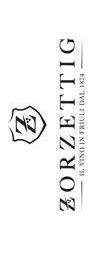



Grapes hailing from the most suitable plots of the estate, low yields and nine grape varieties: these are the main characteristics of the Myò line, labels in which sustainability and tradition are the basis of a modern approach to wine. Among these, the Pinot Bianco ‘20 is an example of fine elegance: the nose perceives notes of white peach, chamomile and clear floral nuances. The fresh, balanced and enveloping sip closes with a long, persistent finish. A true champion that won the Tre Bicchieri 2023. versity that was found in the vineyards before the economic boom, the green manure, the knowledge of the peasant tradition, we bring all this into the present to keep what we have most precious: our soil. Equally important is the personality of our wines, making them become a mirror of the vintage in which they are produced.»
Over time, the company has also proven to be a dynamic and multifaceted reality, with an eye to the future. It has as a matter of fact renewed itself and evolved thanks to new projects with the aim of enhancing a territory. «With the eco -
nomic crisis of 2007 we decided that we had to stop for a moment and rediscover our land, the core of our business and we had time to start a growth path in which quality, value and respect for the territory were the starting elements. It was in this period that the Myò line was born. We are furthermore close to completing the Cantina Viva project: a house of wine that brings together all the wine production steps, but which also takes into account the people who work in it, and the territory... In short, an all-round project in which wine is the main focus.»
Zorzettig – Cividale del Friuli (UD) – fraz. Spessa – s.da Sant’Anna, 37 0432716156 – zorzettigvini.it – fZorzettigVini – $zorzettigvini
We start from Alto Adige South Tyrol, which in terms of mountains, has come a long way in environmental protection and sustainable approach, and continues to do so, in particular in terms of food, wine and tourism. Read on for important stories from this area which can be a positive model for many other regions of Italy. We then expand to other areas where the ski season invites us to have open-air experiences and where the food and wine aspect is also crucial. For the territory itself and for our emotional satisfaction, introducing little-known and significant realities.

words and images by Massimiliano
RellaIf in Bressanone drinkable water is a precious commodity that's bottled, in the picturesque Val di Funes, land of popular mountaineer Reinhold Messner - remember his slogan?
"Altissima, Purissima, Levissima" – the Black Spectacled sheep is a good reason for gourmands to visit; to think that it risked extinction... But what is the link between a country that fights against plastic bottles and a secluded mountain community that values a native sheep variety? Answer: the same common thread that connects a Caldaro winery like Kaltern, which has reduced the use of glass in its bottles, to a Michelin Star restaurant in Nova Levante like Johannesstube, which enhances native, rare, exotic herbs and vegetables grown specifically for its kitchen. That is, apparently there's no connection, but on closer inspection everything makes perfect sense: it is all held together by the glue of sustainability. Environmental, social, economic.
This ambitious triptych of challenges in Alto Adige, a territory capable of creating a common system, has long been a ground for discussion and innovation also in the food and wine sector, with good experience on topics that move sensitivities, consumption and lifestyles across sectors and which accompany us in the years to come with transitions driven by European policies, managed locally and accelerated after the pandemic. One can only go forward: a step back is a misstep.
: un passo indietro è un passo falso.
Among small vegetable gardens, ecocompatible hotels, green restaurants and virtuous suppliers, "ethical" words and formulas such as food safety, wholesomeness, naturalness, find sub-
stance in new actions, behaviours and gastronomic proposals that respect the environment and communities, in a difficult balance with economic sustainability. Examples? Models? Experiences? Even before the pandemic, Bressanone launched the Refill campaign to replace single-use plastic with stainless steel bottles, inviting to fill containers with public water - in the city drinking fountains, chalets, in the Plose points - 26 free charging points for e-bikes outside hotels and restaurants. Everyone furthermore offers water from the valley springs in a glass jug on the restaurant table, for example on the good one of Viel Nois to accompany traditional dishes such as Tris di Canederli (speck, spinach, cheese) and a peasant Rosticciata, panfried beef, potatoes, onions and rosemary that's truly mouth-watering. The jugs are customised with the Viel Wossor logo, translated as "Lots of Water;" the water of a community that protects the
valley, which boasts three wood-fired district heating centres, a municipal one (Energie Villnöss) in which inhabitants are shareholders and a very low-impact landscape of poles, pipes, dangling wires and electric cables flying: none in sight –buried instead like fibre optics.
Obereggen is a well-known tourist resort dedicated to the world of skiing but also known to the gourmand public for its gastronomic offer and its green curiosities. At the Sonnalp Gourmetstube, for example, chef Martin Köhl uses regional products and reinterprets Alto Adige cuisine with Mediterranean influences: the Val Passiria char with Aldein mushrooms on a bed of barley and wild celery is excellent, as well as deer fillets in fir olive oil with pear in red wine, pepper and almond sauce.
Instead, at the Zischghof hotel, the passion for nature has prompted the Pichler family to offer customers guided walks in search of wild and aromatic herbs in

the fields and woods, then used in the kitchen and in the Spa to make homemade creams and ointments. «We offer free mini lessons, themed dishes and natural products – young Walter Pichler tells us – These are experiences that make you remember the hospitality of our territory.»
The latest initiative by Norbert Niederkofler, chef Tre Forchette at St. Hubertus is equally unforgettable. At the top of Plan de Corones, a ski resort at an altitude of 2,000 metres, he created AlpiNN, a restaurant with a spatial view and a concept which, from furnishings to recipes, incorporates the Cook the Mountain philosophy. AlpiNN is a modern mountain stube with large and bright super panoramic windows, white lamps made with pig bladder, larch parquet flooring with interlocking planksno nails - and a ceiling with loden panels painted with cold paint - no water. The open kitchen is entrusted to young Sar-
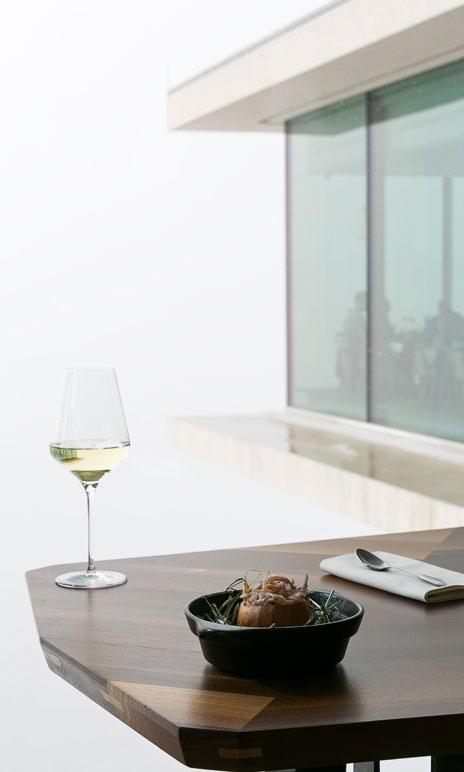

iIt's called Villnösser Brillenschaf, it's the Val di Funes sheep, the result of a cross between the bergamasca breed and padovana breed in the 19th century and it is very efficient in the production of wool, an important economic activity at the time. The Furchetta project, supported by the European Social Fund, has made it possible to enhance this endangered species in the kitchen and in textiles, guaranteeing a fair income to breeders, about fifty farmers in the area of the Dolomites. The project has also trained three ladies of the village to crochet (hats and winter accessories). The wool is also sold to a technical clothing company for the internal lining of sports and mountain garments. Today farmers sell a tonne of it per year, previously they disposed of it for a fee as special waste. For each animal sold, the receipt indicates the meat price and the wool price. The Black Spectacled Sheep, so called because of the "frame" around the eyes (there is also a rare entirely black variant) has tender meat with a fine structure, flavourful, delicate and not very fatty. Mountain breed, light and agile, it is fed on pastures, in the summer at high elevation alpage. Chef Oskar Messner of the Pitzock restaurant, as well as head of the Slow Food Presidium, enhances it by proposing a very tender lamb shank on risotto with herbs, in ragù (also sold in a jar) and with a line of cured meats. «We are happy, it is much more than selling a product – says Messner – The sheep has become an element of tourist-gastronomic attraction.»
dinian chef Fabio Curreli who brings territory and sustainability to the table: no greenhouse ingredients, no citrus fruits and extra virgin olive oil, but meat from animals purchased in full, fermentation techniques, plum ketchup, biodiversity ingredients, wild herbs, mushrooms, aromatic leaves. And no fizzy drinks either, but native juices – elderberry, raspberry, apple, pear – and water from a spring located 100 metres below the ski slopes, filtered and mineralised with Best Water Technology system; 50 cents per litre is donated to well building projects in Asia and Africa. And to complete the list is a single vehicle for the round of suppliers, the "green" energy of Alperia and the separate waste collection done with a snowcat, a single one for all the chalets present on Plan de Corones. Cook the Mountain by Niederkofler is definitely in good company. In the Due Forchette in Nova Levante Johannesstube, the restaurant of the En-
11. Chef Oskar Messner (right) in charge of the Furchetta project for the Spectacled Sheep of the Val di Funes with breeder Bernhard Profanter
2. Onion, onion and Sasso Nero: onion cooked in ashes, au gratin with Sasso Nero cheese from Valle Aurina and crisp sour onion top. Appetiser of panoramic AlpiNN restaurant in Plan de Corones
3. Chef Theodor Falser of Michelin star studded restaurant Johannesstube in the herb and vegetable greenhouse of Eiathhof farm, of young farmer Michael Pfeifer
In the opening, the Sonnalp Gourmetstube, in Nova Ponente (BZ)
1 Onion, onion and Sasso Nero AlpiNN, chef Fabio Curreli
A. A. Valle Isarco Sylvaner R ’20 Köfererhof – Günther Kerschbaumer Varna/Vahrn (BZ) – fraz. Novacella koefererhof.it
The onions are cooked in ash and au gratin with Sasso Nero cheese from Valle Aurina and seasoned with crisp sour onion. The sweetness of the onion and the acidic saltiness of the Sasso Nero recall a gritty and slender white: Sylvaner R accompanies the smoky notes without exaggerating the freshness.
2 Deer, almond puree, cacao, biattl’n Finsterwirt (Oste Scuro), chef Hubert Ploner
A. A. Santa Maddalena V.
Rondell ’21 – Glögglhof
Franz Gojer – Bolzano/Bozen (BZ) fraz. Santa Maddalena – gojer.it
The aromatic complexity of the dish, combined with the personality of the deer and cacao, requires a wine of character and capable of extricating itself from a terrain full of pitfalls. Coming from the most obvious solutions, here is a Santa Maddalena which also offers a great propensity to drink.
3 Whitefish, black root, sumac, buttermilk, red cabbage
Johannesstube dell’Engel gourmet & spa Hotel, chef Theodor Falser
A. A. Pinot Bianco Sirmian ’20 Nals Margreid – Nalles/Nals (BZ) nalsmargreid.com

The delicate whitefish is accompanied by a fine and articulated aromat-
Leaves with an oyster flavour, sparkling watercress, peppery mountain herbs, sweetish amaranth – a vegetable oxymoron – plus "asparagus" lettuce and "strawberry" spinach. On the mountains of Barbiano, among meadows and woods, there is a small farm that grows 800 varieties of fruit, vegetables, herbs and local and exotic plants for haute cuisine. It's called Aspinger De Horto Naturali, where the owner Harald Gasser cultivates a 5,000 square metre vegetable garden with native and non-native essences, hailing from Japan to the Andes. Initially he worked with private individuals then he helped found Manna Organic, a network of virtuous farmers (about ten in the Isarco Valley alone) who rationalise deliveries and reduce environmental impact. Some time ago Gasser clashed with local institutions and the Terna company over a high voltage pylon installed a short distance from his rare vegetable garden.
At Maso Eisath Hof young farmer Michael Pfeifer (internship with Gasser) cultivates 500 rare, ancient, native and exotic varieties over 1,200 metres in height, in the Nova Ponente area. These include Peruvian oca (Oxalis tuberosa) a yellow, crisp, sweet and sour tuber; garlic cress, parsnip, nasturtium tuber (strong, with a spicy finish, the berry treated like a brined "Alpine caper") and many yellow, black tomatoes, "pineapple" tomatoes, "fireworks" tomatoes, oxheart and wild heirloom varieties. At the base there is a naturalist philosophy: zero km, no chemicals, only natural fertilisers, maximum reduction of plastic, recycled pots, silk bags around the plants to avoid cross contamination in the greenhouse. Pfeifer collaborates with the chefs, in particular with Theodor Falser, of Johannesstube (Due Forchette).
ic expression. A white that retraces the same path is certainly this beautiful Pinot Bianco from the high hills: a glass that has the same aromatic finesse and a delicate but incisive sip that marries perfectly with whitefish.
4 Local beef cheek with cinnamon flower and red wine sauce, parsnip puree, herb canederli and potato blatten
Gourmetstube del Sonnalp, chef Martin Köhl
A. A. Lagrein Ris. ’19 Pfannenstielhof – Johannes Pfeifer Bolzano/Bozen (BZ) pfannenstielhof.it
Stimulating dish, where the gustatory fullness of the meat plays the leading role. Requires deep wines with a good structure like this Lagrein: the power of the sip is never excessive
gel gourmet & spa Hotel, chef Theodor Falser proposes Taste Nature: 5, 7 or 9 "steps'' to savour nature and at the same time propose a way of conceiving life. With experience in Switzerland, Dubai, China, Malaysia and Oman, Falser creates contemporary and seasonal cuisine with broad horizons made with local ingredients, vegetable fermentations, miso and other homemade condiments, and collaborates with a young farmer (see sidebar) who supplies hundreds of varieties of tomatoes, herbs and vegetables. An emblematic recipe is his "120 out of 1,200" born from this partnership, which is made of wheat spaghetti from Val Venosta with a sauce made from 120 different tomatoes grown at an altitude of 1,200; all peeled, the skins dried, pulverised and used as grated "cheese." At the base is a black tomato sauce.
Final stop at Tilia di Dobbiaco (Una Forchetta) where chef Chris Oberham-
and the rich fruity expression is perfect to accompany traditional cuisine.
5 Val di Funes Black
Spectacled lamb shank served on risotto with herbs
Osteria Pitzock, chef Oskar Messner
A. A. Pinot Nero Vom Kalk ‘18 Ignaz Niedrist – Appiano/Eppan (BZ) fraz. Cornaiano/Girlan ignazniedrist.com
The character of the shank alternates with delicate vegetable sensations. A Pinot Noir like Vom Kalk, played more on aromatic depth and finesse rather than power, will elegantly accompany this dish.
– Nicola Frasson
mer prepares contemporary cuisine following his Mons Natural Food, a vision that involves a network of farmers with whom he agrees a fair price to support the crops, ensuring constant yield of regional products, seasonal, sustainable, honest, environmentally friendly. Not abstract concepts but tangible goods (and flavours). His symbolic dish is «creamed farro with lettuce puree and smoked wild trout mousse from Lake Dobbiaco,» the trout are caught on a hook by his life partner and sommelier Anita.
Needless to say but Bacchus is a forerunner, not just a tempter. Before the pandemic, the Consorzio Vini Alto Adige launched the ambitious Agenda 2030 sustainability project, in line with the strategic changes set by the United Nations. «It is our path for the future and
involves five fields of action: the soil, the territory, the vineyards, the wine and the people,» underlines Director Eduard Bernhart. Agenda 2030 was born with long de-carbonisation objectives and proceeds year by year on several levels - from biodegradable materials to the prohibition of herbicides, from phytosanitary defence to carbon footprint - involving the community of winemakers to create consensus on the transition in the wine world. There are many actions and ideas and the most innovative, historic or structured companies are already ahead in the game.

Founded in 1142 as the second oldest winery in Italy – after the Castello di Brolio in Tuscany, from the previous year – it can be said that at the Novacella Abbey sustainability is in the "genetics” of facts. At first approach one notices a special care and respect. Among its three vegetable gardens, for ex-
Wineries
Abbazia di Novacella
Varna (BZ) – fraz. Novacella – via Abbazia, 1 0472836189 – kloster-neustift.it
Kaltern
Caldaro (BZ) – via delle Cantine, 12 0461963149 – kellereikaltern.com
Hofstätter
Termeno (BZ) – p.zza Municipi,o 7 0471860161 – hofstatter.com
Pacherhof
Novacella (BZ) – fraz. Varna – via Michael Pacher, 1 – 0472835717 –pacherhof.com
Strasserhof
Novacella (BZ) – fraz. Varna –Unterrain, 8 0472830804 – strasserhof.info
St. Hubertus dell'Hotel Rosa
Alpina Badia (BZ) – fraz. San Cassiano s.da Micurá de Rü, 20

SPECK OF ALTO ADIGE, FAIR TRADE CHOCOLATE AND BUNKER CHEESES
«We are thinking of a sustainability project for the entire production, focused on animal welfare and the further development of renewable energy,» explains the Director of the Consortium, Martin Knoll, underlining a topic that is very much felt today after the increase in costs, despite the fact that hydroelectricity is highly developed in Alto Adige. Through the Speck Academy, the Speck Consortium furthermore organises training courses for restaurateurs, retailers and enthusiasts, with a focus on local gastronomy.
Karuna Chocolate is a Velturno chocolate laboratory, the passion and challenge of Armin and Katya, who select, roast and grind cacao beans from fair trade plantations in South America, Asia and Africa; cacao butter with organic Nacional Arriba from Ecuador and Peru. The products are made with the Bean to Bar method.
Degust, on the other hand, is the place of cheese refiner and chef Hansi Baumgartner, one of the most authoritative in Italy: over 250 specialities, about seventy from Alto Adige, including Alpine cheeses from Trentino, Friuli and Piemonte. His research and selection of artisanal products and dairies – small and medium-sized, which work with raw milk, cow's, goat's and sheep's milk – finds ideal ageing rooms in a World War II bunker located in Rio di Pusteria.
ample, "the flower bed of biodiversity" is an Eldorado of butterflies and insects full of ancient apple trees, free to grow without human intervention. While the garden of aromatic and medicinal herbs contains species used by Saint Hildegard of Bingen herself, a 12th-century Benedictine abbess and scholar of natural and "spiritual" medicine.
At the time a hospice for pilgrims, today the abbey has a public school in German for 90 boys with a campus and sports facilities and welcomes thousands of tourists attracted both by the abbey and by the quality wines that make up the main product of this reality: 850,000 bottles a year (75% white) with attention to typical grapes of the Germanic world, kerner, sylvaner, riesling, grüner veltliner.
«We have existed since 1142 and sustainability has always been a heartfelt and important theme - says Elias Holzer, manager of the cellar - Since 1992 we have been self-sufficient in electricity and heat,
we have a hydroelectric station and one powered by wood stumps from our forests, a thousand hectares of our own woodland. For some time now we have eliminated plastic components, pesticides and herbicides from the vineyards. We only do mechanical weeding.»

On Lake Caldaro the breath of two winds refreshes the vineyards and the valley: they are Ora del Garda (a Mediterranean breath that rises from the south) and a breeze that descends from the peaks of Passo Mendola, scented with pine needles. In this postcard scenario, the dominus is Kaltern, a 4 million bottle cooperative winery, which has grown through successive mergers, the last one in 2016 between Erste+Neue and Kellerei Kaltern. Unity is strength but it involves reorganisations, such as the unification of the cru vineyards under a single line - Quintessenz - linked to a zoning project. In 2018, however, before Agenda
0471849500 – st-hubertus.it
AlpiNN
Brunico (BZ) – loc. Plan de Corones 0474431072 – alpinn.it
Finsterwirt – Oste Scuro
Bressanone (BZ) – v.lo Duomo, 3 0472835343 – finsterwirt.com
Johannesstube
Nova Levante (BZ) – via S. Valentino, 3 0471613131 – johannesstube.com
Pitzock Funes (BZ) – Pizack, 30 0472840127 – pitzock.com
Sonnalp Gourmetstube Obereggen/Nova Ponente (BZ) –Obereggen, 28 0471615842 – sonnalp.com
Tilia
Dobbiaco (BZ) – via Dolomiti 31/b 3358127783 – tilia.bz
Viel Nois Funes (BZ) – San Pietro, 8 0472840526 – vielnois.com
Zischghof Obereggen/Nova Ponente – Obereggen, 9 0471615761 – zischghof.it/it
Leitlhof
San Candido (Bz) – via Pusteria, 29 0474913440 – leitlhof.com
Löwenhof
Varna (Bz) – via Brennero, 60 0472836216 – loewenhof.it
Aspinger De Horto Naturali Barbiano (BZ) – Saubach, 29 3357085311 – aspinger.com
Degust Varna (BZ) – Bsackerau, 1 0472849873 – degust.com
Karuna Chocolate Chiusa (BZ) – Prato dell’Ospizio, 12) – 4° piano karunachocolate.it
Maso Eisath Hof Nova Ponente (BZ) – Rio Nero, 12 –feisathhof
Info
Ente Turismo Alto Adige suedtirol.info
Ente Turismo Bressanone brixen.org
Idm Südtirol idm-suedtirol.com
Lago di Caldaro kalterersee.com
Latemar (stazione sci) latemar.it
Plose (stazione sci) plose.org
2030, Kaltern adhered to Fair & Green, a sustainability certification created by German wine makers for wine producers. The project has taken into account various actions: green manure between the rows and creation of green islands in the vineyard with typical essences and olive trees to increase biodiversity; a solar panel roof that ensures 45% of energy; free bike rental to local employees to reduce pollution.
«But the biggest action - underlines oenologist Andrea Moser - was on the weight of the bottles, since 60-70% of the carbon footprint of a finished product is attributable to glass. For the Quintessenz line we have dropped from 800 to 500 grams, eliminating 39 tonnes of glass out of a total of 130,000 pieces. On the Classica line, 1.3 million bottles, the weight has dropped from 520 to 470 grams with a glass saving of 65 tonnes every year.»
Another story. Strasserhof is one of the oldest wineries in the Isarco Valley, located 700 metres above sea level in a sunny position. Producer Hannes
Baumgartner also leads the Alto Adige Winegrowers Association, 105 small vignerons with 1-2 hectares of vineyards which together represent just 5% of the provincial production. «But we are registering a good trend of conversion to Organic farming: already 35 of us are – points out Baumgartner – Sustainability is an important transition, not a slogan, and we need to take it one step at a time. It's been 10 years already that we've eliminated herbicides, but for Alto Adige it is a complex project and an ambitious goal: we have 5,000 farmers who do other things as their first job, for them reducing or eliminating herbicides means longer working hours. The results will be seen in the long run, the important thing is to have started.»
Hofstätter is a well-known winery in Termeno, one of the largest privately
owned in the Alto Adige province: 55 hectares of vineyards, a network of trusted suppliers for another 80 hectares, an enoteca wine shop under the historic vaults of the centre, the cellar in a sixteenth-century mansion and a tasting room inside a modern "wine tower" panelled in wood, a vertical architectural challenge facing the bell tower of Santi Quirico e Giulitta. «Sustainability is a delicate issue - Martin Foradori Hofstätter begins - With great changes come more natural alternatives to cultivation, but I notice a radicalisation on both sides. The correct way is in the middle: there is something positive in the conventional that makes use of modern technologies as well as in the trend of natural wine. Let's take herbicides: today there is no need, there are machines that do not damage the vineyard. Plastic materials have long since disappeared: biodegradable materials and metal poles are used for bindings, which are more durable than wooden ones. However, we must ask ourselves at community level what hap-

pens with phytosanitary treatments: is there more impact with different copper treatments, or with a single targeted conventional treatment, when it is necessary? What's more natural?»
Interesting questions, which we can also translate into the architecture of wine. I mean, what's more natural? The ancient or the modern? Pacherhof is the perfect answer: a hotel with outdoor swimming pool, Tyrolean stube and restaurant (whose philosophy is "from the garden to the plate") and a cellar that is a model of the combination of tradition and modernity, in shapes and materials. It is the small kingdom of wine producer Andreas Huber. His sister Monika, on the other hand, manages the accommodation facility with the help of her husband Michael Laimer, former provincial energy councillor, in short, someone who knows the subject. As a matter of fact the entire structure is powered
100% by renewable energy sources and has been connected to district heating for 20 years in the municipality of Varna, fueled by wood. But the most emblematic thing concerns the architecture of the cellar, designed by Bergmeisterwolf studio in Bressanone.
«According to a provincial law that protects the integrity of monuments recognised as historic - Laimer begins - the modern architectural interventions are distinct and therefore cannot come into contact with the old and protected areas of the ancient farm.»
Old and new, near and far, touch each other without ever touching: small gaps, separating spaces filled with stones, mini supports that distance an electric cable by a few centimetres from contact with a historic wall. Everything down to the smallest detail, in pure Tyrolean precision. Sustainability is said to require extra effort and pay off in the long run. Commitment to the present, investment in the future.

Wrinkled on the outside, lighter and more crumbly on the inside, irregular shaped, strong flavour and penetrating smell: Graukäse is an excellence of the Valle Aurina, an artisan product made at home for centuries. Today it is produced "commercially" by three small producers. Translated from German as "grey cheese" it is an Alto Adige excellence that's increasingly valued by the dining sector. It is the oxygen for the sustenance and sustainability of the supply chain.
«Chefs use it in the most creative dishes and young people are starting to show interest. It was included in the teachings of the professional agricultural school of Tedone, near Brunico,» says Martin Pircher , head of the Slow Food praesidium.
Graukäse belongs to the family of acidic coagulation cheeses: made with skimmed milk acidified by heat or with the addition of sour milk or whey from the previous batch, primarily using the milk of Bruna Alpina and Pinzgauer cow breeds. The production process is important: the skimmed milk from the cream used for butter is mixed with the following day's milkings, up to 6 (the equivalent of 3 days). This promotes natural acidification. The proteins coagulate when heated to 45°C. With a skimmer, the curd is collected in wooden baskets, sprinkled with a pinch of salt, stirred and pressed by hand to release the whey. It ages for an average of 4 weeks.
4. View of Lake Caldaro (Kaltern) from the vineyards
5. Michael Laimer in the family cellar, Pacherhof, in Varna (BZ)
6. Wheels of Graukäse in maturation: the "grey cheese" Slow Food praesidium of Valle Aurina

Much progress has been made since the winery was founded in 1964 by Luigi Calatroni. Cristian and Stefano Calatroni’s lovely winery is now increasingly focused on eco-sustainable choices and belief in its sparkling wine, with new Metodo Classico wines that undergo considerable ageing and research into the Versa Valley’s best crus. We are in Oltrepò Pavese, just over an hour’s drive from Milan, in the cradle of Italian pinot noir. There are two Calatroni brands: Calatroni refers to their portfolio of metodo classico wines, while Mon Carul identifies the rest of the catalogue, with an eye on Riesling.
THE WINERY IN FIGURES
30 owned hectares
130,00 bottles produced 25% export
Precisely the production of classic method cuvées has grown a lot both in terms of quality and quantity. “This year we produced 70,000 bottles of Metodo Classico, the idea is to gradually reach 120,000 units over the next 5 years. We purchased another 12 hectares, mainly of pinot noir, in Montecalvo Versiggia. Here the grapes are exposed to the east, despite increasingly hotter years, the maturation is prolonged, we never harvest grapes before the end of August and September, which yield a natural acidity of 9-10 grams per litre. And the calcareous and clayey
soils accentuate minerality: in this way we can really go all in,” Stefano Calatroni tells us. In the meantime, wine tourism has also become a major area of focus. Thanks to the precious support of Elisa Nervetti, the Calatroni family is carrying steadily with inexhaustible energy. “We are working a lot on experiences in the vineyard, the harvest, in order to bring people closer to our wines. It is a type of service that is increasingly targeted and calibrated on our cellar,” adds Stefano. Returning to the production, there are many novelties in the pipeline, with an increasingly targeted work on parcel selections of great character. Poggio dei Duca has been released a couple of years ago, a Blanc de Noirs that tells the story of a single special area in the municipality of Rocca de’ Giorgi, while shortly, with the 2018 harvest, the new cru will be presented: Riva Rinetti. “It will always be a Pinot Noir,

Discovering one of the emerging wineries in the Italian Classic Method scene, the Calatroni brothers produce some of the most complex Blanc de Noirs of the Peninsula
OP

It has everything you’d expect: aromatic finesse, pronounced aromas of raspberries and strawberries, a creaminess endowed by its fine sparkle, and notable overall com-

pleteness. Tre Bicchieri!
OP M. Cl. Pinot Nero Pas Dosé Cuvée Rosé 2015
Little colour, lots of flavour. It is a refined Blanc de Noirs, with very fine perlage. On the palate it is also complex and multifaceted, just a bit saggy on the finish due to the warm vintage.
Pinot Brut 64 Metodo Classico
It is the cuvée that expresses the company style, the result of several blends of vineyards and different clones of Pinot Noir. At least 30 months on the lees for a sparkling wine that combines balsamic character, floral notes and gustatory verticality.

Duca 2017
In its second season, the new cru from the highest parcel of pinot noir in Rocca de’ Giorgi, 550 metres above sea level, shows off a sensational performance despite the certainly not favourable vintage. It strikes us in particular for its wide, rich and delicious nose, followed by an enthralling mouth with energy and a great savoury jab. Wow.
Riesling Campo Dottore 2021

We close with Riesling, another forte of the Calatroni brothers, who also produce an excellent reserve. The 2021 vintage plays on buoyant, delectable fruit. On the palate it is crisp, clean and lively.
from a bank between 400 and 450 metres in the municipality of Montecalvo Versiggia. It will rest on the lees for 48 months and will be a Pas Dosé. 4,000 bottles produced.” But the ebullient brothers do not stop there, there is also a new cuvée in the pipeline produced according to the Solera Method, the result of the last 5 vintages, which will rest on the lees for about 24 months. From the tastings for our Guide, what emerges is an impressive quality of the whole battery, in particular the
Calatroni – Località Casa Grande, 7 - 27047 Montecalvo Versiggia (PV) www.calatronivini.com
hand of oenologist Christian, silent hard worker, who is very happy with the rosé cuvées, regularly ranking the highest scores nationwide. “He started making rosés with Nebbiolo, he brought that lesson to Pinot Noir, he doesn’t do maceration, thermal management is essential to maintain complexity and finesse. Christian has an incredible sense of self-sacrifice, he only thinks about work, his is a true vocation unlike any other,” smiles Stefano.
Cruasé Extra NorEma 2019
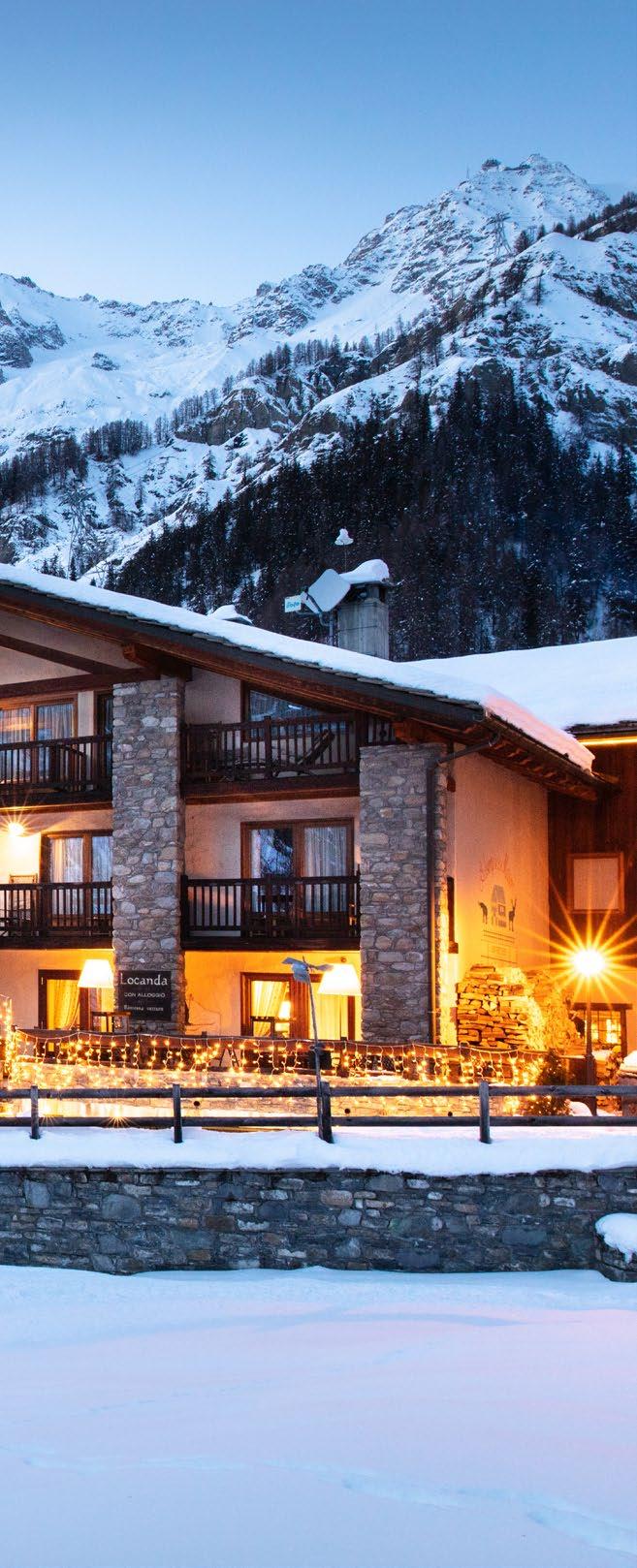
Italy is full of beautiful landscapes and mountain areas that have nothing to envy the coasts surrounding the Peninsula, both in summer and in winter. January and the colder months are definitely the best time to enjoy the snow, sports and to give space (with less remorse) to dining. Combining appetite and satisfaction with the quality of the offers and also linking the experience to a deeper knowledge of local traditions and culture of the places known for skiing or snowshoeing. Read our list of itineraries around the most famous winter ski slopes from North to South.
by Clara Barrafrazione Entreves via Passerin d'Entreves, 16a 0165 869811 – aubergemaison.
it
L'Auberge de la Maison welcomes guests in a setting where the most traditional architecture is reflected in a very charming setting. The beloved restaurant tells the story of the area with dishes of substance, and fine wine list (also offered by the glass).
Cadran Solaire via Roma, 122 0165 844609 cadransolaire.it
The Leo Garin family runs one of the most refined restaurants in the town, complete with a terrace. here the protagonist is alpine cuisine – created by the talented chef jeanmarc neuville – paired with
Courmayeur (AO)

Auberge de la Maison
Cadran Solaire
Pierre Alexis 1877
substantial wines (even by the glass).
Pierre Alexis 1877 via G. Marconi, 50a 0165 846700
In the pedestrian area, here is a charming "living room" that combines mountain details with modern design elements. the kitchen offers revisited regional recipes (think, mountain ramen) or traditional italian dishes. valid wine list, lunch menu.
Pizzeria Du Tunnel via Circonvallazione, 80 0165841705
pizzeriadutunnel.it
All rooms, finished instone and wood, retain the typical mountain atmosphere. their pizza is prepared with great care and baked in a woodfired oven. the careful choice of ingredients guarantees a remarkable result. the menu offers more than thirty pies.
Pizzeria Fuoripista s.da delle Vittorie, 13 0165842118 losciatore.com
At the foot of the ski slopes, near the dolonne gondola lift, a restaurant designed in full mountain style: run by the grosso family, maria casella and her sons roberto and angelo.
La Thuile (AO)
An intelligent place that takes advantage of the space of a luxury hotel, where design plays a significant role. the restaurant offers meals across the board, thinking of both hotel guests as well as gourmands who come from
outside. multifaceted menu, adequate cellar. Chocolat fraz. Entreves 0165884783 chocolat-collomb.it
For over 40 years, Stefano Collomb's restaurant has been a must for tourists and regulars. stefano is a master of chocolate (the now famous tometta, a 350 gram praline made with milk chocolate, gianduia and hazelnuts from piemonte, is his "calling card") but at chocolaT there is much more.
Pré Saint Didier (AO)
Croquembouche
av. du Mont Blanc, 39 3385662263 pasticceriacroquembouche. it
It is a place appreciated for the varied and high
quality offer, from sweet to savoury, driven by ingredients chosen with great care. all production is strictly artisanal, the aosta valley specialties are well represented and faithful to tradition, flanked by modern creations.
Saint Vincent (AO)
Morandin via E. Chanoux, 105 3476872091

mauromorandin.it
Mauro Morandin was raised in the footsteps of his father rolando, a pastry chef much appreciated in italy and abroad. maître patissier and chocolatier of great fame and ability, assisted by his wife barbara, he works according to tradition, proposing family recipes made with strictly artisanal methods and ancient machinery..
Auberge de la Maison (also in the opening photo). A refuge for the soul and for fine living: a mountain home, at 1,300 metres, with a view of Mont Blanc where you can breathe all the charm of Alpine tradition and hospitality. The cuisine of the Auberge Restaurant shows how much the Garin family aims to pamper their guests with the highest quality ingredients, and with an eye to the territory

PRODUCTS & TERRITORY. FONTINA, GENEPY E LARD D'ARNAD
FONTINA DOP. Protected Designation of Origin cheese with a milky scent, sweet taste and a soft, melting texture in the mouth. A much imitated cheese, but if you know it you can't confuse it with any other! Fontina is the Valle d'Aosta: it is strongly linked to the territory, to its pastures, to the cows that produce the milk (of three native breeds: Valdostana Pezzata Rossa, Valdostana Pezzata Nera and the Castana) which then becomes an exquisite cheese. 169 members are part of the Consortium and about 400,000 wheels of Fontina are branded every year.
GENEPY The symbol of Valle d'Aosta is also Genepy, a liqueur made from genepy seedlings (Artemisia glacialis), an alpine herb that grows on the mountains. It was Laurent Ottoz who started the production in 1902, returning from an experience in a glorious French distillery.
LARD D'ARNAD DOP . It is a tasty and fragrant cured meat aged with salt, spices and mountain scents that give it unrepeatable aromas and flavours. Product of excellence from the Arnad area in Valle d'Aosta, since 1996 the only PDO certified lard in Europe. Excellent to use in the kitchen, but also to be enjoyed slathered on slices of warm bread, as an aperitif and appetiser.
Al Filò via Dante, 6
0342 901732 – ristorantealfilo.it
Popular for many years, the restaurant offers a welcoming environment, housed in an old barn with stone vaulted ceilings and local cuisine, without remaining trapped in rigid tradition. in the cellar the best of the valtellina wine production.
Vecchia Combo
piazza del Crocefisso, 4
0342 901568 – fVecchia-Combo
Located near the ski slopes is a characteristic, warm, familiar place, with over half a century of history, where guests can savour the well executed tasty repertoire of the typical recipes of valtellina cuisine, paired with labels from the area.
Kosmo via Bondi, 473 346 1152048 – kosmotastethemountain. com
In a very pleasant modern environment, guests can enjoy a naturally super seasonal cuisine, without waste, based on relationships of trust with producers and ethics in the full sense of the word, characterised by intensity and elegance. Well organised cellar.
Madesimo (SO)
Il Cantinone dello Sport Hotel Alpina via A. De Giacomi, 39 – 034356120 ristorantecantinone.com
The viaggio in Valchiavenna is the expression of the culinary thought of Stefano Masanti, an expert professional who deeply loves his land but is not limited by it. il cantinone has always expressed an intense cuisine, based more on local products than on traditional recipes. there is a refined and contemporary vision of the dishes, whether they be game or freshwater fish, all of which conquer at the first taste.
MA! Officina gastronomica
Via A. De Giacomi, 7 3895180572 – maofficinagastronomica.com
Stefano Masanti and stefano ciabarri also manage ma! gastronomic workshop where they produce (and sell online) the typical cured meats of this alpine valley in the far north of italy.
Pasticceria Criollo
p.le G. Bertaccchi, 77
03421900327 – pasticceriacriollo.site123. me
Located in a strategic position - in a lively and busy area, a stone's throw from the station - the well-kept restaurant of francesca poletti and diego calderazzo, both pastry chefs, never disappoints.
A dish by Kosmo, a new restaurant in Livigno that offers a culinary experience of the area reinterpreted with contemporary eyes

Madesimo (SO)
Il Cantinone dello Sport Hotel Alpina
MA! O cina gastronomica
Berbenno di
Traona
Premana Lago di Como
Bormio (SO)
Bistrò Alpino del Montana Lodge
Vecchia Combo
Sondrio
Pasticceria Criollo
Livigno (SO)
Kosmo
Valtellina


SanBrite
Tivoli
La Stube Gourmet dell'Hotel Europa
Residence
corso IV Novembre, 5 0424 462659
stubegourmet-asiago.it
Gourmet space in the well-known hotel of the mosele family (which has other tables), which in an elegant setting offers a cuisine with personality, with clear references to the territory. interesting and wellconstructed dishes, quality cellar.
La Tana Gourmet località Kaberlaba, 19 0424 1760249
latanagourmet.it
Dlessandro Dal Degan, crystal clear talent, in recent seasons has further raised the rate of avant-garde, instinctive cuisine, but assisted by great technique.
the dishes are one more interesting than the other. to complete the picture, a large wine list. reservations mandatory..
Da Tata p.le Stadio del Ghiaccio, 15 0424 462082 –fTataPizzeria
PIZZA ALL’ITALIANA .Italian pizza. A historic place that is approaching 45 years of history and which maintains the familiar and informal atmosphere of the mountain bar, in a central position, near the ice stadium. on the table a proposal that is not at all obvious, centred on wellmade pizzas, starting from the dough, offered in various variations: with whole grains, semi-whole with moringa and the truly remarkable "mondiale".
Da Aurelio Rifugio Piezza
località Passo Giau, 5 0437 720118 – da-aurelio.it
The splendid panorama that can be enjoyed from the tables in the glass room alone is worth coming here. but obviously luigi dariz's cuisine is also an excellent reason to reach this enchanted place. rich and very interesting wine cellar.
Baita Fraina
località Fraina, 1 0436 3634 – baitafraina.it

A welcoming place, surrounded by greenery, managed for years by the menardi family, the kitchen offers dishes anchored to the flavours of the territory without disdaining some more original combinations,
always respectful of local ingredients. well stocked wine cellar
Al Camin località Alverà, 99 0436 862010 ristorantealcamin.it
A cosy place not far from the town centre. the menu revisits traditional recipes with skill and creativity, with some variations, the fine selection of wines is curated by chef and owner fabio pompanin himself.
SanBrite località Alverà, 200 0436 863882 – sanbrite.it
Chef Riccardo Gaspari is one of the masters of the naturalterritorial philosophy (which he defines as "agricuisine"), a proposal that enhances ingredients, treated with some innovative licence and a precise hand. grand selection of "his" cheeses.
Pieve di Cadore Santo Stefano di Cadore Vodo di Cadore Farra D’Alpago Vittorio Veneto Feltre Borgo Valsugana Trento Sassolungo Monte Antelao Monte Cristallo Veneto 10 km La Stube Gourmet dell'Hotel Europa Residence Asiago (VI) Da Aurelio Rifugio Piezza Colle Santa Lucia (BL) Baita Fraina Cortina d'Ampezzo (BL) Al Camin Chalet Tofane La Tana GourmetTivoli località Lacedel, 34 0436 866400 ristorantetivolicortina.it
A few minutes from the town centre, is an elegant restaurant with a large terrace, for years in the hands of chef graziano perst whose forte is using firstrate ingredients, knows how to arouse emotions with his dishes. the cellar is increasingly rich, with a considerable depth of vintages.
Chalet Tofane loc. Lacedel, 1 0436 863026 – chalet-tofane.it

At the start of the lifts that lead to the olympic slopes of tofane, is a place with an eclectic and well-curated offering. since the opening, the managers (graziano perst, chef of the Tivoli restaurant and sommelier Kristian Casanova) have given pizzas a leading role.
Chalet Tofane in Cortina

d'Ampezzo: here, right where the lifts leading to the Tofane Olympic slopes start, the chef of the Tivoli, Graziano Prest, and his sommelier, Kristian Canova, have given ample space to pizza (photo Diego Badion)
PRODUCTS & TERRITORY. LAND OF PROSECCO AND OF ASIAGO DOP ASIAGO DOP. A cheese that comes from a territory where nature and man have always lived side by side. A geographical environment that embraces mountains and plains passing through the soft hills of Vicenza. Only here, the variety of vegetation echoes a particular microclimate: a territory that gives rise to a great milk (from the native breeds Bruna Alpina, Burlina, Frisona Italiana, Grigio Alpina, Pezzata Rossa, Rendena) from which a great cheese derives. Asiago DOP is produced in a limited geographical area: in Vicenza, Trento and in a part of the provinces of Padua and Treviso. Depending on the production areas and ageing periods, Asiago is offered in the following types: Fresh, Riserva, Vegetable Rennet, PDM (mountain product), Mezzano, Vecchio, Stravecchio, Aged Vegetable Rennet, Aged PDM.
PROSECCO DOC & DOCG. The Glera cultivar grapes and the sparkling process are common to both the DOC and DOCG labels. To differentiate the two denominations are the territories and the disciplinary on the winemaking process. Almost all the provinces of Veneto plus Friuli-Venezia Giulia are involved in the Prosecco DOC. The DOCG, on the other hand, is produced and bottled only in a few municipalities in the Treviso area, between Conegliano and Valdobbiadene and on the hills surrounding Asolo: hills that have received UNESCO recognition as a World Heritage Site.
TRENTINO-ALTO
Canazei (TN)
La Stua de Sorices del Rifugio Carlo Valentini
El Cianton dell'Albergo alla Rosa
El Pael
Il
Bolzano
Trento
Ora
Stube
Trento
El Pael via Roma, 58 0462 601433 – elpael.com
The Anesi family has been running this typical restaurant for over 70 years. located in the heart of the village, it offers dishes from the val di fassa, without neglecting some pleasant digressions. great attention to wines, with a wide range of labels.
La Stua de Sorices del Rifugio Carlo Valentini località Passo Sella
0462 601183 rifugiocarlovalentini.com
The jewel of this historic refuge at 2,218 metres above sea level, with comfortable rooms and views, in the gourmet cuisine managed by gaetano bonanno, who combines the standard offer with a contemporary vision.
Cavalese (TN)
Costa Salici
El Molin
Excelsior
Bolzano
Moena (TN)
Malga
Vigo
L
Corvara
La
the wine selection works well.
Costa Salici via Costa dei Salici, 10 0462 340140 – costasalici. com
The home of the Tait family, now represented by Stefano in the kitchen, is a warm and characteristic meeting place that brings together lovers of tradition and more curious customers. local ingredients and a moderate dose of flair are the base of each dish.
Excelsior
piazza C. Battisti, 11 347 2134013 alessandrogilmozzi.it
Small, welcoming, with an informal atmosphere, is the pizzeria wanted and created by well-known chef Alessandro Gilmozzi. the pizzas, in about twenty
variations, have as a common denominator the lightness of the dough, the quality of the ingredients and the art of baking.
El Molin piazza C. Battisti, 11 0462 340074 alessandrogilmozzi.it Alessandro Gilmozzi is a passionate ambassador of his mountain. his alpine cuisine finds its maximum expression in the choice of unusual but very local ingredients, in the study of ancient recipes, in the use of smoking and cooking over an open fire.
Il Gallo Cedrone de l'hotel Bertelli via Cima Tosa, 80 0465 441013 ilgallocedrone.it
The property's commitment to bring haute cuisine to the wonderful setting of Madonna di Campiglio continues. and it gets better with imaginative preparations, which play with local suggestions or picking ideas in the mediterranean tradition. quite an extensive wine list.
Stube Hermitage del Bio hotel Hermitage via Castelletto Inferiore, 69 0465 441558 stubehermitage.it

The tables on the terrace are added to the tastefully furnished wooden stube, with a view of the peaks of Madonna di Campiglio; the philosophy of the kitchen marries the sustainable approach of the hotel that houses the restaurant. valid cellar.
Malga Panna frazione Sorte strada de Sort, 64 0462 573489 malgapanna.it
Rooms furnished in a refined mountain style are the backdrop to the cuisine of paolo donei, descendant of the family that has owned the restaurant for generations. substance, balance, elegance, and select ingredients are the basis of his excellent dishes
Da Anita via Cavallazza, 24 0439 768970
ristorante-da-anita.com
The menu offers the trentino tradition with a few more
refined touches, even in the presentation of the dishes. pasta, bread and desserts are all homemade, the vegetables and herbs come from the property's garden. good wines, warm service. we suggest reserving a table.
La Pajara Gourmet de l'hotel Castel Pietra frazione Transacqua via Venezia, 28 0439 763171 lapajaragourmet.it
Offre ai suoi ospiti una proposta eterogenea, strizzando l’occhio alla tradizione locale senza trascurare suggestioni extra, riconducibili alle origini salentine del patron. Lista dei vini adeguata, ambiente accogliente e curato.
L Chimpl de l'hotel Gran Mugon strada de Tamion, 3 0462 769108 – lchimpl.it
Stefano Ghetta's cuisine is based on the territory and on the goodness it offers seasonally. his recipes with a modern and elegant style, are strongly identifying, and which shine for technique, sharpness of flavours and aesthetic appeal.

Above, a dish from Stube Hermitage restaurant at the Bio Hotel Hermitage
El Pael (left): the room where the cellar of the Canazei restaurant opens onto, where the Anesi family offers modern local cuisine and pays great attention to the selection of wines with a wide choice of labels and depth of vintages (photo Monica Condini)

Mondschein - A
I salumi di Carnia via Guart di Luincis, 34 0433619043 – isalumidicarnia. it the year was 1940. it all began with renato beorchia, a professional high altitude dairyman. today he is replaced by his nephew who, in addition to having the same name, keeps intact the family passion for work done well and genuine products together with his father rinaldo. his grandfather's farm is no longer there, but renato personally chooses the pork from regional farms.
Laite borgata Hoffe, 10 0435 469070 ristorantelaite.com
in an authentic ancient sappadina residence, two
rooms with a magical atmosphere frame one of the best gastronomic experiences on the peninsula, not only for the excellent cuisine of fabrizia meroi, but also for the impeccable service and the impressive wine cellar.
Mondschein -

A Taste of The Dolomites Golf Club Sappada
b.ta Palù, 96 – 0435469585 ristorantemondschein.it with commitment and dedication, the kratter family has transformed a typical mountain chalet into an interesting gourmet address. in an elegant setting, with an elegant mountain style, guests can enjoy a menu that draws inspiration from local traditions without being predictable, made up of well-executed dishes that combine a great knowledge of ingredients with the ability
to enhance them.
La Bottega di Sappada Borgata Palù, 15 0435469847 labottegadisappada.com
In the centre of the town, a place that offers a warm welcome as well as complete availability from the two owners, massimo and michela who have selected numerous specialties and, with great passion, have scoured the whole area in search of ''friendly'' producers and refiners capable of guaranteeing quality and authenticity of their products.
Alla Pace
fraz. Sauris di Sotto via Roma, 38 – 043386010 ristoranteallapace.it among the well-kept wooden houses in the centre of sauris, this traditional trattoria of the
schneider family preserves the gastronomic history of the place. the cuisine feeds on local products (try the sauris ham, lightly smoked with beech wood) to bring typical local recipes to the table, such as the ever-present cjalsons, garden soups, roasts and braised meats. the desserts are good, the wine list focuses on regional productions.
Prosciuttificio Wolf Sauris via Sauris di Sotto, 88 043386054 – wolfsauris.it The business has been handed down from generation to generation by giuseppe petris who, in 1962, created the wolf prosciutto manufacturing, now entirely managed by the Petris family. the meat is italian pork from the Modena and Parma ham districts, worked by hand and by machine, without any gluten. among the
many products there are culatello, ossocollo, salame, cotechino, pancetta, lard with herbs, guanciale, rump and shin, even if the flagships of the production are prosciutto and speck.


Salumificio Molinari via G. Cesare, 26 – 3356260831
salumimolinari.it
Artisan company located in the heart of carnia, in zuglio, in the but valley. located more than 400 metres above sea level, in an area propitious for intercepting air currents capable of characterising the ageing of cured meats. tradition is the point of reference for this meat curer, which has its roots as far back as the 18th century: selection of heavy friuli pigs (partly from their own breeding), fed on self-produced grains and slaughtered according to an ancient home method handed down for generations. particularly smoking with beech wood.
It is a DOP prosciutto produced by 31 companies in the municipality of San Daniele del Friuli (UD). Its only ingredients are Italian pork legs, sea salt and the microclimate of San Daniele. No kind of preservative is used. The pigs are born, raised and slaughtered in Friuli-Venezia Giulia, Piemonte, Lombardy, Emilia-Romagna, Veneto, Marche, Umbria, Tuscany, Lazio, Abruzzo. All processing phases must take place within the municipality of San Daniele. The production cycle lasts at least 13 months. The fresh thighs must weigh no less than 12 kg and keep the "hoof", which in addition to being a tribute to tradition, facilitates the drainage of humidity.
A dish from the Laite restaurant, Tre Forchette in Sappada: fondant venison (photo Nicolò Brunelli)
Left: pigs grazing outside Salumificio Molinari, located in the heart of Carnia, in the Valle del But, in an area particularly suitable for curing pork meats

San Rocco
corso Umberto I, 39 – 0536 62382
fRistoranteHotelSanRoccoSestola

Since 1972, a hotel restaurant also open to passing gourmets, managed since the beginning by the Bertola family. the judiciously creative cuisine satisfies even the most demanding palates and is supported by a rich selection of wines.
Il Cantacucco
loc. Missano – via Montalbano, 5500b 059985067 – ristorantecantacucco.com
In this restaurant on the modena hills guests can taste excellent cured meats, cheese, mushrooms, mora romagnola meats, chestnut flour, chicken and rabbit dishes. carla transforms them in tasty recipes such as: tortellini in broth, venison braised in malbo gentile wine with polenta and, among the desserts, zabaglione parfait with caramelised pears.
Da Amerigo
fraz. Savigno – via G. Marconi, 16 0516708326 – amerigo1934.it
Amerigo is in the heart of many gourmets. Alberto Bettini is an old-fashioned innkeeper, few words but a lot of substance in driving a small ship that set sail in the bologna hills in 1934 and then gradually became increasingly reliable. giacomo orlandi masters the ingredients of the apennines perfectly in the kitchen, he knows the tradition in depth but puts a pinch of personal flair into it. the result is delicious and satisfying dishes contained in a seasonal menu that also bears the date of its creation.
Irina Trattoria
fraz. Savigno – via G. Marconi, 39 3451608382 – irinatrattoria.it
Irina Steccanella is an energetic, passionate and always up-to-date cook. the cuisine proposal is absolutely local of emilia in vocation with the privilege of drawing on a wealth of ingredients of great value from the bolognese hills including cured meats, cheese, mushrooms and truffles in season.
In Bottega via G. Mazzini, 2b 3703025102 – fin bottega vignola Tigelle, crescentine and focaccia are baked here starting from three types of dough (traditional, wholemeal, vegan with organic farro flour) well leavened until, once baked in the different types, they are soft and crunchy to taste. lucia boni's restaurant offers a menu of four differently filled tigelle, also with an option for vegetarians.
Pasticceria Gollini via Garibaldi, 1n – 059771079 – tortabarozzi. it
It is to Eugenio Gollini that we owe the worldwide diffusion of the Barozzi cake. A special dessert, soft and delicate, whose recipe is jealously guarded (only a few ingredients are known: dark chocolate, almonds, peanuts, eggs, butter and sugar). A family story that began long ago.
Rivisondoli
Da
Alt Stazione del gusto
s.s. 17 km 150,3
0864 238032 – it looks like fast food but it's not, here they cook with care, and everything is fresh, starting with the now legendary fried chicken and delicious chips. do not miss the bombe, both in the sweet and in the savoury version. there is no shortage of pizza and stuffed focaccia.
Materia Prima
piazzale Prato Cardillo
0864 238030 – Annexed to the luis hotel, but with a completely separate life, in a modern and minimal environment, it guarantees an allround level sojourn. Merit of this is the staff both in the dining room and in the kitchen, who with skill and enthusiasm create seductive and flavourful dishes.
Reale
località Casadonna
0864 69382 – nikoromito.com
Passion, research, humility, study have allowed niko romito to rightfully enter the small circle of the best italian chefs. His cuisine expresses itself at high levels through clean and essential flavours. Important cellar, beautiful rooms.
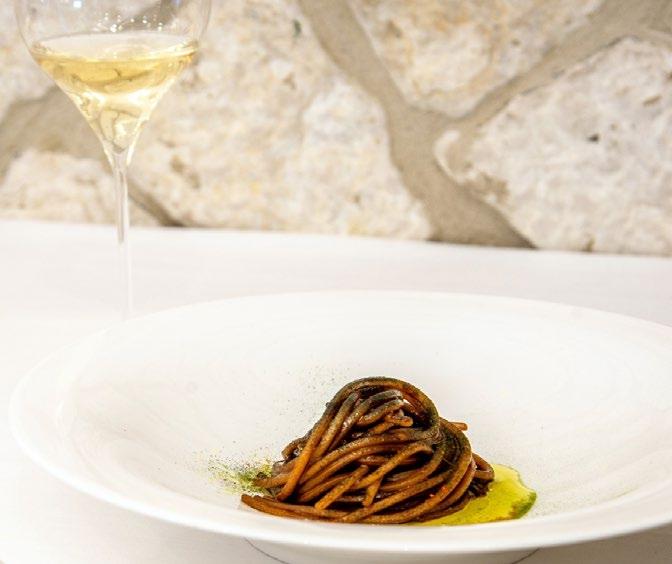
Da Giocondo via Suffragio, 2 0864 69123 – ristorantedagiocondo. it
Solid reference of the area, welcoming and characteristic, family run. Local tradition has always ruled the table in a homely guise, with the whole repertoire of mountain abruzzo elaborated with genuine ingredients.
Chichibio via G. Marcone, 1 328 9054831 – fchichibioroccaraso raffaele trilli and cinzia reale, united in life and work, a few years ago managed to fulfil their dream of opening their own restaurant in the heart of town. Here they offer a cuisine that focuses on reinterpreting traditional products and recipes.
Spaghetti with fermented mountain red garlic, wild garlic powder, Peranzana olive oil and Altino
chilli: a dish by chef Raffaele
Trilli of Chichibio in Roccaraso Opposite page, pizzicotti of Modena ricotta with porcini mushrooms of Cantacucco restaurant
Silafunghi Campanaro
Sorelle Falcone
Macelleria A’
La Tavernetta Ristorante contrada Campo
San Lorenzo, 12 0984 452630
sanlorenzosialberga.it
A short distance from lake cecita (the largest in the region) and from the ski resorts, the lecce family restaurant – now in the hands of the young emanuele and his talent
– guarantees an all-round pleasant stop, from gourmet to hotel.
Silafunghi Campanaro via Roma, 38 – 3283682402
The counter of this historic shop located 30 km from the city but already in the heart of the cosenza sila, is stocked with the best the area can offer in terms of

cured meats, cheese and dairy products. You can buy them, taste them as an appetiser in the adjacent restaurant but also ask to combine them according to taste in sandwiches served hot or cold. Perhaps adding some other good local ingredients, such as porcini mushrooms in olive oil flavoured with garlic and chilli pepper and the excellent "ammaccata" olives.
Sorelle Falcone via Roma, 13 3478549077
f sorelle falcone
In direct connection with the family butcher shop, 'a chianca, enterprising sisters alessandra and federica have created a really interesting little place. People come here to have breakfast with homemade desserts and
coffee, but above all to taste sila specialties and quality meats cooked as they should in an informal and relaxed atmosphere. There is no shortage of cheese and cured meat platters with pickles, dishes of the day and delicious desserts, such as cheesecake.
Macelleria A’ Chianca via Roma, 11 0984578319 salumificiofalcone.it Selected cuts of meat processed according to artisanal procedures in the name of quality. In summary, this is the production philosophy of the falcone family, years of honourable trade to their credit. Four lines are available for a total of over 70 products: 'a chianca bio (the top of the range), the tradizionale, the
preservative-free falcone 1846 and the suinonero, obtained precisely from black calabria pork meat reared in the wild. Ships and delivers throughout italy.
San Giovanni in Fiore (CS)
Hyle s.s. 107 contrada Garga 0984 970722 –hyleristorante.it it is the kingdom of young and talented chef antonio biafora, annexed to a resort at over 1,200 metres above sea level in the heart of the sila national park. The cuisine follows the principle of sustainability and territoriality, the cellar is international in scope..
A stop is a must in this wooden building where the embers are always lit to cook a sausage to be stuffed into a hot sandwich. to be filled with other good local ingredients, including caciocavallo silano, vegetables, mushrooms, sauces, and excellent potatoes to serve as a tasty appetiser with a glass of house wine. If from the panoramica highway it should escape your sight, once you arrive in lorica, via nazionale, there is the twin sign. gemella.
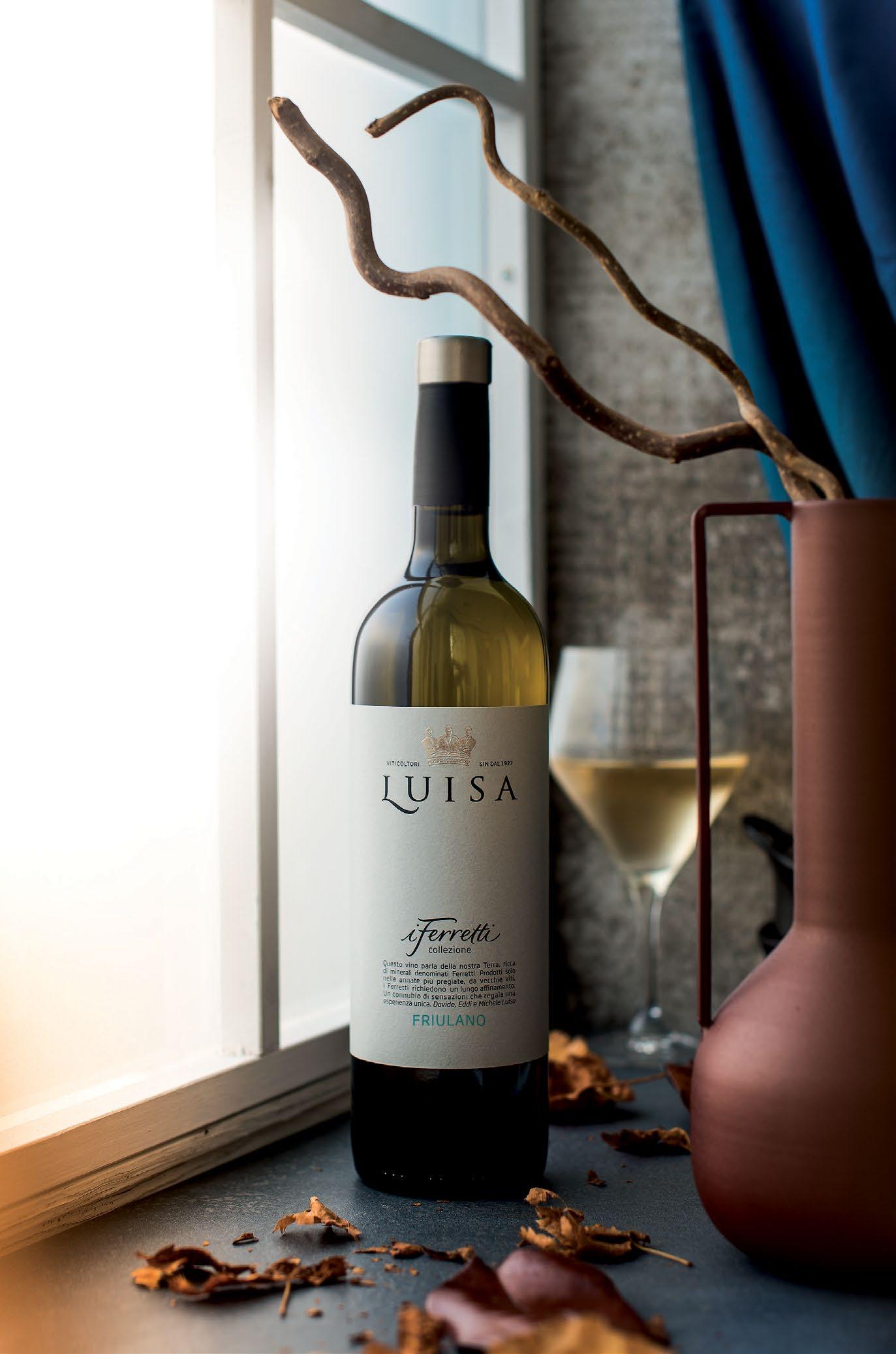

In the heart of the Cosenza Sila, the Campanaro family shop, Silafunghi, offers the best of the area in terms of cured meats, cheese and dairy products. You can buy them, taste them as an appetiser in the adjacent restaurant but also ask to combine them according to taste in sandwiches served hot or cold. The wood-fired bajked bread and "ammaccata" olives are excellent

 Il Chiosco di zio Tomas via Panoramica –3292026172
Il Chiosco di zio Tomas via Panoramica –3292026172
BORN IN Ragusa
RESTAURANT NAME
Fattoria delle Torri
RESTAURANT CONTACTS
Modica (RG)
vico Napolitano, 14 0932 751286
fattoriadelletorri.com
SOUS CHEF
Lavinia Grenga
AGE OF SOUS CHEF 29
KITCHEN BRIGADE
Maria Celestre
Elisabetta Amenta IN THE DINING ROOM
Paolo Monello
SOMMELIER
Carla Barone
ULTIMO ALBUM SCARICATO Isola by Lo Straqen
LATEST BOOK READ
Ti mangio con gli occhi
by Ferdinando SciannaOWNER PARTNER
EMPLOYEE SEATS 40
MOST LOVED INGREDIENT Cardamom
LEAST LOVED INGREDIENT Cocoa butter used as a crunchy outer shell
THE DISH OF A LIFETIME Chaufa de arroz (Cantonese style stir fried rice)
WORSHIPPED MAESTRO
My grandmother Ignazia (never met her) and my aunt Franca
MOST ESTEEMED PEER COLLEAGUE Stefano Zanini
RESIDENT IN Modica (RG)
PREVIOUSLY WORKED AT Signum a Salina (ME)
La Montecchia in Selvazzano Dentro (PD)
Combal.0 a Rivoli (TO)
Pocho in San Vito lo Capo (TP)
MY IDEA OF CUISINE
Sicilian, synergistic, sustainable and cross-pollinated; a Sicilian cuisine for the origin of the products used but constantly melded with the experiences that filter the world we observe
FAVOURITE RESTAURANT ABROAD
Merito in Lima (Perù)
THE WINE ABOVE ALL OTHERS
Litra 1996 by
Tenuta Sant'AnastasiaHAD I NOT BEEN A CHEF…
I chose this profession in full awareness and would continue to do so, however I would like to invest time in projects dedicated to children, whose sensitivity for food should be ingrained sooner
THE DISHES
Artichoke, sour cream and spiced coffee
Dolphinfish, pomegranate and chestnuts
Lamb innards gyoza, leek in Asian broth
Milk, bread and chocolate
by Clara Barra – photos by Federico Cannata

INGREDIENTS FOR 4
4 globe artichokes
1 litre sunflower seed oil
250 ml unsweetened cream
Lemon juice
Coffee powder
Powdered spices (cinnamon, ginger, nutmeg, cumin, cardamom etc.)
salt
pepper
Clean the artichokes by removing the more leathery outer leaves, the inner beard with a corer and the fibrous exterior of the stem. Fry each artichoke first in sunflower oil at 150°C to cook it and fry it again at 180°C until crisp.
Gradually add the lemon juice to the cream, stirring to obtain a thick and compact texture.
Serve each artichoke well seasoned, with the sour cream on the side and a sprinkling of coffee mixed with the powdered spices.
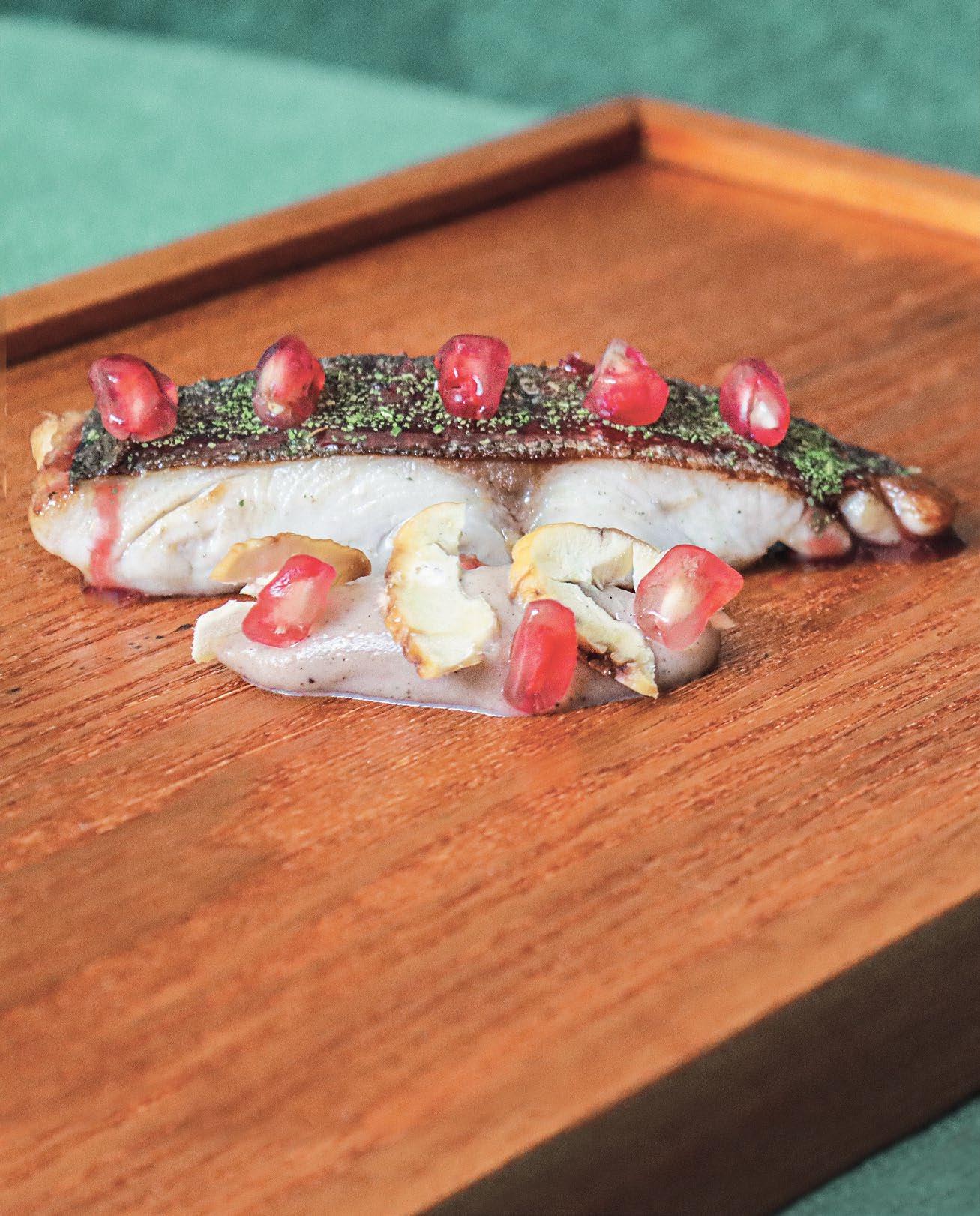
ingredienti for 4
1,2 l milk
520 g dolphinfish
20 chestnuts
12 sage leaves
4 garlic cloves, skins on
4 sprigs of thyme
4 sprigs of rosemary
2 glasses of red wine
The juice of 4 pomegranates
Pomegranate kernels
Extra virgin olive oil
salt
pepper
Gut, bone and fillet the dolphinfish, then place the slices in a container, cover them with the pomegranate juice and leave to marinate overnight. Make an X-shaped incision on the chestnuts, sprinkle them with red wine and bake at 210°C for 15 minutes in a fan-assisted oven. Once ready, peel them and put them in a saucepan together with the milk, rosemary, sage and garlic, then cook for 10 minutes over moderate heat. At this point, eliminate the aromatics and blend the chestnuts to obtain a smooth, homogeneous and not too thick cream. Season the puree with salt. Sear the 4 slices of dolphinfish only on the skin side, season and serve with the chestnut cream, a few pomegranate kernels and a sprig of fresh thyme.
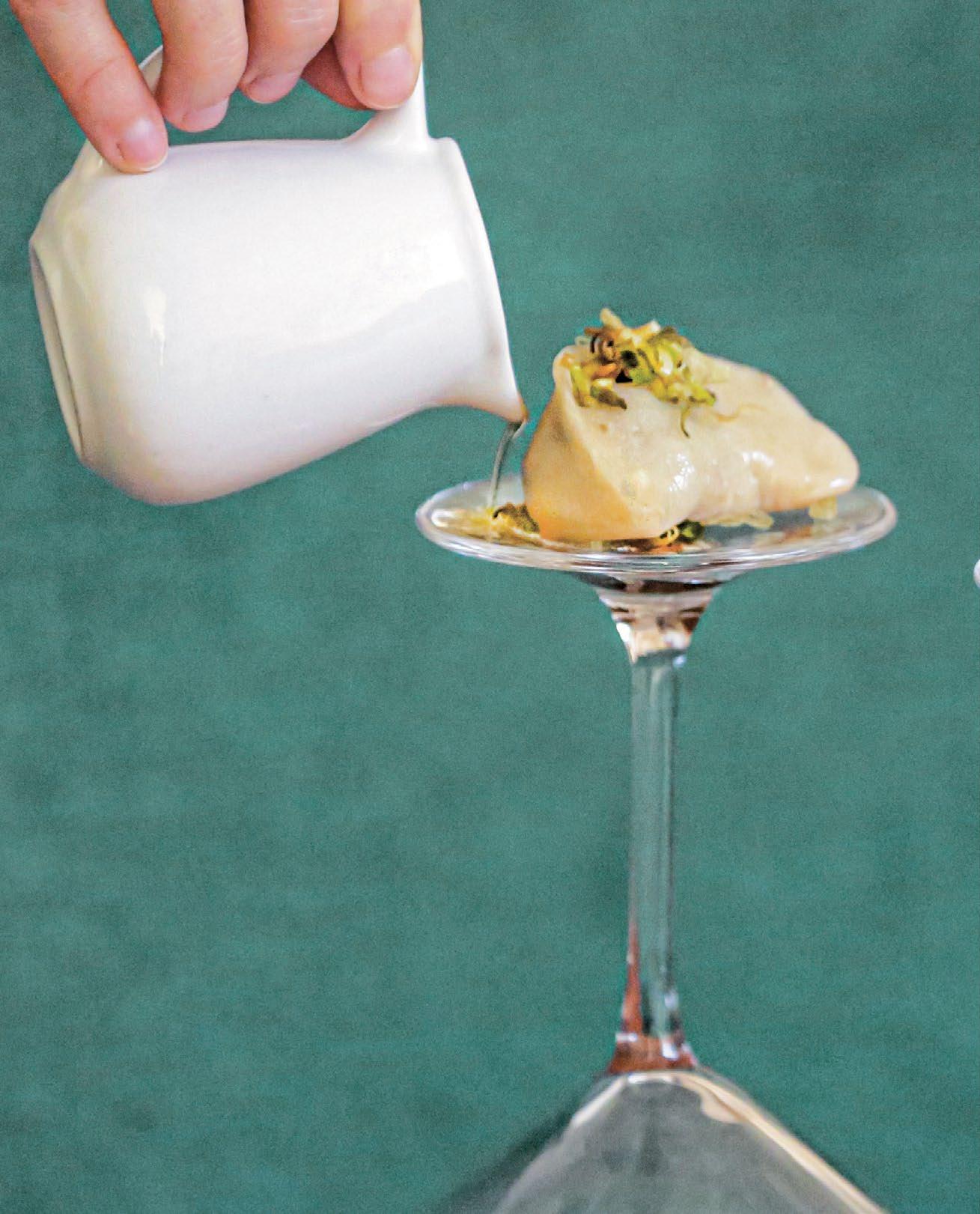
INGREDIENTS FOR 4
For the gyoza
500 g “0” type flour
250/300 g bottled water
For the filling:
600 g lamb innards (tripe, lung, liver, intestine)
400 g pork meat, ground 100 g fresh ginger root, peeled
2 garlic cloves
Fresh chilli
Beef broth
Extra virgin olive oil
vinegar
Coarse sea salt
Table salt
lemon
Bay leaf
pepper
For the broth:
2 l bottled water
50 g carrot
50 g celery
50 g golden onion

50 g leek
50 g fresh ginger root, peeled
25 g dried mushrooms
Peel of ½ lemon
Soy sauce
For the garnish: 100 g leek, fried
For the gyoza, mix the water with the 500 g of flour a little at a time, starting to knead vigorously (the absorption capacity depends on the type of flour used). Knead for at least 15 minutes. Set the obtained dough aside.
For the filling, rinse the innards with vinegar and coarse sea salt, boil them in water scented with a bay leaf, lemon and garlic, then blend to obtain a smooth texture. Add the ground pork, the chopped chilli pepper, garlic and ginger, pepper, salt, olive oil and some meat broth to soften the filling.
For the broth, finely chop all the vegetables and leave to infuse for 30 minutes in 2 liters of boiling water, together with the lemon peel and dried mushrooms. At this point, filter with a linen cloth and season with the soy sauce to taste. Roll out the dough with a rolling pin or a pasta machine, cut discs of the diameter you prefer, insert the filling and close in a half-moon shape and then crimp the edges with your thumbs and forefingers. Cook in boiling salted water and serve with the hot broth and the crispy fried leek. e il porro croccante, precedentemente fritto.
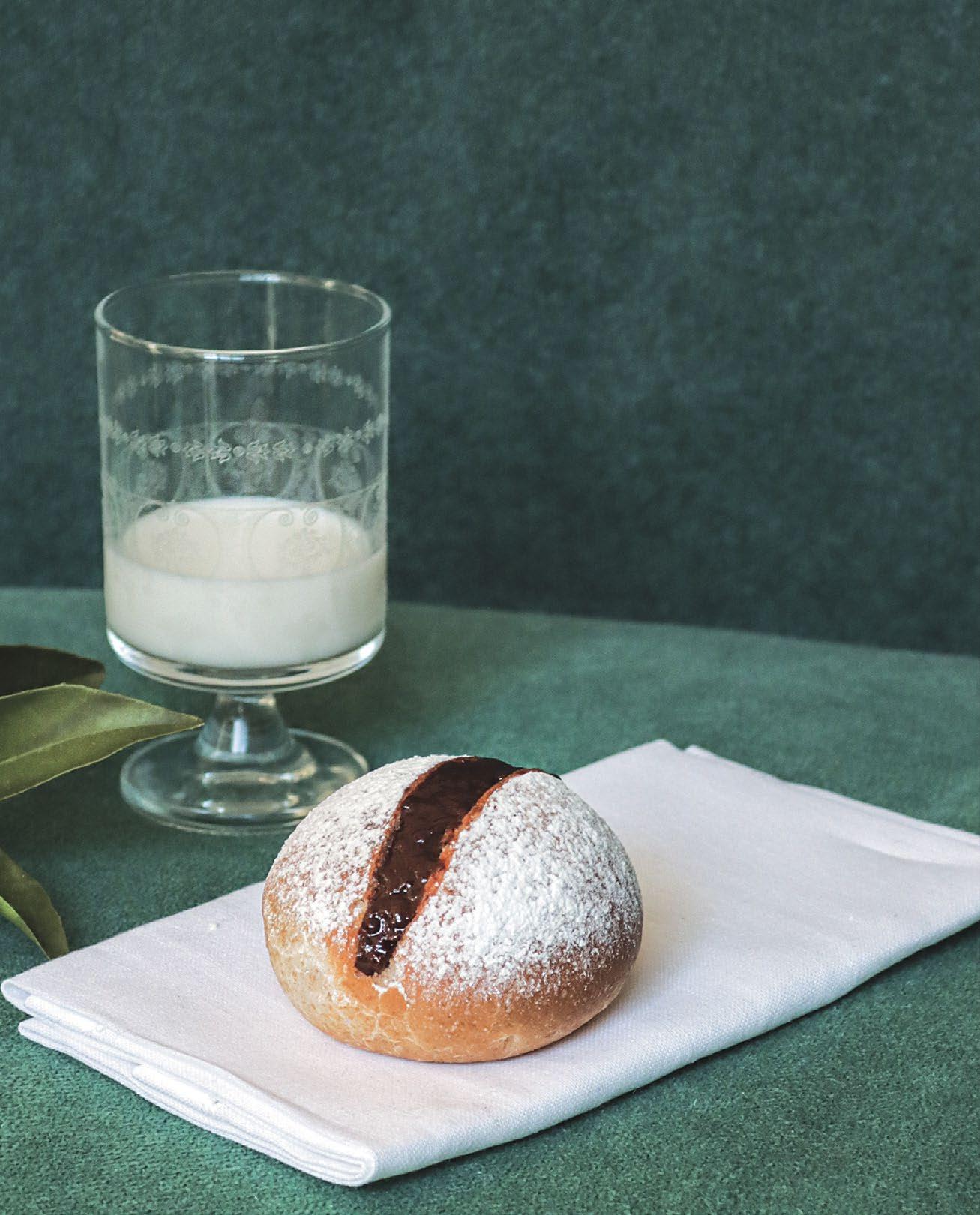
INGREDIENTS FOR 4
For the maritozzi : (quantities yield 12 pieces)
500 g strong flour
150 g whole milk
100 g sugar
100 g water
90 g butter
8 g brewer’s yeast (more effective for small-sized leavened products)
8 g salt
2 medium eggs
1 tsp. honey
Zest of 1 lemon
For the ganache:
400 g bitter cacao mass
200 g fresh cream
80 g panela sugar
Zest of 1 orange
For the milk soup:
500 ml goat milk
10/15 g cornstarch
marjoram
Mix 100 g of the flour, brewers yeast, 100 g of the water, 1 tsp sugar, then cover with plastic wrap and leave to rise until the volume of the dough doubles. In the stand mixer, add the remaining flour, sugar, milk, grated lemon peel, honey to the leavened mixture and mix using the leaf attachment. Add the eggs one at a time, the softened butter and mix until the dough comes together. Add the salt and continue to knead at medium speed. Pour the dough, soft and smooth, on the work surface and with floured hands perform a few folds and then fold it over itself. Wait for the volume to triple, then break the dough into balls of 80 g each and let it rise again. Once they have doubled their volume, bake at 180°C in a static oven for about 25 minutes.



GAMBERO ROSSO
www.gamberorosso.it
SENIOR EDITOR
Lorenzo Ruggeri
PHOTO EDITOR
Rossella Fantina
LAYOUT

Chiara Buosi, Maria Victoria Santiago
CONTRIBUTORS
Clara Barra, Michela Becchi, Cecilia Blengino, Maurizio Gaddi, Marco Sabellico, Massimiliano Rella, Marzio Taccetti
PHOTOGRAPHS AND DRAWINGS
Alfredo Del Bene, Federico Cannata, Massimiliano Rella
GR USA CORP PUBLISHER & PRESIDENT
Paolo Cuccia
Advertising Class Pubblicità SpA
Milano, Via Marco Burigozzo, 5 - tel. 02 58219522
For commercial enquiries: kanchieri@class.it
Advertising director
Paola Persi
email: ufficio.pubblicita@gamberorosso.it
Gambero Rosso and are registered trademarks belonging to Gambero Rosso S.p.A.
GAMBERO ROSSO is a Registered Trademark used under license by GR USA CORP Copyright by GAMBERO ROSSO S.P.A. 2023. All rights reserved. Nothing may be reprinted in whole or in part without written permission from the publisher.
GR USA CORP is not responsible for loss, damage, or any other injury as to unsolicited manuscripts, unsolicited artwork or any other unsolicited materials. january-february 2023
a www.gamberorossointernational.com ✉ international@gamberorosso.it f GamberoRossoInternational